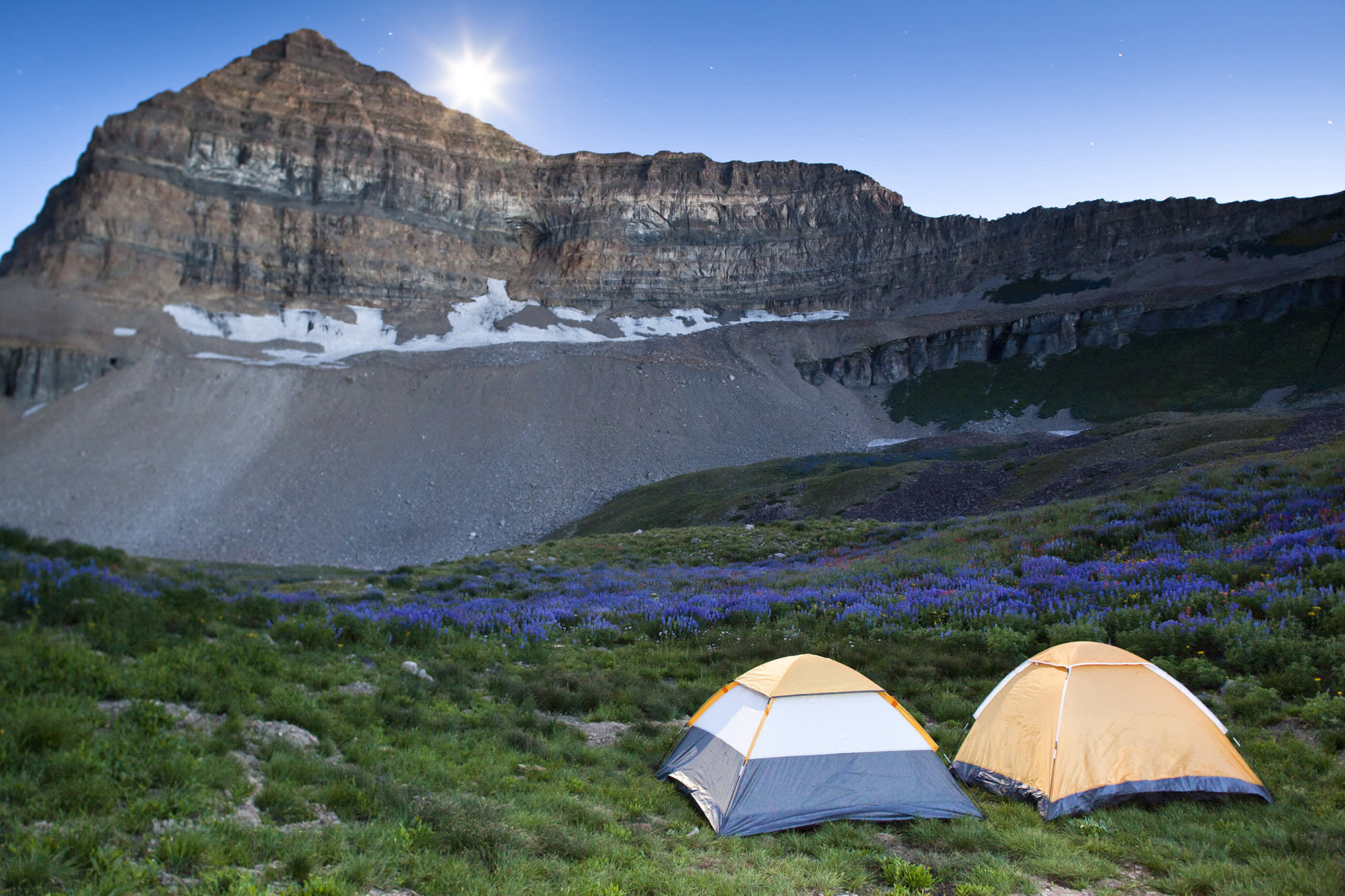

Top 5 Overnight Backpacking Trails in Utah
- Visit our facebook
- Visit our pinterest
There’s probably about 15,678 scientific research studies that prove that nature is the best medicine (Sorry, laughter. Nature might have you beat.) Life gets crazy busy, and the first thing to go is usually something that seems like too much planning and effort — don’t let backpacking slip through your keyboard-tired fingers. Go. Just go. Camping overnight is totally doable.
Also, LEAVE NO TRACE . When you head out anywhere, please, pretty, pretty, pretty please, try not to love these places to death. Here’s a quick list of seven LNT principles:
- Plan Ahead and Prepare: Know regulations, prepare for weather hazards, avoid high times of use, visit in small groups, use a map and don’t build cairns.
- Travel and Camp on Durable Surfaces: Established trails and campsites, rock, gravel, dry grasses or snow, camp at least 200 feet from lakes and streams, walk single file in the middle of the trail, keep campsites small.
- Dispose of Waste Properly: Pack it in, pack it out, deposit solid human waste in catholes 6-8 inches deep — 200 feet from water, pack out toilet paper and other hygiene products, wash dishes with biodegradable soap 200 feet from water.
- Leave What You Find: Do not touch or take cultural or historical artifacts, leave rocks and plants as you find them, do not build structures or dig trenches.
- Minimize Campfire Impacts: Use a lightweight stove for cooking, use fire rings where fires are permitted, keep fires small, only use sticks from the ground, burn all wood and coals to ash, put out fires completely, scatter cool ashes.
- Respect Wildlife: Observe wildlife from a distance, never feed animals, store rations and trash securely, control pets at all times.
- Be Considerate of Other Visitors: Be courteous, yield to other users on the trail, avoid loud voices and noises.
5. White Pine Lake
AREA: Greater Salt Lake | Little Cottonwood Canyon LENGTH: 5 miles to the lake ELEVATION GAIN: 2,696 feet DIFFICULTY: Strenuous
Thank you, Salt Lake City, for being born right next to some of the most magnificent mountains in the whole wide world. Because it takes just 30 minutes from downtown to get to the White Pine Trailhead. Perfect for an overnight getaway from the routine in our big little city.
The trail starts out wide and easy. The incline increases once you pass the river junction where you can either take a right to Red Pine Lake, or continue left up some switchbacks up to White Pine Lake. Steep enough to get your heart pumping, and a good excuse to stop and rest and hydrate.
The lake itself will give you an awe-some perspective. You’ll take in alpine scenery and majestic mountains. Read More...
4. Ibantik Lake
AREA: Uinta Mountains LENGTH: 4.2 miles to the lake ELEVATION GAIN: 590 feet DIFFICULTY: Moderate
The Uintas are less crowded, but take a little more time to get to from the big city.
The trailhead is located just off Mirror Lake Highway (east of Kamas). When you get to Trial Lake, exit west onto a paved road. You’ll drive for about a mile until you see a fork in the road, then turn north for another mile to get to the trailhead.
Enjoy passing lakes and smaller ponds on your way into Ibantik. Seriously, enjoy it.
3. Mount Timpanogos
AREA: Utah Valley | Provo or American Fork Canyon LENGTH: From Aspen Grove to Summit: 8 miles one way, Camp: ¾ way to Emerald Lake (6.5 miles to the lake) | From Timpooneke Road: Summit: 7.5 miles one way, Camp: just as you enter the basin at about 10,000 feet ELEVATION GAIN: 4,580 feet DIFFICULTY: Strenuous
Girls and boys start hiking this amazing peak around age ten. It’s strenuous, but doable. Either trail will take most of the day to hike in. Take advantage of grand view for photo ops and to catch your breath. Read More...
2. Zion National Park's West Rim Trail
AREA: Zion National Park LENGTH: 14.5 miles one way ELEVATION GAIN: 2,510 feet DIFFICULTY: Moderate
You’ll basically be absorbed into Zion’s sheer-cliff sandstone beauties, summit Angels Landing , and continue on to more undeniably gorgeous views. Your breath will catch over and over again as you come into contact with a grand western landscape. Read More...
1. Neon Canyon and Golden Cathedral
AREA: Grand Staircase-Escalante LENGTH: 9.2 miles ELEVATION GAIN: 1,260 feet DIFFICULTY: moderate
The Grand Staircase-Escalante National Monument is one of the nation’s remotest and interesting landscapes. Canyons, washes and epic night skies draw adventurers here with a magnetic pull no one can resist once they’ve been here for the first time. You’ll want to come back and explore until the day you die.
Neon Canyon and Golden Cathedral require some technical know-how and gear. You’ll need ropes for rappelling and, depending on the time of year, you might want dry suits. CHECK THE WEATHER REPORT when going into canyon country. Flash floods are for real, and they’re devastating. Read More...
Views like this delivered to your inbox
Categories:.
BACK TO TOP

10 Best Utah Backpacking Trips
Discover the best Utah backpacking trips across the state from easy but scenic one-night trips to multi-day backcountry adventures.

Although Utah is most famous for its “Mighty Five” National Parks (Arches, Canyonlands, Capitol Reef, Bryce, and Zion), more than 70% of the state is classified as public land from national monuments to recreation areas to national forests to BLM areas, and the opportunities for outdoor recreation are expansive.
If you’re ready to stretch your legs on some longer multi-day hikes, here are 10 of the best backpacking trips in Utah, ranging from incredibly beautiful overnights to challenging week-long trips.
This post may contain affiliate links.
Best Utah Backpacking Trips – Mapped
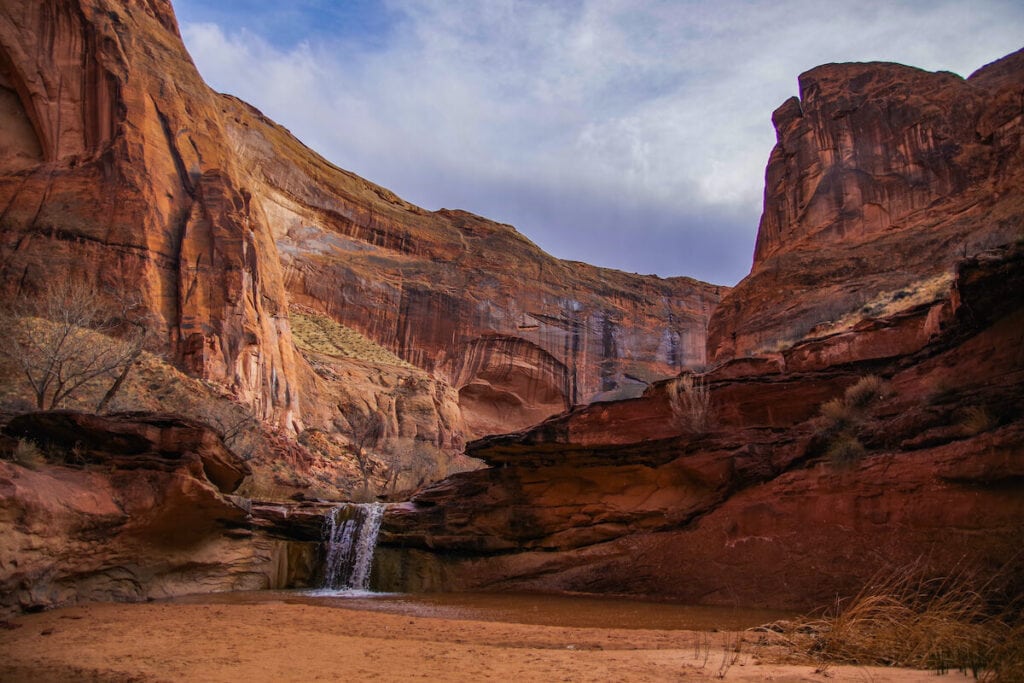
1. Coyote Gulch Loop
- Location: Glen Canyon National Recreation Area
- Trail Type: Loop
- Distance: 10.6 miles
- Suggested Time: 2 days, 1 night
- Difficulty: Hard
- Permit needed? Yes
- Best Seasons: Spring and fall
If you’re in the market for a relatively short but delectably sweet overnight hike, head to Coyote Gulch , which borders Glen Canyon National Recreation Area and Grand Staircase-Escalante National Monument.
This hike can be done in several variations, up to 22 miles in length, but this 10.6-mile loop hits many of the area’s highlights including two arches, a natural bridge, and numerous waterfalls.
First, stop at the Escalante Interagency Visitor Center in the town of Escalante to pick up your permit, inquire about road conditions and get the latest weather report.
The 10.6-mile loop is accessed by driving the notoriously rutted Hole in the Rock Road to the infamously sandy 40 Mile Ridge Trailhead. Depending on the road conditions, which change from year to year and season to season, you will likely need 4WD , especially for the deep sand on the last two miles to the trailhead. If your vehicle isn’t 4WD, you may be able to start the loop from the Hurricane Wash trailhead, 33.8 miles down Hole in the Rock Road.
Coyote Gulch’s biggest draw is the miracle of water in the desert. You’ll likely get your feet wet on this hike as the route follows and continuously crosses a perennial stream to its confluence with the Escalante River. Beware of flash flood danger in late summer and avoid this hike if thunderstorms are in the forecast.
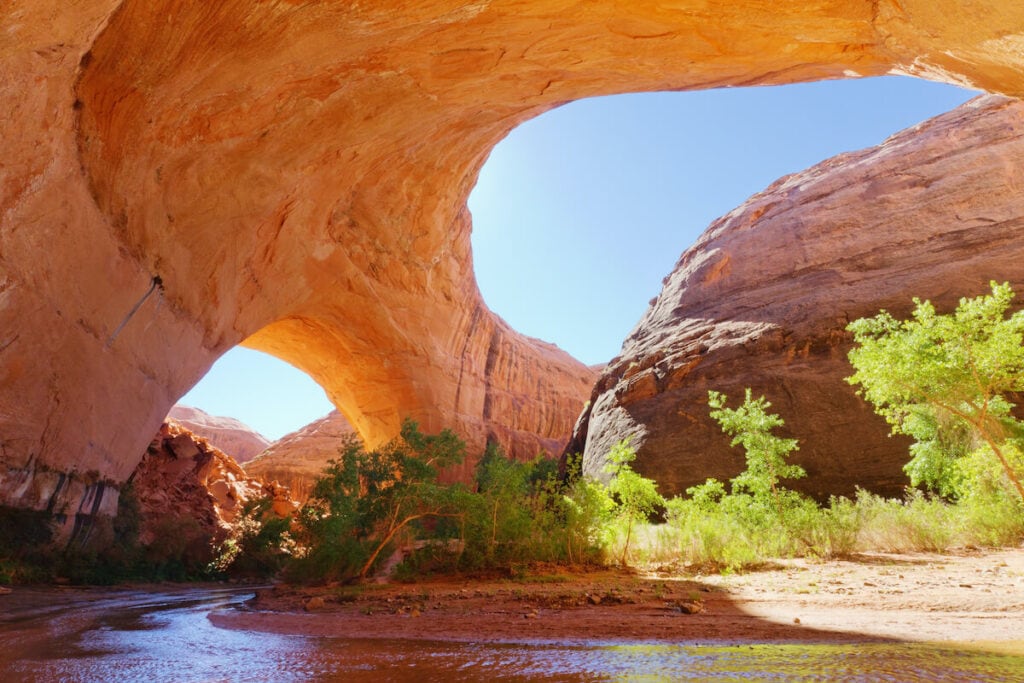
From the 40 Mile Ridge Trailhead, the first mile is a bit of a sandy slog but soon you’ll enter the Crack in the Wall, a tight 18-inch wide fissure that drops you off the edge of the mesa into the canyon.
Plan to bring a rope to lower your backpacks through this section. The best campsites are found between miles 4 and 5 and water is found throughout the canyon seeping from natural springs trickling out of the canyon walls.
To exit the canyon, you’ll need to tackle a short scramble up some ledges just past Jacob Hamblin Arch. Inexperienced hikers may find this section intimidating, but there are often fixed ropes here to help protect the climb but you may want to bring your own.
Read next: For a slightly longer one-way trail (vs. loop above), check out our Coyote Gulch Backpacking guide which covers the hike from Hurricane Wash to Crack in the Wall.
Planning information

2. Reflection Canyon
- Trail Type: Out and Back
- Distance: 15.2 miles
- Difficulty: Moderate
This adventurous overnight hike ends at one of the best sunset/sunrise spots in southern Utah, overlooking a uniquely squiggly arm of Lake Powell. This view of bright blue goosenecked bays bordered by towering Navajo sandstone cliffs was made famous by National Geographic and then Apple computers, which used an image of this vantage point in advertisements for the 2012 MacBook Pro.
You’ll need a reliable 4WD vehicle to drive the 50 miles of ruts and bumps down the Hole in the Rock Road to the trailhead. From there, you’ll need a strong sense of direction and a lot of water. There are no sources of water on this trek so you’ll need to carry enough for two days of strenuous hiking and a night of camping and cooking.
Before leaving Escalante, be sure to have the route downloaded on your favorite hiking app . Most of the route runs over slickrock and there’s no defined trail. Aim to follow the long line of cliffs on your right (west) as you hike south. If you stray too far east away from the cliffs you’ll end up in a maze of often impassable slot canyons.
About five miles from the trailhead, you’ll turn southeast to head towards the overlook. From here, you’ll be treated to magnificent views from sunset to stars to sunrise.
New to hiking in the desert?

3. Lower Hackberry Canyon
- Location: Grand Staircase-Escalante National Monument
- Distance: 12.4 miles
Travel back in time to visit a historic cabin and the beautiful Sam Pollack arch on this overnight trek into Lower Hackberry Canyon.
Located at the southern end of the Cockscomb, an imposing and colorful ridge of uplifted sandstone, Lower Hackberry Canyon winds into the heart of the comb, following a beautiful creek that runs most of the year.
About four miles into the hike, you’ll reach Frank Watson’s cabin. Built in 1914 using cottonwood logs harvested on-site, this one-room cabin was restored in 2021 and is an excellent example of a 100-year-old homestead.
Intrepid hikers may also want to seek out an even older abode in the nearby side canyon: a small food storage granary, some grinding stones, and an intriguing humanoid pictograph found nearby in a hidden alcove.
After exploring the cabin and the side canyon, hike another half mile north up Hackberry Canyon to the confluence with Sam Pollock Canyon where you’ll find some great tenting options under the cottonwood trees.
Following Sam Pollock Canyon to the northwest, in another 1.5 miles you’ll reach the spectacular Sam Pollock Arch.
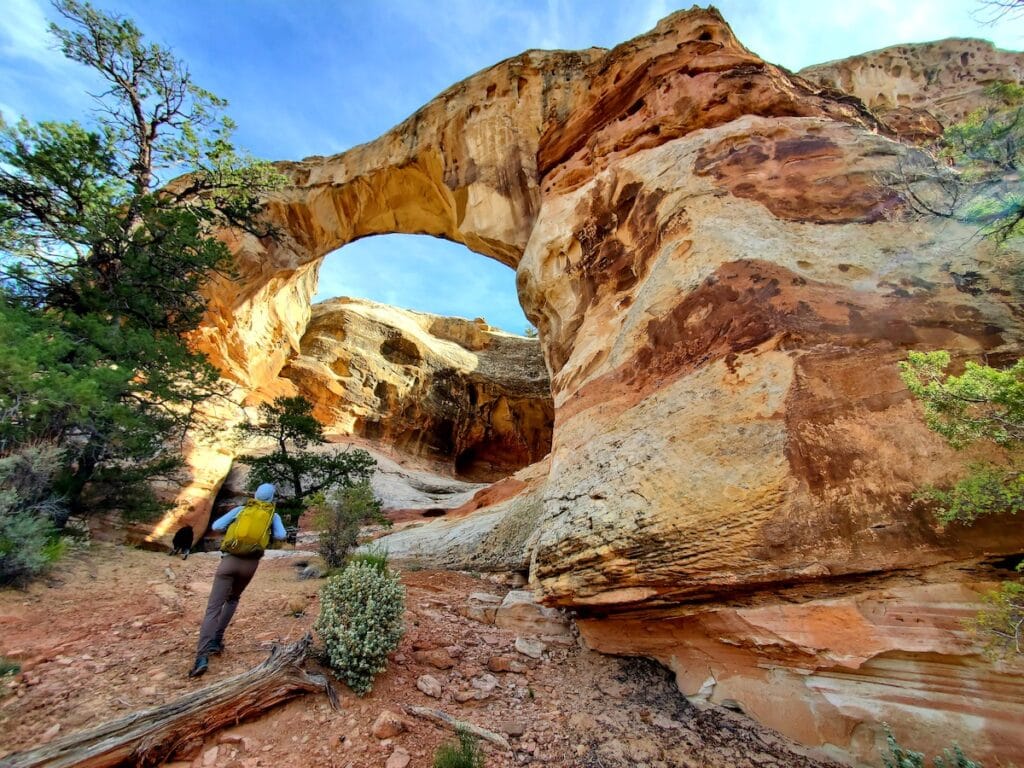
Read next: Heading to Kanab? Read our guide on the best things to do in Kanab, Utah to make the most of your visit.

4. Paria River to Lee’s Ferry and Buckskin Gulch
- Location: Paria Canyon-Vermilion Cliffs Wilderness Area
- Trail Type: Point to Point
- Distance: 40 miles
- Suggested Time: 4 days, 3 nights
- Permit needed? Yes (and they are competitive)
Get your fill of world-class slot canyons on this 40-mile route that starts in Utah and ends at the Colorado River in Arizona.
The Paria River is a major tributary of the Colorado, joining the Colorado River at Lee’s Ferry upstream of the Grand Canyon.
Along the way, you’ll spend two whole days in a narrow slot canyon with an optional side trip into Buckskin Gulch, one of the world’s longest continuous slots.
Permits for both the Paria and Buckskin Gulch are extremely competitive with only 20 people a day allowed into the Paria. See permit info below.
The Paria’s stunningly beautiful setting makes this a popular hike but it’s important to know that it is also extremely challenging . For much of the trek, you’ll be repeatedly crossing the creek and often wading in the water as well as dodging ubiquitous quicksand.

Spring and fall are the most desirable months but freezing water temperatures early and late season can make for miserable conditions.
In the summer, the canyon dries up and turns into a furnace while late summer monsoons can deliver deadly flash floods in these inescapable canyons.
If you manage to snag a permit during a good weather window when the Paria is running but not too high, you’ll be in for some of the most beautiful days of your life.
After leaving from the White House trailhead, the canyon begins narrowing down into its legendary slot, passing between towering red walls of Navajo sandstone.
Just after 7 miles, you’ll pass the confluence with Buckskin Gulch with a few campsites near the junction. A side trip up the narrow corridor of Buckskin Gulch is a must-do. This is one of the most beautiful and harrowing slot canyons on Earth!
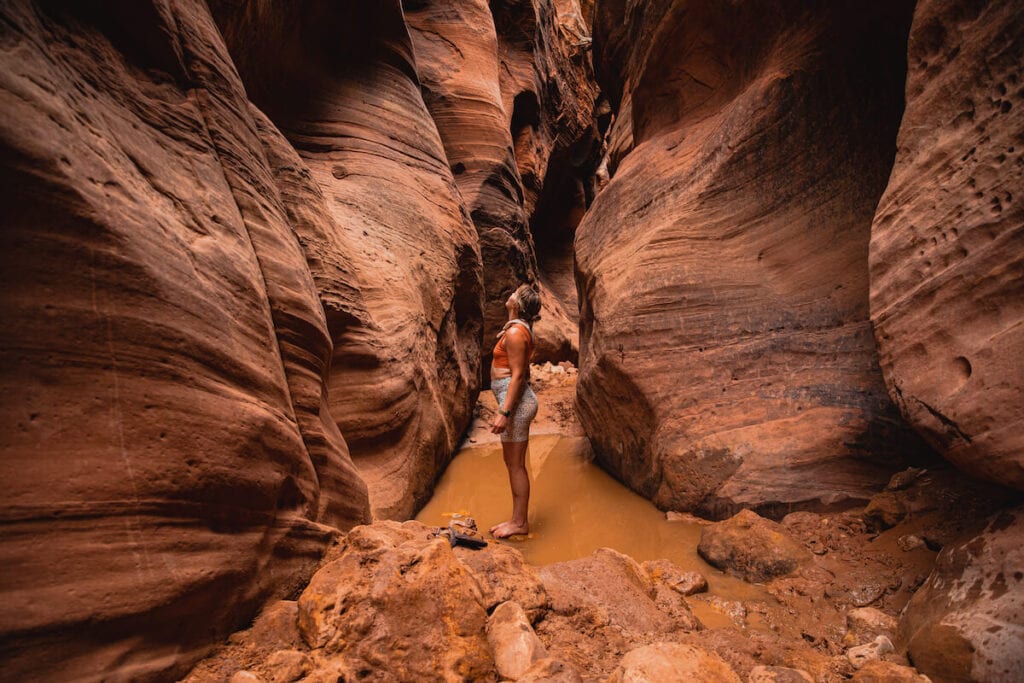
Back in the Paria, you’ll continue south, following the endless twists, turns, and meanders into the ever-deepening and narrowing slot. Keep your eyes out for springs seeping from the walls. These are your best water sources, as the Paria itself is usually too silty to filter.
After more than 30 miles in the narrows, the canyon widens as it approaches its mouth at the Colorado River. Here you’ll find Lee’s Ferry, a historic crossing of the Colorado that now serves as the put-in for rafting trips into the Grand Canyon.
Read next: Get more tips for planning your adventure with our Paria Canyon Backpacking guide (which skips the Buckskin Gulch section).

5. The Boulder Mail Trail
- Distance: 15 miles
- Suggested Time: 3 days, 2 nights
Until the 1930s, the remote town of Boulder, Utah received its mail by mule, transported via the Boulder Mail Trail. Running in a fairly straight line between Escalante and Boulder, the Mail Trail crosses three major canyons and a lot of slickrock.
With precipitous drop-offs and deep water sections, the route is not for the faint of heart and it’s a wonder that the postal mules regularly traversed it with few mishaps.
The Mail Trail can be hiked in either direction but since the Boulder trailhead is almost 1,000 feet higher in elevation than the Escalante trailhead, most people hike from east to west for a net downhill hike, ending in Escalante.
Most of the route is well-cairned but you’ll want to be familiar with navigating on slickrock and have the route downloaded on your favorite hiking app before you begin.
The three major canyons, from east to west, are Sand Creek, Death Hollow, and Mamie Creek, each with its own character.
Water is usually found in both Sand Creek and Death Hollow and less reliably in Mamie. Death Hollow is the deepest and arguably loveliest of the three canyons, requiring an 800-foot descent down through Navajo sandstone benches into the canyon.
In Death Hollow, you’ll likely get your feet wet as you follow the creek for about a mile. Avoid the brushy banks as they’re often rife with poison ivy. Also, flash floods are a real danger here so be sure to check the weather before you commit to this hike.
The slickrock climb out of Death Hollow is marked by cairns and is easy to miss. The other route continues downstream to where Death Hollow meets the Escalante River.
You’ll also cross a fourth, unnamed canyon before reaching the Escalante trailhead. In total you’ll gain and lose around 2,500 feet of elevation throughout the 15-mile trek, going from Boulder to Escalante.

6. Bullet Canyon to Grand Gulch
- Location: Bears Ears National Monument
- Distance: 20 miles
More than 1,000 years ago, this complex of deep serpentine canyons in what is now Bears Ears National Monument was a neighborhood inhabited by hundreds of people.
Many generations of families made a living here by growing food and hunting wild game and living in multi-roomed dwellings, often situated under overhanging cliffs. They also created art by painting and etching the walls of the canyon.
But as the climate became warmer and dryer, resources became scarcer and people began building defensive dwellings and food storage structures high on cliff ledges, reachable by only seemingly superhuman feats of athleticism and bravery. Around 700 years ago, people left the canyon, moving into larger Pueblo communities to the south and east.
Thousands of ancient dwellings are found throughout the Bears Ears region but Grand Gulch is famous for the density and preservation of sites. Today, Grand Gulch is preserved as an outdoor museum , with many artifacts and relics left in place.

All visitors to this fragile and sacred place must follow all Leave No Trace principles , as well as additional guidelines for visiting archaeological sites, including:
Permits for this trip, which follows Bullet Canyon to Grand Gulch to Kane Gulch, are competitive and all hikers, including day hikers, need to check in at the Kane Gulch Ranger Station before exploring the area.
Water remains scarce in these canyons so be sure to check with the rangers that springs are flowing or you may need to carry water for your entire trip.

7. Under the Rim Trail plus Rigg’s Spring Loop
- Location: Bryce Canyon National Park
- Distance: 31.8 miles
- Best Seasons: Late spring, summer, and fall
Bryce Canyon is one of the country’s smallest national parks, only covering 55 square miles of land. But what the pocket-sized park lacks in size it makes up for in scenery. It boasts an incredibly colorful hoodoo spire-studded amphitheater that has been scooped out of the high-elevation Paunsaugunt Plateau.
Bryce is famous for its awe-inspiring overlooks but backpackers can get to know the park’s hoodoos, windows, and slot canyons on a more intimate level on the Under the Rim Trail.

This 23-mile trail begins at Rainbow Point in the south and runs north to Bryce Point, skirting the forested base of the plateau’s eastern edge. For bonus miles, add on the 8.8-mile long Rigg’s Spring Loop at the start of your trek.
Park shuttles connect all of the overlooks, including Rainbow Point and Bryce Point, making for easy logistics at the start and end of your hike.
Bryce Canyon reaches elevations over 8,000 feet, keeping this park much cooler in the summer months than the rest of Utah’s red rock country, which is often too hot for summer exploration. But even with cooler temperatures, water is still scarce in the amphitheater. Always check with park rangers about water availability before beginning your trek.
Some hikers elect to leave a water cache at the junction of the Under the Rim trail and the Swamp Creek connector trail. Bottles must be labeled with the hiker’s name and permit dates and must be packed out at the end of your hike.
Read next: Looking to spend more time in Bryce National Park? Check out our complete guide for more tips on the best hikes, where to stay, and things to do.

8. West Rim Trail
- Location: Zion National Park
- Distance: 14.1 miles
- Permit needed? Yes (permits are competitive)
Take the scenic footpath route into Zion via the West Rim trail. This 14-mile route starts at Lava Point in the Kolob Canyons unit of Zion, northwest of the main part of the park.
Lava Point sits at nearly 8,000 feet of elevation, while Zion Canyon dips down to 4,000 feet, making this a net downhill hike.
For the first 6.5 miles, you’ll be treated to sweeping views of Wildcat Canyon and the West Rim of Zion before beginning your descent at Cabin Spring into Zion Canyon where you’ll end at the Grotto Picnic Area.
With a little planning and a lot of luck, you could also apply for a permit to hike Angel’s Landing, which you’ll pass on your way down into Zion. A new lottery system was implemented in 2023 to limit the number of hikers on the notoriously narrow route, but it’s worth trying for a permit since it’s a spectacular hike (if you don’t mind heights!)
The West Rim’s higher elevation makes this route possible during the hotter summer months, but you should be prepared to spend part of the day in the shade and hike in the cooler morning and evening hours.
There are nine designated campsites along this route and water is usually available from several springs and natural sources along the way but be sure to check availability before you start your hike.
Read next: Need help planning your trip? Check out our West Rim Trail Backpacking Guide and our general Zion National Park Guide .
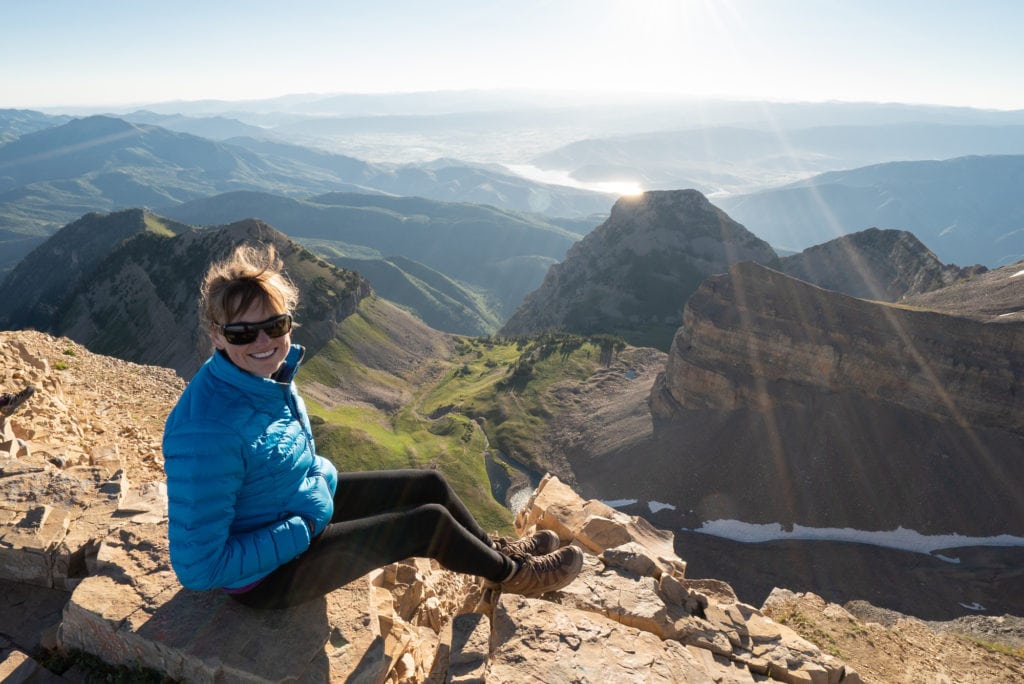
9. Mount Timpanogos
- Location: Uinta-Wasatch-Cache National Forest
- Distance: 14.3 miles
- Permit needed? No
- Best Seasons: Summer and early fall
Towering over the greater Salt Lake City metropolitan area, Mount Timpanogos , affectionately known as “Timp”, is the second-highest peak in the Wasatch Range, reaching 11,753 feet in elevation.
The 14.3-mile round trip hike to the summit gains over 4,400 feet of elevation and for many people, is best broken up into an overnight hike.
The trek begins at the Timpooneke trailhead, next to the Timpooneke campground, and follows the South Fork River past Scout Falls up into Timpanogos Basin. Most people elect to camp here, near Emerald Lake, and tackle the final climb up to the saddle and scramble along the windy ridge to the summit.
On top, you’ll be rewarded with unparalleled views of the Great Salt Lake Valley, Utah Lake and Provo Canyon. Mountain goats are often spotted on the surrounding cliffs and ridges.
Beware of lightning danger in the summer , though. It’s best to be off the summit by early afternoon to avoid thunderstorms.
This hike can also be done from the Aspen Grove Trailhead, which has a similar mileage and slightly more elevation gain, meeting the Timpooneke route near Emerald Lake.
Read next: 3-Day Backpacking Checklist
Read next: Read our Timopanogos trail guide for more tips on planning your hike.

10. Uinta Highline Trail
- Trail Type: High Uintas Wilderness
- Distance: 104 miles
- Suggested Time: 9 days, 8 nights
- Best Seasons: Summer
Utah’s most famous long-distance hike follows the crest of the Uinta Mountains, an east-to-west running mountain range in the northeast corner of the state. Along the way, you’ll tag King’s Peak, the highest point in Utah at 13,528 feet and known for being one of the most remote high points in the state.

The Highline Trai can be hiked in either direction, but most thru-hikers elect to go from east to west , starting at McKee Draw and ending at Hayden Pass near Mirror Lake.
The trail crosses eight named mountain passes, all over 11,200 feet of elevation, altogether gaining and losing over 16,000 feet of elevation.
Water abounds on this route and can be found in many small creeks and alpine lake basins and meadows. In between the passes, you’ll dip back into aspen groves and pine forests, which can give some cover during the afternoon thunderstorms that often roll across the mountains in late summer.
The hiking season can be short in the Uintas, especially in deep snow years when the passes may remain snow-covered until late July or August.
Utah is home to unlimited outdoor adventures. Here are a few more Utah blog posts to help you plan an epic trip to this incredible state:
- 9-Day Utah National Parks Itinerary
- Best Utah State Parks for Hiking and Camping
- Best Hikes in Utah: 20 epic trails
- Best Hikes Near Salt Lake City
Have you done any backpacking trips in Utah? What are your favorite trails and routes? Which of these are on your bucket list? Let us know in the comments!
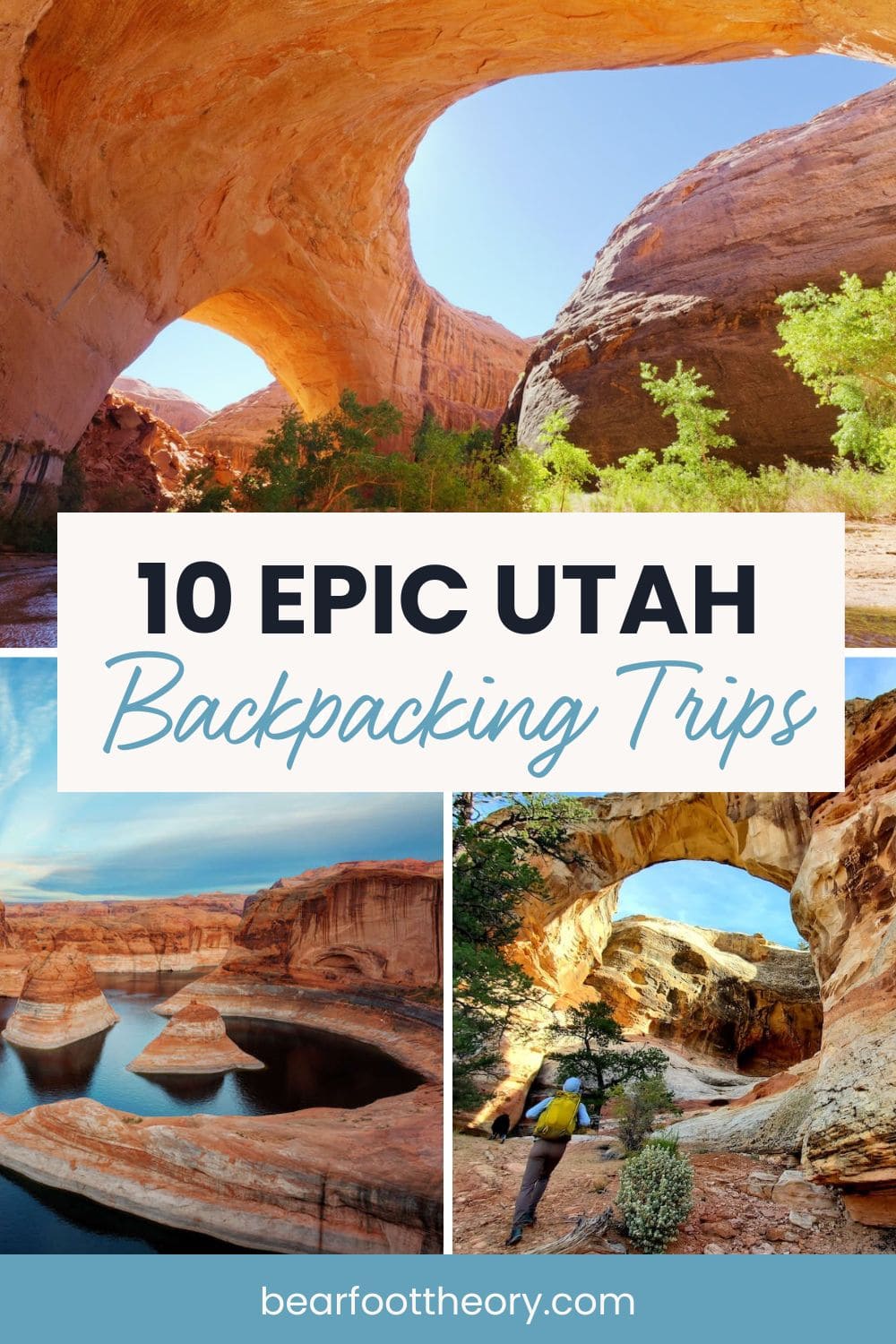
Mary is a freelance science and travel writer. For over a decade, Mary was a roving correspondent for EARTH magazine, where her favorite beat was the Travels in Geology column. She also founded the Living in Geologic Time column for Eos magazine and her work has appeared in Science News, High Country News, and the Guardian. She also writes the popular blog Travels with the Blonde Coyote, and is the author of Aerial Geology: A High-Altitude Tour of North America’s Spectacular Volcanoes, Canyons, Glaciers, Lakes, Craters and Peaks. In her 15 years as a North American road-warrior nomad, Mary has hiked in all 50 states and visited over 200 national parks. When she’s not at the keyboard she can usually be found outside—hiking, skiing, climbing mountains, and taking photographs.
Leave a Reply Cancel reply
Your email address will not be published. Required fields are marked *
Save my name, email, and website in this browser for the next time I comment.
Daniel Prescott

6 Unforgettable Utah Backpacking Trips for Adventure Seekers
Utah should be on every backpacker’s bucket list! Exploring Utah’s backcountry presents many landscapes, from the magnificent arches of the south to the wild and untamed regions in the north – providing something for every intrepid explorer. From southern Utah’s unique arch formations to northern Utah’s rugged terrain, there is something for every outdoor enthusiast.
This blog post will present six of Utah’s most remarkable backpacking experiences. There is no question that Utah is a top destination for backpackers seeking adventure. The desert climate hosts dunes, red cliffs, monumental arches, and more!
Explore these incredible Utah backpacking trips with us, and be ready to marvel at the majestic beauty of nature!
Epic Utah Arches
Which utah arch should you visit.
Utah is home to some of the most stunning natural features in the United States. The monumental arches of Utah are epic, grand, and awe-inspiring. The arches tower above you and create a frame for the art that is nature. Prioritize the majestic arches of Utah.
#1 Arches National Park
The national park with lots (and lots) of arches.
Arches National Park hosts many stunning vistas. The arches were formed by erosion over many years. More information on the formation of the arches are here (nps.gov) . If I could only pick one arch, I would return to Delicate Arch. The trail is only 3 miles round trip and climbs 480 ft. So, is it worth it? Yes, the small trek to the delicate arch is worth the view. It is the most popular hike for a reason for a few reasons:
- You can Get up close and personal
- The height of the arch is stunning! Being so close to such a beautiful and monumental rock is outstanding.
- The hike is short and moderate. You can expect to reach the top if your family is in average shape.
Delicate Arch FAQs
Is the hike to delicate arch hard.
The hike to the delicate arch is a moderate 3-mile round-trip hike. Average fitness will suffice. It starts easy, then progresses with some steep sections. Overall you will climb 480 ft.
Is Delicate Arch Worth it?
Delicate Arch is THE ICON of Utah and completely worth the trip.
Can You Hike Delicate Arch Right Now?
Delicate Arch Trail is open year-round but can get icy in the winter, so plan accordingly. Arches national park is busiest between March and October, so plan a visit in late February or other slower months.
Do You Need a Permit to Hike Delicate Arch?
Yes, Arches National Park requires a permit. Check out the official National Park website for information on permits.
How Long Does Delicate Arch Hike Take?
Delicate Arch Hike at Arches National Park takes 2-3 hours, including time to admire the arch.
Has Anyone Ever Fell at Delicate Arch?
Delicate Arch is safe, but take caution since there are cliffs. In 2019, two hikers fell near Delicate Arch. To read more about the incident, click here .
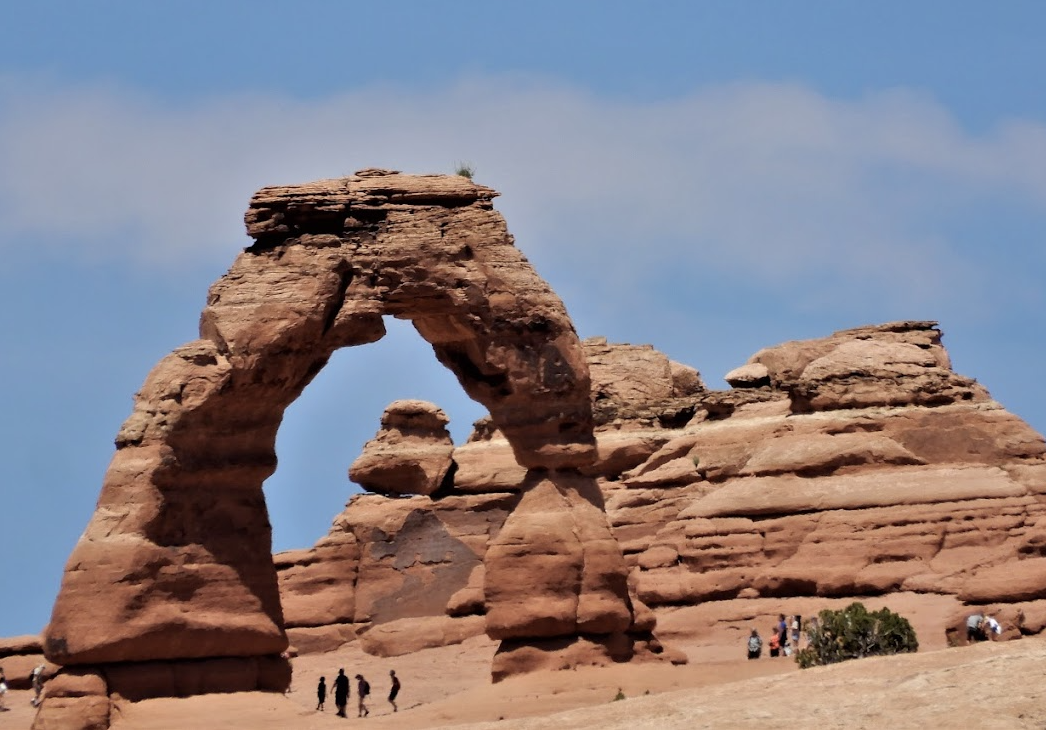
Discovering More Unique Arch Formations
The main highlight of this epic Utah backpacking trip lies within its unique arch formations – an awe-inspiring testament to nature’s artistic capabilities. As you trek through this diverse landscape, keep an eye out for the following:
Utah is famous for its breathtaking arch formations, particularly in its national parks. Some of the most stunning arches you can find in Utah include many from Arches National Park:
1. Landscape Arch (Arches National Park): Landscape Arch is known for its incredible length, making it one of the most extended natural arches in the world. It’s located in Devil’s Garden and is a popular visitor hike.
2. Double Arch (Arches National Park): As the name suggests, Double Arch is formed by two arches with a common rock foundation. It’s a unique and beautiful sight, and you might recognize it from its appearance in movies like “Indiana Jones and the Last Crusade.”
3. Corona Arch: Also known as Little Rainbow Bridge, Corona Arch is located along the Colorado River near Moab. It’s a short hike to the arch, and the stunning red rock surroundings make it a popular spot for adventure seekers.
4. Rainbow Bridge National Monument: While not in Utah’s national parks, Rainbow Bridge is still worth mentioning. It’s one of the largest natural bridges in the world and is sacred to Native American cultures. You can visit it by boat or by hiking.
5. Kolob Arch (Zion National Park): While many of Utah’s famous arches are found in Arches National Park, Zion National Park has an impressive arch. Kolob Arch is one of the world’s most prominent natural arches, and while it requires a strenuous hike to reach it, the experience is rewarding.
6. Windows Section (Arches National Park): This area of Arches National Park is home to several magnificent arches, including North Window, South Window, and Turret Arch. The windows frame stunning views of the surrounding landscape.

Exploring the rugged terrain of Utah’s backcountry is an incredible experience, and with Lower Hackberry Canyon Adventure, you can take your adventure to a whole new level. Discovering unique arch formations along Hole in the Rock Road will surely provide unforgettable memories.
#2 Canyons in Utah
Lower hackberry canyon vs. the narrows at zion national park.
Embark on an unforgettable overnight backpacking trip into Lower Hackberry Canyon that starts in Utah and ends at the Colorado River. Experience world-class slot canyons and breathtaking scenery, and consider taking an optional side trip into Buckskin Gulch for even more awe-inspiring landscapes.
Exploring Lower Hackberry Canyon’s Slot Canyons
The journey through Lower Hackberry Canyon is a true adventure as you navigate its narrow passages and towering sandstone walls. These stunning slot canyons are formed by water erosion over millions of years, creating unique patterns and textures that will leave you in awe.
Optional Detour to Buckskin Gulch
If you’re up for adding extra mileage to your trek through Lower Hackberry Canyon, consider detouring into Buckskin Gulch – one of North America’s longest and deepest slot canyons. This challenging yet rewarding side trip will take you through even narrower passages with sheer cliffs reaching 500 feet or more. To access this incredible destination from Lower Hackberry Canyon Trailhead (map link here), follow Wire Pass Trail, which connects these spectacular areas.
- Note: Hiking through Buckskin Gulch requires advanced navigation skills due to potential flash flood risks; always check weather conditions before venturing inside any slot canyon.
- Permits: A day-use permit is required for both Lower Hackberry Canyon and Buckskin Gulch. Overnight permits are also available if you plan to extend your adventure. To get your permit and more information regarding permits, check out the Bureau of Land Management website .
In conclusion, a backpacking trip through Lower Hackberry Canyon offers an unparalleled opportunity to explore Utah’s most remarkable slot canyons and immerse yourself in its rugged beauty. Whether you stick with the main route or venture into Buckskin Gulch, this unforgettable journey will leave you with memories that last a lifetime.
Lower Hackberry Canyon Adventure was an unforgettable experience with its stunning slot canyons and optional detour to Buckskin Gulch. Next, we will explore Paria Canyon’s depths, where hikers can test their skills while adhering to Leave No Trace principles in Death Hollow.
The Depths of Paria Canyon
Embark on a journey through the mesmerizing Paria Canyon , a complex network of three significant canyons, with Death Hollow being its deepest and arguably most beautiful section. Remember to follow Leave No Trace principles when exploring this pristine wilderness area, as preserving these stunning landscapes for future generations is essential.
Hiking through Death Hollow
Death Hollow offers an unparalleled hiking experience in Utah’s canyon country. The trail takes you along towering sandstone walls, narrow slot sections, and crystal-clear streams that meander through the canyon floor. As you traverse the canyon, take in the sights of vibrant foliage, fascinating rock formations, and potential wildlife sightings like deer or bighorn sheep.
Wear appropriate footwear with good traction to make your hike more enjoyable and safe since navigating wet rocks can sometimes be slippery. Also, carry plenty of water and snacks for energy during your trek – Paria Canyon has no facilities.
Leave No Trace Principles in Action
- Plan: Obtain necessary permits from the Bureau of Land Management (BLM) before embarking on your adventure into Paria Canyon.
- Camp responsibly: Set up camp at least 200 feet away from rivers or lakeshores to protect fragile ecosystems. Use existing campsites whenever possible instead of creating new ones.
- Pack out all trash: Carry a resealable bag for collecting any waste generated during your trip – including food scraps like fruit peels or nutshells.
- Leave what you find: Do not pick up or disturb any natural features, such as rocks, plants, or wildlife. Let others enjoy the beauty of Paria Canyon just as you have.
- Minimize campfire impact: Use a portable stove for cooking instead of making an open fire. If fires are allowed in your area, and you choose to make one, keep it small and use established fire rings when available.
- Treat water properly: Filter or purify all drinking water taken from streams to avoid contaminating yourself with harmful bacteria or parasites that may be present in untreated sources.
Incorporating these Leave No Trace principles into your backpacking trip will ensure that Paria Canyon remains a breathtaking destination for years. By respecting the environment and practicing responsible outdoor ethics, we can all do our part in preserving Utah’s stunning canyon landscapes for future generations of adventurers to explore and appreciate.
The depths of Paria Canyon provide a thrilling and unique experience for hikers, allowing them to explore the canyon’s secrets with an appreciation for its beauty. The following heading takes us on an adventure through Bryce Canyon National Park, where we can marvel at the colorful hoodoos that dot this stunning landscape.
Colorful Hoodoos at Bryce Canyon National Park
Despite being one of America’s smallest national parks, Bryce Canyon National Park offers incredible views of colorful hoodoo spires within its amphitheater-like landscape. Backpackers will be captivated by these unique geological formations throughout their journey.
Traversing Bryce Amphitheater Trails
The best way to explore the stunning hoodoos and immerse yourself in the park’s beauty is by traversing the numerous trails that wind through the Bryce Amphitheater. Popular routes include:
- Navajo Loop Trail: A short but steep 1.4-mile loop that descends into Wall Street, a narrow slot canyon flanked by towering cliffs.
- Fairyland Loop Trail: An 8-mile hike offering sweeping views of Boat Mesa and Fairyland Point while passing through a labyrinth of multicolored hoodoos.
- Rim Trail: A relatively flat trail stretching over five miles along the rim of Bryce Amphitheater, providing panoramic vistas across the entire park.
Understanding Hoodoo Geology
Hoodoos are tall and thin rock spires formed over millions of years due to water, ice, and wind erosion. The vibrant colors in Bryce Canyon result from different minerals in each layer; iron oxide gives red hues, while manganese imparts purplish tones. Consider joining a ranger-led tour or visiting the park’s visitor center to gain more insight into Bryce Canyon National Park’s impressive geology.
In addition to its geological wonders, Bryce Canyon National Park is home to diverse flora and fauna. Keep an eye out for mule deer, prairie dogs, and over 170 species of birds as you explore this remarkable landscape. With its otherworldly beauty and unique hiking opportunities, it’s no wonder that Bryce Canyon is a must-see destination on any Utah backpacking trip.
Exploring the colorful hoodoos of Bryce Canyon National Park is an experience that will leave you in awe. Next, take on a challenge and conquer Mount Timpanogos with its challenging trails and breathtaking views from the summit.
Conquering Mount Timpanogos
As the second-highest peak in the Wasatch Range at 11,753 feet elevation, Mount Timpanogos provides backpackers with challenge and reward as they summit this iconic mountain while enjoying panoramic vistas across Utah Valley below. This section will discuss ascending Timpanogos’ challenging trails and soaking in breathtaking views from the summit.
Ascending Timpanogos’ Challenging Trails
The journey to conquer Mount Timpanogos begins by choosing one of two popular trailheads: Aspen Grove or Timpooneke. Both routes are strenuous but rewarding hikes that cover a distance of approximately 14-15 miles round trip with an elevation gain of over 4,500 feet. The Aspen Grove Trail, known as the Primrose Cirque route, offers stunning waterfalls and wildflower meadows. On the other hand, hikers who opt for the slightly longer Timpooneke Trail can expect equally captivating scenery featuring lush forests and alpine lakes.
- TIP: Pack plenty of water and snacks for energy replenishment during your ascent.
- TIP: Always check weather conditions before hiking; afternoon thunderstorms are common during summer.
- TIP: Obtain a wilderness permit (free) at either trailhead’s self-issue station for overnight stays in the Mount Timpanogos Wilderness Area.
Enjoying Breathtaking Views from the Summit
Upon reaching the summit of Mount Timpanogos, backpackers are rewarded with unparalleled views of Utah Valley and its surrounding mountain ranges. On a clear day, you can even catch glimpses of distant landmarks such as Bryce Canyon National Park and Zion National Park. While at the top, remember to explore Timp’s famous glacier – one of the few remaining permanent snowfields in Utah – which is nestled within a cirque just below the summit.
In addition to awe-inspiring vistas, hikers may encounter diverse wildlife during their trek up Mount Timpanogos. Watch for Rocky Mountain goats that often graze near Emerald Lake or traverse steep cliffsides along your route. Birdwatchers will delight in spotting golden eagles soaring above while peregrine falcons dive through rocky crags hunting prey.
No matter the season or route, summiting Timpanogos will be a remarkable journey with stunning sights and incredible achievements.
Conquering Mount Timpanogos is an undertaking that necessitates a blend of physical and mental toughness. However, the Highline Trail Expedition provides unique challenges with mountain passes that require proper planning and preparation.
The Highline Trail Expedition
Embark on the classic Utah backpacking trip, the Highline Trail, a challenging yet rewarding multi-day adventure that takes you through diverse landscapes and eight mountain passes. This unforgettable journey can be hiked in either direction, offering flexibility for planning your route and itinerary. With awe-inspiring scenery around every bend, this expedition is perfect for those seeking physical challenge and natural beauty.
Tackling the Highline Trail’s Mountain Passes
The Uinta Mountains are home to the Highline Trail, a 75-mile route boasting eight mountain passes ranging from 10K to 12K feet in elevation. As you traverse these high-altitude terrains, expect steep climbs and descents that will test your endurance and stamina. Some of the notable passes include:
- Rocky Sea Pass: At 11,250 feet, this pass offers stunning views of surrounding peaks.
- Dead Horse Pass: Known for its steep ascent and dramatic cliff drop-offs, not recommended for those who fear heights.
- Tungsten Pass: A relatively more straightforward pass at an elevation of 10,500 feet but still provides breathtaking panoramas.
In addition to these impressive mountain passes, Uinta-Wasatch-Cache National Forest ‘s pristine lakeshores offer opportunities to restock water supplies or even take a refreshing dip after a long day’s hike.
Planning Your Route and Itinerary
To make the most out of your Highline Trail experience, carefully planning your route and itinerary is essential. Here are some tips for a successful backpacking trip:
- Choose Your Direction: The Highline Trail can be hiked from east to west or vice versa, depending on your preference. East-to-west is generally considered more challenging due to the higher elevation gains early in the hike.
- Allocate Time Wisely: Plan for at least 5-7 days of hiking, allowing Time for rest and exploration. Experienced hikers may complete the trail faster, but take your time – to enjoy this unique wilderness experience.
- Pack Lightly But Smartly: Bring only what you need while ensuring that you have adequate clothing layers, food supplies, water filtration systems, and navigation tools such as maps or GPS devices.
- Bear Safety Precautions: As black bears inhabit this area, bear safety precautions , including food storage techniques like using bear-resistant containers, or hanging bags high above ground level, should be followed.
The Highline Trail offers an unforgettable adventure through Utah’s diverse landscapes with its rugged mountain passes and breathtaking vistas. With careful planning and preparation, you’ll conquer this iconic trek while creating memories that will last a lifetime.
FAQs about Utah Backpacking Trips
When should i backpack in utah.
The best time to backpack in Utah is in spring (April-May) and fall (September-October) when temperatures are mild, and trails are less crowded. Summer can be sweltering, while winter brings snow and ice, making some courses inaccessible. Please always check weather conditions before you’re on your trip.
What Are the Longest Backpacking Trails in Utah?
The longest backpacking trails in Utah include the Highline Trail (78 miles), Hayduke Trail (800 miles), Great Western Trail (~1,600 miles), and Uinta Highline Trail (~104 miles). These long-distance routes offer diverse landscapes and challenges for experienced hikers seeking extended adventures. VisitUtah provides more information on these epic treks.
What Is a Reasonable Backpacking Distance?
A reasonable daily backpacking distance depends on terrain difficulty, elevation gain or loss, individual level, pack weight carried, and personal preferences. Generally speaking, 8-12 miles per day is considered an average pace for most hikers; however, this may vary based on experience levels or trail conditions.
How Many Clothes Do I Need for a 3-Day Backpacking Trip?
You’ll want to pack light but versatile clothing options for a 3-day trip: one pair of hiking pants/shorts convertible with zip-off legs; two moisture-wicking shirts; one insulating layer like a fleece or down jacket; three pairs of socks; underwear appropriate to your needs; hat/cap/bandana/headband depending on climate/weather conditions.
In conclusion, Utah offers a variety of backpacking trips for all levels of hikers. There is something for everyone, from exploring unique arch formations to ascending challenging trails. Planning your route and itinerary ahead of time is essential while practicing Leave No Trace principles and understanding the area’s geology.
If you’re looking for an unforgettable adventure in Utah Backpacking Trips, consider booking with Project today. Our experienced guides will lead you on a trip combining breathtaking views with physical challenges, leaving you feeling accomplished and rejuvenated—book now at https://danielprescott.com/ .
Similar Posts

Alternatives to the Traeger Grill: 5 Grills That Will Fit Your Budget
Regarding backyard grilling and smoking, the Traeger brand is synonymous with top-tier performance at an equally high price. But don’t worry – there are options if you’re after that same quality without breaking the bank! After days of digging through reviews and conducting research, I’m pleased to present my picks for the best alternatives on…

Backpacking in Hawaii: Uncover Island Adventures!
Uncover the adventure of backpacking in Hawaii! This guide offers essential tips on budget-friendly trips, packing lists, and top island trails. Dive in!

Discover the Best Dirt Bike Helmet for Safety in 2023
Explore the best dirt bike helmet for 2023! Our guide reviews top helmets, offering superior protection and comfort. Keep your ride safe and thrilling!

Unlock the Benefits of a Portable Propane Fire Pit
Discover the convenience and safety of a Portable Propane Fire Pit. Learn how to choose, set up, and use one safely for your next outdoor adventure.

Best Mountain Bikes: A Comprehensive Guide for Enthusiasts
Best Mountain Bikes – or “Best MTB,” a term that sparks excitement among biking enthusiasts. Finding the perfect mountain bike can be as thrilling as conquering rocky terrains and steep hillsides. Navigating through countless options, intricate designs, advanced technology features… it’s enough to make your head spin! But here’s the deal: understanding what makes the…

The BEST 11 Backpacks on the Market for Your Hiking Trip
Explore The BEST 11 Backpacks for Your Next Hiking Trip, featuring top brands and styles perfect for any adventure, from day hikes to long treks.
You are using an outdated browser. Please upgrade your browser or activate Google Chrome Frame to improve your experience.

- Trip Styles
- Destinations
- Guided Utah Backpacking Trips

Utah Backpacking Tours
Make the most of a visit to Utah on an all-inclusive backpacking adventure!
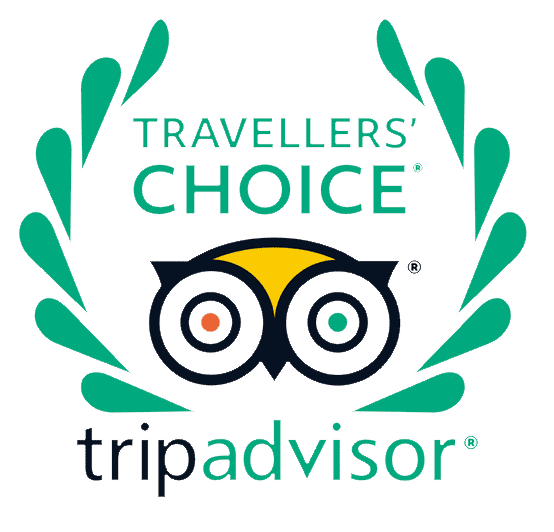
Check out our list of Utah backpacking tour options and give us a call at 1-800-715-HIKE (4453) to request more information or reserve a spot!
Utah Backpacking TOURS
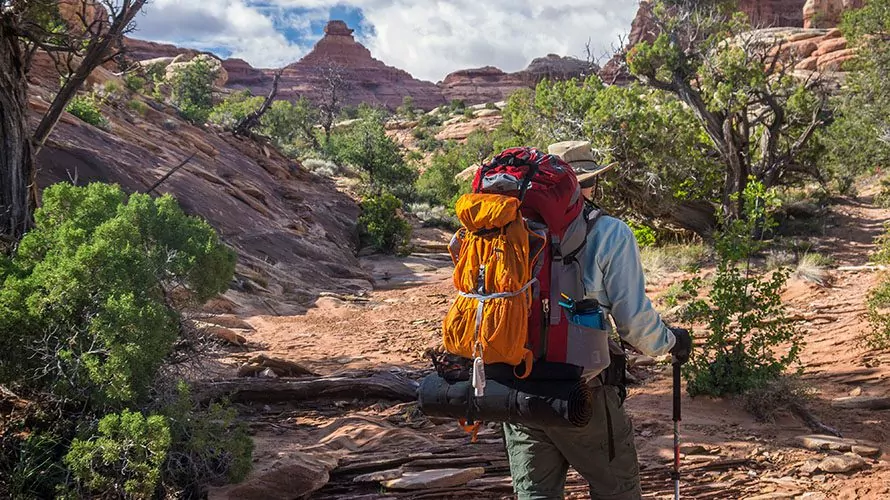
Ancient Canyonlands Traverse
Boulder Mountain Backpacking Adventure
Slot Canyons Traverse
Canyonlands Classic
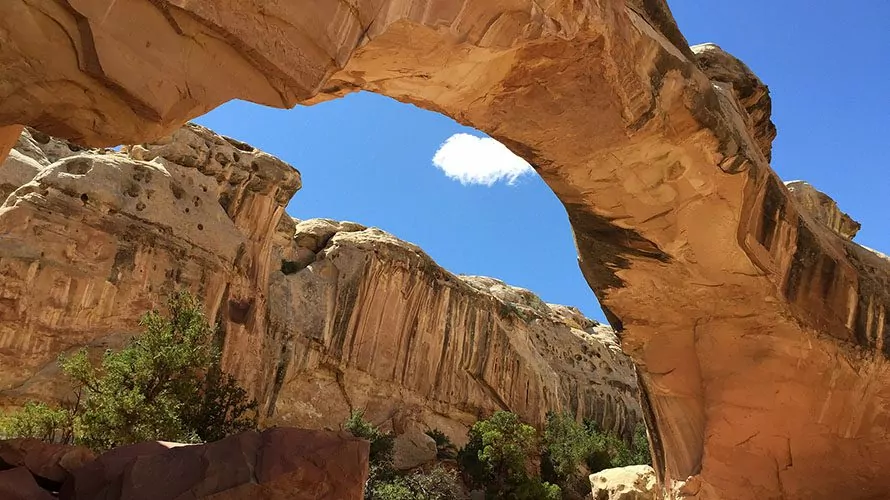
Winter Capitol Reef Backpack
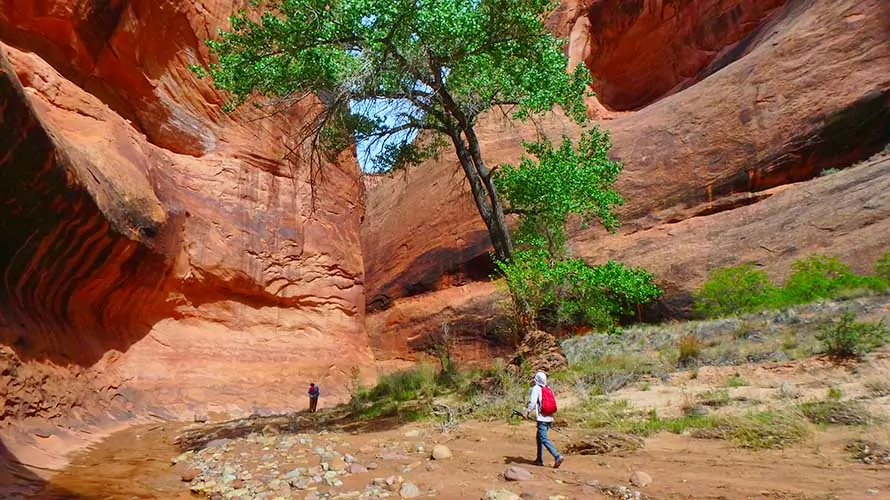
Capitol Reef Backpacking
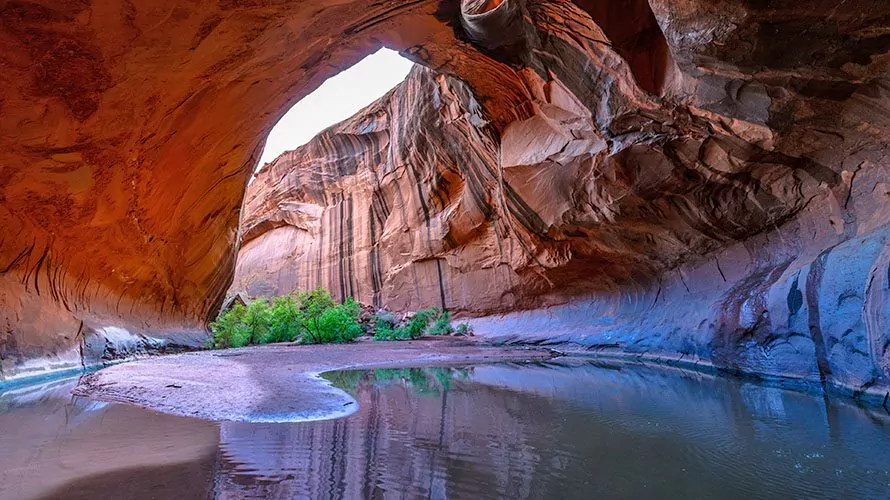
Golden Cathedral
Death Hollow and Escalante River Traverse
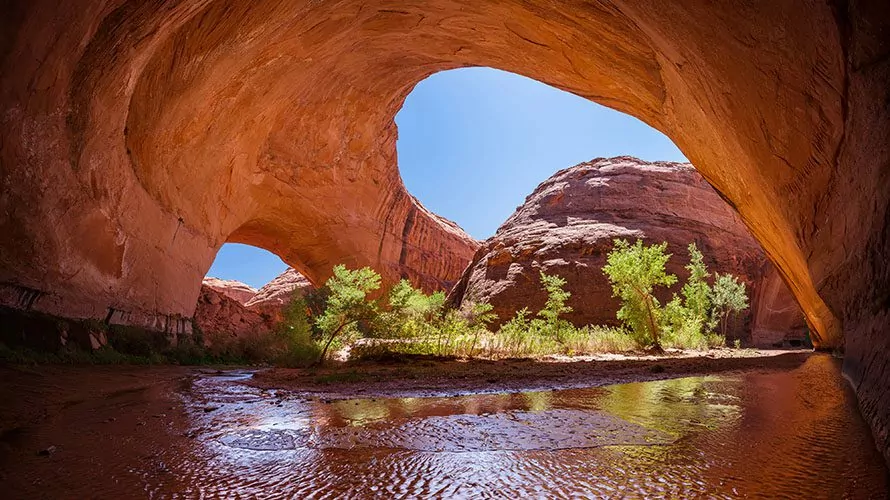
Coyote Gulch
Discover the magic of utah.

There are few other activities that illustrate the splendor of Utah's amazing landscapes than backpacking. Leave the roads, cities and crowds behind and escape into a stunning world of spring-fed creeks, sandstone arches, unique wildlife, and rejuvenating solitude.
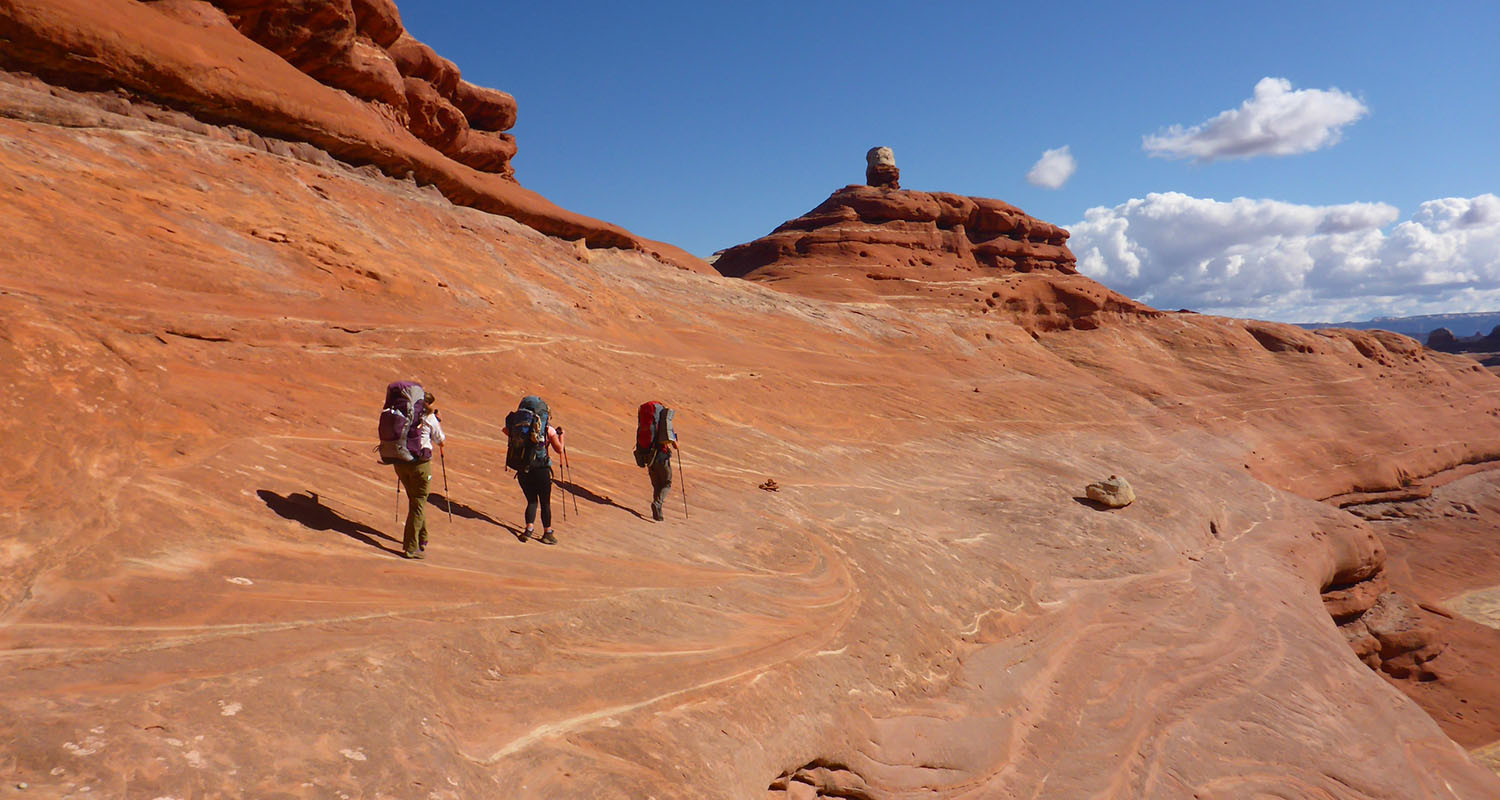
More About Utah Backpacking Trips
The magic of backpacking in southern utah.
Southern Utah is a backpacking paradise. It’s a dramatic landscape rich with natural phenomena, wide open spaces, vast wilderness, hidden canyons, desert oases, wildlife, and fascinating history. To leave the busy roads and walkways and head into the backcountry of Utah is to step into a new, spacious world rich with experiential treasures. The night skies on a Utah backpacking trip are mind-blowing, with the Milky Way clearer and more vibrant than many people have ever seen. There’s something magical about hiking for days to reach a landmark like an arch, or a waterfall, or a natural bridge that, if in the front country, would have a parking lot and hundreds of people stopping to see it. But in the backcountry we have it all to ourselves – it doesn’t get any better than that!
WHICH NATIONAL PARK OR AREA IS BEST FOR MY BACKPACKING TRIP?
Zion National Park and Bryce Canyon National Park don’t allow guided backpacking, so that’s easy enough to make a decision on those areas. That leaves us with Grand Staircase-Escalante, Canyonlands, Capitol Reef, and Paria Slot Canyons. Grand Staircase-Escalante is great for people who want to do shorter trips (3-5 days) with stunning scenery. Capitol Reef is a longer journey (6 days) into a wild, remote wilderness that’s great for guests looking to really get out and explore on a longer adventure. Canyonlands backpacking trips are 4-5 days in length, are moderate in difficulty, and feature classic Utah highlights like arches, springs, Native American history and more. And Paria Canyon is home to the longest slot canyon in the world, so if slot canyons are your thing, then that’s the place to go.
THE WILDLAND TREKKING BACKPACKING EXPERIENCE
To begin with, our Utah backpacking guides are some of the best out there! Ultimately it’s the guide that makes or breaks a guided backpacking trip, and for this reason we take incredible care to make sure we hire the right people, train them well, and treat them well so they stay with us for years. On top of that our guided Utah backpacking trips are all-inclusive, so guests don’t have to worry about traveling with supplies, renting gear, worrying about permits…etc. We take care of nearly everything! You can expect to learn a lot about the area you’re hiking into – natural and cultural interpretation is a major focus of our guide preference and training.
What If I Want to Camp But Not Backpack?
If you’re interested in an outdoor experience of Utah , and possibly even sleeping in the backcountry but you don’t want to do a backpacking trip, we have some great solutions for you! First and foremost, we recommend looking at our llama treks . These trips are backcountry hiking and camping experiences, but with lighter backpacks than on backpacking trips, and there is the added novelty of getting to hike with llamas!
Another option is our Utah basecamp tours . These trips are based in established campgrounds and feature hikes each day to amazing national park and wilderness destinations. All gear, meals and transportation is provided so you can relax and focus 100% on the hiking and camping experience .
wildland Wires
Sign up to receive our exclusive Wildland Wire emails and stay up to date with Wildland Trekking's promotions, discounts, contests, outdoor tips and tricks, trip reports and more!
You May Also Like
- Spiritual Tourism in India
- Fort Tourism in India
- Day Wise Tour Itinerary of San Francisco
- 14 Top Touring Places In Oslo
- 25 Day Tour Itinerary To See Norway
- Denmark Tourism : Day Wise Tour Itinerary of Denmark (2024)

Get a Quote

5 Best Overnight Backpacking Trails in Utah (2024)
In the world of backpacking, there are very few places in the United States that offer the stunning level of scenery and remoteness as the state of Utah . Whether you are hiking on the majestically high ridges in the mountains or exploring deep within the desert canyons of Utah, there are many backpacking trails in Utah that are perfect for providing an experience that you will remember for the rest of your life.
5 Best Overnight Backpacking Trails in Utah
While there are endless backpacking opportunities in Utah, here are some of the best overnight backpacking trails in the state that you must explore.
1. Neon Canyon and Golden Cathedral
Located in the Grand Staircase-Escalante area, the length of this backpacking trail in Utah is 9.2 miles. The elevation gain here is 1260 feet, and the difficulty level is moderate. When you visit the Grand Staircase-Escalante National monument in Utah, you will understand why this is known as the remotest and exciting landscape in the US.

Image Source
With majestic canyons, washes, and epic night skies, the Neon Canyon and Golden Cathedral backpacking trail draw adventurers and nature lovers here. And once you visit this place once, you will find yourself wanting to come back again and again.
It is important to note, though, that the Neon Canyon and Golden Cathedral trail requires you to have some technical know-how of backpacking as well as the right gear.
You will need ropes for rappelling, and depending on the time of the year, you might even need dry suits. Always make sure to check out the weather report before heading into canyon country. Flash floods are a real risk while backpacking in places like the neon Canyon and Golden Cathedral, so make sure that you are prepared beforehand.
2. West Rim Trail at the Zion National Park
Taking you through the Zion National Park, the West Rim Trail is a 12.2 miles round backpacking trip. The elevation gain here is 2510 feet, with a moderate difficulty level. The West Rim Trail will allow you to be absorbed into the Zion National park’s awe-inspiring sheer-cliff sandstone beauties as you check out the summit Angels Landing and then continue onwards to explore more gorgeous views. As you come in contact with the grand western landscape, you will feel like never leaving.

The West Rim Trail is a seasonal backpacking trail in Utah that will take you south from just below the Lava Point Campground as you trek across the large Horse Pasture Plateau here. You then head down towards Angels Landing and the Grotto Picnic Area. However, a certain part of the trail, a valley nestled in between the Mount Majestic and the plateau, known as Little Siberia, becomes impassable due to ice and snow. While it is possible to trek the entire length of this route in one day itself, most visitors love to turn it into a two-day trip to enjoy the gorgeous landscape and views all around. You can either camp at Potato Hollow or at Cabin Springs. You need a permit to camp within the park.
3. White Pine Lake
Located in the greater Salt Lake area and Little Cottonwood Canyon, this backpacking trail takes just five miles to the lake. The elevation gain of the trail is at 2696 feet, and the difficulty level is strenuous. It is not advisable to bring children along on this trail.
The beautiful Salt Lake City is sitting right next to some of the most majestic and stunning mountains in the whole world. It takes only 30 minutes from downtown Salt Lake City to reach the White Pine Trailhead. The trail is also perfect for an overnight getaway from your routine life in the city. While the trail starts out easy with wide roads, the incline starts to increase once you pass the river junction. At the river junction, you can either continue going left up to some switchbacks that will take you to White Pine Lake or take a right to go to Red Pine Lake. The trail is steep enough to get your heart pumping, so it is necessary to make several stops to rest and hydrate yourself.

The White Pine Trail is a favorite backpacking trail in the Little Cottonwood Canyon, Utah. With the natural beauty of the glacially carved valley, sharp ridges, lush alpine forests, and cold lakes, the trail basically takes you through an abandoned road. This makes it quite easy to traverse through, despite the steep elevation gain.
At the end of the trail, you reach some of the most gorgeous meadows you will ever see in your lifetime. The lake is located in a cirque with rocky cliffs surrounding it on all sides. The alpine scenery and the majestic mountains all around make for an incredible experience.
4. Ibantik Lake
Situated in the Uinta Mountains region of Utah, this trail has a length of 4.2 miles to reach Ibantik Lake. With a moderate challenge level, the elevation gain of this trail is 590 feet only. The Uintas area is relatively less crowded, but it takes a bit more time to reach here from the city. The trailhead to the lake is located just off east of Kamas, the Mirror Lake Highway. When you get to the exit for Trail Lake, exit west onto the paved road and drive for a mile or so until you come to a fork in the road. Then turn north for another mile to reach the trailhead.

You will enjoy passing by many mesmerizing lakes and several smaller ponds on the way to Ibantik Lake.
5. Mount Timpanogos
One of the most impressive and breathtaking overnight backpacking trails you can explore in Utah is at Mount Timpanogos. Mount Timpanogos is the most remarkable wall that dominates and stands tall in the landscape on the northern part of the Utah Valley. It is indeed a sight to behold. Mount Timpanogos is one of the most popular mountain biking destinations in Utah, as well as one of the most recognizable mountains in the state. With an altitude of 11749 feet, it is also the second-highest summit of the Wasatch Mountains, with Mount Nebo being the highest.
There are two trails here that are commonly used to reach the summit. The first is known as the Aspen Grove Trail, which has a length of 8.3 miles one way. It starts at the Theater-in-the-Pines picnic area on the eastern side of the mountain, and it is a very beautiful trail that takes you through several breathtaking waterfalls.

The second trail is the Timpooneke Trail, which also leads to the summit, and extends around 7.5 miles one way from the Timpooneke Campground in the American Fork Canyon. Horses are allowed on this trail, but the Aspen Grove Trail does not allow horses.
You will see some of the most spectacular wildflowers along both trails, along with the fall colors. Wildlife is commonly seen along both paths, including several herds of mountain goats. A snowfield perched on top of the mountain never melts, and it is a must-see when you reach the summit.

Related Posts

8 Best Cities to Visit in Utah and Enjoy (2024)

10 Best Small Towns to Visit in Utah for Fun (2024)

6 Best Lakes in Utah that Will Take Your Breath Away (2024)
Where do you want to go.

Medical Tourism Enquiry

- Sleep Systems
- Trekking Poles
- Camp Kitchen
- Accessories
- e-Gift Cards
- Backpacking 101
- Expert Articles
- Returns & Exchanges
- Search by Map
- Browse List

Top 8 Backpacking Trails in Southern Utah
Southern Utah is arguably the most scenic area of the state. It is home to 7 state parks, 5 national parks, and many national monuments, forests, and rec areas. This area boasts the largest concentration of slot canyons and natural arches in the world. Arches National Park alone has over 2,000 documented ones. With all these unique geological features, it's no wonder that so many people flock to this region for hiking, backpacking, and general sightseeing.
Today, we're looking at some of the best southern Utah backpacking trails to get up close and personal with these natural wonders.
Featured Photo: Reflection Canyon Sunrise by Ken Xu
Canyonlands-Needles District
Looking to make the most of your time at Canyonlands National Park? This 32-mile, 3-day loop is your best bet. Plus, you won't have to worry about spotting a car or setting up a shuttle! This trip is leisurely, allowing for extra time to explore. The path takes you past several geological highlights, including Devils Kitchen and Druid Arch. You can also add a spur to Peekaboo Arch. (Just a few miles extra.) On top of that, you'll hike through a different canyon each day. So, the scenery is always changing!
Camping is allowed in designated areas only. Make sure to get your reservations early. A good map is also highly recommended. For more details, head over to our detailed Hike of the Week: Canyonlands article .

Coyote Gulch Loop
Located in the Glen Canyon Rec Area, this short 13.5-mile trip is great for a quick overnight. This trail features towering rock faces and even a small waterfall, an unusual find in the desert. Other features include Coyote Natural Bridge, Crack in the Wall, and Jacob Hamblin Arch. (The best camping spots are near the latter.) Be sure to bring some rope to lower your pack down through Crack in the Wall. That should give you an idea of how tight it is. It's also worth noting that there are several areas where walking through water is unavoidable. Looking for a longer trip? There are several trails in this area to extend your stay.
Trans-Zion Trek
Ready to immerse yourself in everything Zion NP has to offer? The 47-mile Trans-Zion Trek takes most people 3-5 days to complete. It offers a mix of all the park has to share, including “creeks, desert, meadows, pine forests, and sprawling views from rim tops”. Make time for side trips to Kolob Arch and the duly popular Angels Landing. Expect several hard days, especially the steep incline in and out of Zion Canyon.
A shuttle is needed for this trail. It's located in a remote area of the park. You will have plenty of privacy, but you should also be prepared with plenty of water and a good map.

Owl Creek-Fish Creek Loop
Need a quick getaway, but still want something challenging? This 17-mile overnight is perfect for that. Or, set a leisurely pace and stay two nights to enjoy the stark beauty longer. This route is also great if you're looking to avoid the crowds at nearby Grand Gulch. The downfall is that the trail is not maintained. Again, be familiar with reading maps. (There are rock cairns too, but those can be unreliable.)
The Owl Creek-Fish Creek Loop follows a streambed. The valley is full of juniper, prickly pear, and yucca. Major highlights include excellent views of Cedar Mesa, Neville's Arch (and several other unnamed ones), and ancient Puebloan cliff dwellings and rock paintings. Small springs are found along the way, so fill up when you can. There are some long stretches without any water.
Buckskin Gulch/Paria Canyon
Want to explore the longest slot canyon in the U.S.? Prepare for a 44-mile, 4-day trip in the remote Vermillion Cliffs Wilderness. There are all kinds of neat geological features along the way. These include petroglyphs and fossils, beautiful orange, yellow, and purple canyon walls, and plenty of nooks and crannies to explore. (Be prepared for some boulder scrambling in a couple of spots too!) You could also add a side trip to Wrather Arch.
It's very important to check flash flood warnings ahead of time. You will be traveling along a river bed. Several freshwater springs are available to fill up at. There are a limited amount of permits, so plan accordingly. Check out our full article on Buckskin Gulch / Paria Canyon for more details.

Bullet Canyon to Grand Gulch
Sure, we mentioned above that Grand Gulch can become crowded, but it's still a great hike. Like most areas, you can get to these highlights several different ways. Most range between 14 and 20 miles round-trip. You could get this done as an overnight, but you'll likely want to spend more time exploring all the area has to offer.
Grand Gulch is one of the most popular hiking destinations in southern Utah. Looking for more than the stunning scenery of the sandstone cliffs rising above you and the pinon-juniper covered valleys? Grand Gulch is an archaeology lover's dream too. Many Anasazi cliff dwellings and art are found here. Bullet Canyon, which is an off-shoot of Grand Gulch, houses Perfect Kiva and Jailhouse Ruin. Several other ruins, including some granaries, are found along the way too.
Reflection Canyon
This iconic spot in the Glen Canyon Rec Area has gained popularity over the past decade or two. You've likely seen pictures of this secluded section of Lake Powell, winding through the multi-colored canyon walls. The journey is about 20 miles, but difficult. Lengths vary as there is no set trail. This is also a good reason to make sure your wayfinding skills are on par! The route offers great views of Navajo Mountain. Reflection Canyon itself is a magnificent backdrop for sunsets and sunrises. Be sure to take a camera!
Permits are free, but you'll still need to get one at the Escalante Visitor Center. It's also one of the few trails you can bring your K-9 friend along. There is no water at all, though, so make sure you bring plenty, even if it's just you.
Under the Rim Trail
Bryce Canyon is another popular national park in the region. This 23-mile trail gives you a different view of the park than most see. The park is famous for its tall rock spires, known as hoodoos. You'll get an up-close and personal look at these unique geologic anomalies. Other highlights include Hat Shop (white-capped hoodoos), Natural Bridge, and the popular Bryce Point. The campgrounds near Yellow Creek are shaded, forested spots. Nice for a break and water, at the least. The trail also offers unique views of the “amphitheater”. You'll also find that the scenery is very different and lusher than other areas of southern Utah.
There are many access points if you need to bail along the way. You will also need to spot a vehicle for the end of your journey.
If you're looking for more hike ideas, read our " Best Backpacking Trips in the Desert Southwest " roundup post. Also, the following “Hike of the Week” articles cover other great hikes in the region.
Hike of the Week: Halls Creek Narrows Hike of the Week: Grand Canyon Rim-to-Rim Hike of the Week: White Rock Springs
For even more amazing backpacking trips, visit The Trailhead, our interactive hike map . It contains a curated list of dozens of hikes, each with a detailed write-up.

Finally, check out our comprehensive list of backpacking articles that cover just about everything there is to know about backpacking. If you're just starting out, our Backpacking 101 section covers all the basics. If you already have a few trips under your belt, you can find more advanced topics covered in our Expert Articles .
Leave a comment
Please note, comments must be approved before they are published.
Who is Paria Outdoor Products?
Looking for backpacking trip ideas?
Browse Articles by Topic

We stand behind our gear and offer a lifetime warranty on all of our products.

Free standard shipping on all US orders. Shipping fees apply on international orders.

Browse our interactive map with dozens of amazing hikes through the U.S. and beyond.
- National Parks
- Tiny Houses
5 Incredible Backpacking Excursions in Zion National Park, Utah
Posted by Sarah Lamagna June 09, 2021 Updated January 05, 2024
We research, evaluate and select travel destinations based on a number of factors, including our writers’ experience, user reviews and more. We may earn a commission when you book or purchase through our links. See our editorial policy to learn more.
Designated in 1919 as the 15th National Park, Zion marvels everyone who visits its sandstone cliffs and geological formations.
Zion averages around 4.5 million annual visitors — but only a handful of those get to see the true wild of the park’s backcountry. If you elevate your adventure and head out on one of the several backpacking trails, you’ll get to see a side of Zion that many visitors overlook. Whether it’s the dramatic top section of The Narrows, the Southwest Desert, or the less-touristy views in Kolob Canyons. No matter where you decide to camp in the backcountry, the views will not disappoint.
As a reminder, hiking in Zion National Park has its own quirks. In this part of the desert, even on the hottest of days the nights can drop considerably so come prepared to keep warm in your tent. With high temperatures during the day, it also means that water is more essential than ever. Plan ahead of your trip to see what water sources are located along your trail of choice.
Hiking in places like The Narrows offers stunning views but potentially dangerous situations. During rainy weather — especially the July to September monsoon season — this area can be hit with flash floods at a moments notice. So take head and watch the weather around the days of your trip. Carry the gear you’ll need depending on the trail you take. Ask yourself if you’ll need to buy neoprene socks or trekking poles or a larger water bladder. Even the best and easiest of backpacking trips can go sour quickly if you aren’t prepared with the right gear or the right information.
Pro tip: all backcountry camping requires a permit within Park boundaries. Some sites are reservable in advance, others are first come, first serve. Check out the National Park Service’s information on backpacking in the park.
Related Read: 7 Epic Things to Do at Great Basin National Park, Nevada

1. The Narrows – Top Down
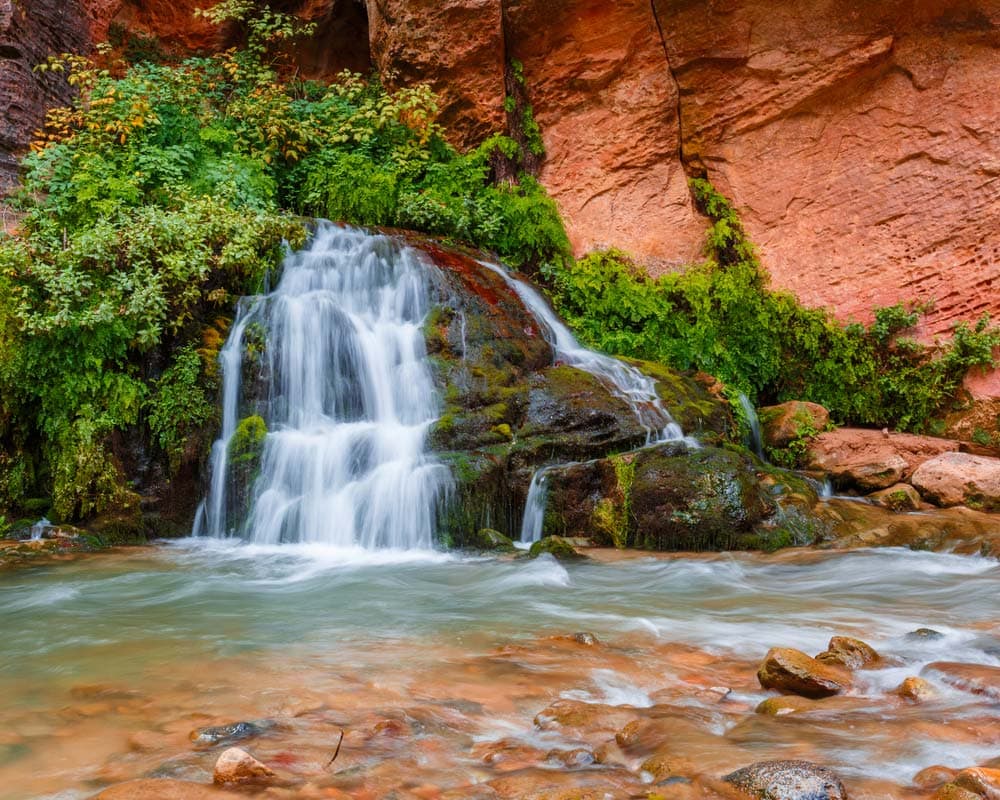
Why you should go: see a stunning portion of The Narrows that day hikers can’t enjoy.
- Distance: 16 miles (shuttle)
- Elevation loss: 1,500 feet (the entire hike is downhill)
- Difficulty: challenging
Most visitors to Zion National Park see only the southern portion of The Narrows . The popular day-hike starting at the northern tip of Zion Canyon is one of the most popular day hikes within the park boundaries. However, day hikers are not allowed past Big Springs — about 4 miles from the end of the Riverside Walk and where hikers enter the water.
But anything to the upstream of Big Springs is only for those with coveted backcountry permits. This is a point-to-point backpacking excursion meaning you start at one end and finish at another. You’ll need to shuttle between the two spots.
The hike starts at Chamberlain’s Ranch where you walk for three miles on an easy gravel road. Then head into the Upper Narrows portion until you reach the Deep Creek Confluence. This is where the backcountry campsites are located — you’ll be given a campsite when you pick up your permit. Hopefully you’ll land a campsite further down so you won’t have to hike as much the second day. But no matter your designated site, they pack in as many views as possible inside a slot canyon.
The campsites end at Big Springs and is where you might start to see more people in the creek. You’ll know you’re getting closer to the trailhead as more and more people walk by you wondering why you’re wearing a huge backpack. Tourists come from all over to see the famed “Wall Street” and some are not necessarily prepared with the right footwear or gear.
Pro Tip: explore the gorgeous Orderville Canyon as a side trip if you’ve got time and the weather is on your side.
Related Read: 12 Gorgeous Cabin Rentals Near Zion National Park, Utah
2. Hop Valley
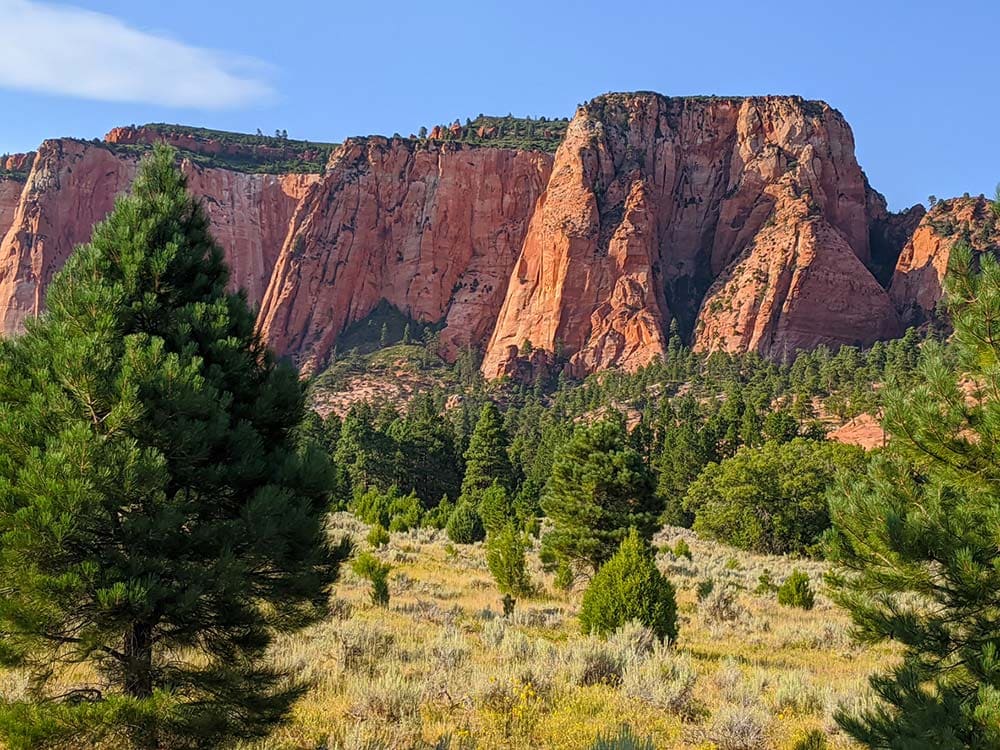
Why you should go: a mini–Zion Canyon without the crowds.
- Distance: 14.3 miles (out and back)
- Elevation gain: 1,020 feet (all uphill on the way back)
- Difficulty: moderate
Hop Valley is part of an overlooked and under-appreciated side of Zion National Park: Kolob Canyons. Because area is higher in elevation than the main part of the park, it tends to be cooler — meaning this is a great place to beat the summer heat! This is also a great trail to do in the spring or fall though as wildflowers bloom and autumn leaves light up the edges of the trail.
No matter the season you head out, the trail starts with the smells of dry sagebrush —you know the smell I’m talking about! You’ll pass through a private ranch (the owners graciously allow hikers/backpackers to access their land) along the sandy trail. Due to the ranch, you’ll see plenty of cattle on the trail and is why Hop Valley is known to locals as “Plop Valley”.
Soon enough, glimpses of Kolob Canyons appear in your view. You’ll be surrounded by gamble oak (which is a true sight to see in the autumn) as you ascend the northern end of Hop Valley. There are two designated campsites along this section. After you set up camp (and if the light is on your side), then I suggest making the quick trip to Kolob Arch (the largest rock arch in Zion) before you head out the next day.
Pro tip: there is a small creek that flows through Hop Valley but it’s contaminated by cattle droppings. Get your water at Beatty Spring, just off the La Verkin Creek Trail.
Related Read: 11 Beautiful Glamping Spots Near Zion National Park
3. West Rim Trail – Top Down
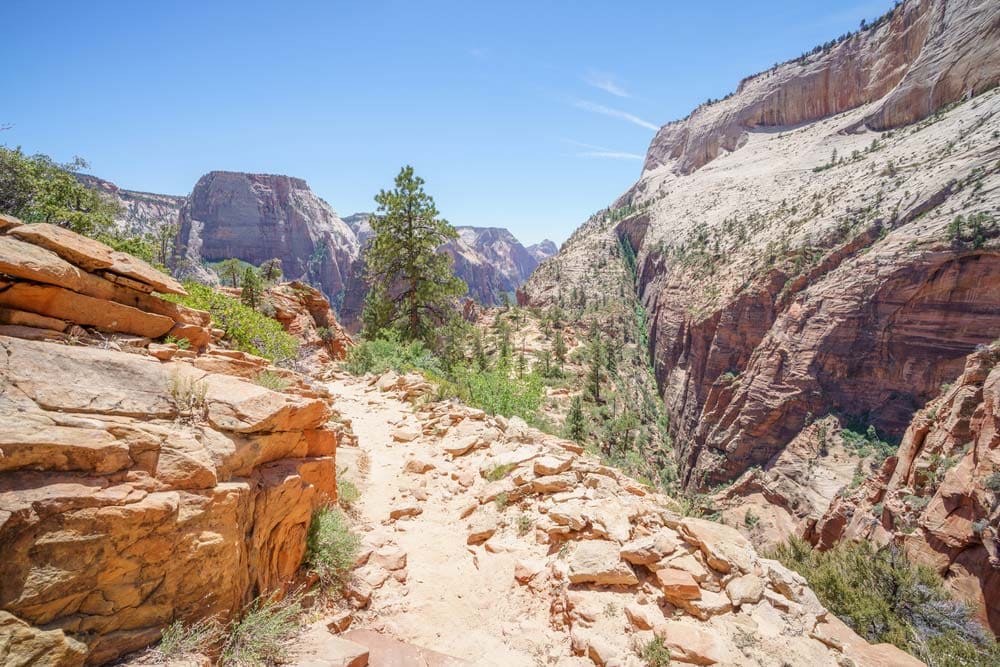
Why you should go: single-handedly the best views in the park.
- Distance: 14.2 miles (shuttle)
- Elevation gain: 1,748 feet
Without a doubt, the most popular and famous backpacking trail in Zion is the West Rim Trail . It follows along Zion’s incredible and majestic West Rim before it drops into Zion Canyon, so its popularity is understandable.
There are eight campsites along this trail, but you can do this as a day hike if you’re a strong hiker. This is a point-to-point hike, so you’ll need to establish a shuttle/pick-up system prior to heading out on your adventure. As you hike longer and longer, the views of the dramatic sandstone peaks just get more incredible. One such sight is along a spur trail that heads west to Cabin Spring — definitely take this spur trail!
Eventually, you’ll descend into Behunin Canyon and around the base of Mount Majestic and end at Scouts Lookout. But your hike is not over. If you have energy, do the final push towards Angels Landing — believe me, it’s well worth the extra mileage and nerve-wracking drop-offs to get to this spot. After concluding this daring trail, simply head to the Grotto bus stop (#6 on Zion’s bus route).
Pro tip: load up on water at Potato Hollow Spring — it’s the only dependable water source before West (Cabin) Spring.
Related Read: When is the Best Time to Visit Zion National Park?
4. La Verkin Creek Trail
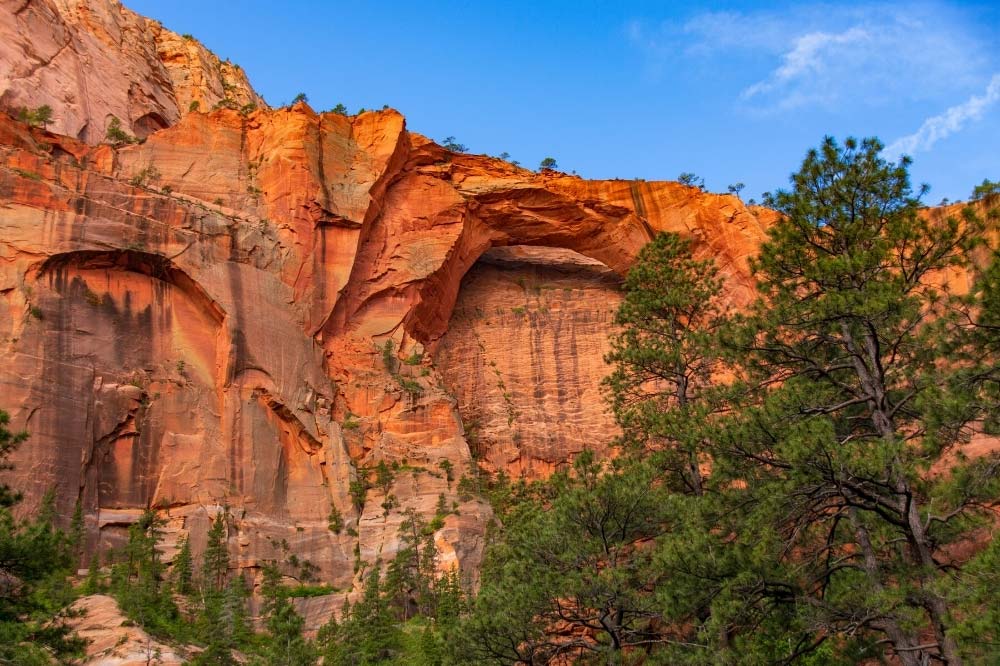
Why you should go: hike to the largest rock arch in Zion National Park.
- Distance: 18 miles (out and back)
- Elevation gain: 2,326 feet
Although this is the longest hike in the Kolob Canyons section of Zion National Park, it’s a truly lovely stroll along the less visited section. The La Verkin Creek Trail starts at Lee Pass. Fun (or maybe not so fun) fact: Lee Pass is named after John D. Lee who was an early member of the Church of Latter Day Saints. He hid out in this area of Zion after he convinced a group of emigrants to surrender their weapons and property to Mormons which led to 120 of the emigrant party to be killed by Mormon militia and Paiute Indians. He was later convicted of mass murder and executed in 1877.
But this hike is so not as depressing as that story. You weave in and out of ponderosa pine forests and sagebrush ecosystems with the tall sandstone cliffs towering above you. All the campsites along the trail offer these incredible views. About seven miles in, you’ll hit the spur trail for Kolob Arch which is a highlight of the trail. The arch is the largest one in Zion and one of the largest free-standing arches in the U.S.
Related Read: 11 Backpacking Trips in the U.S. That Should be on Your Bucket List
5. Chinle Trail
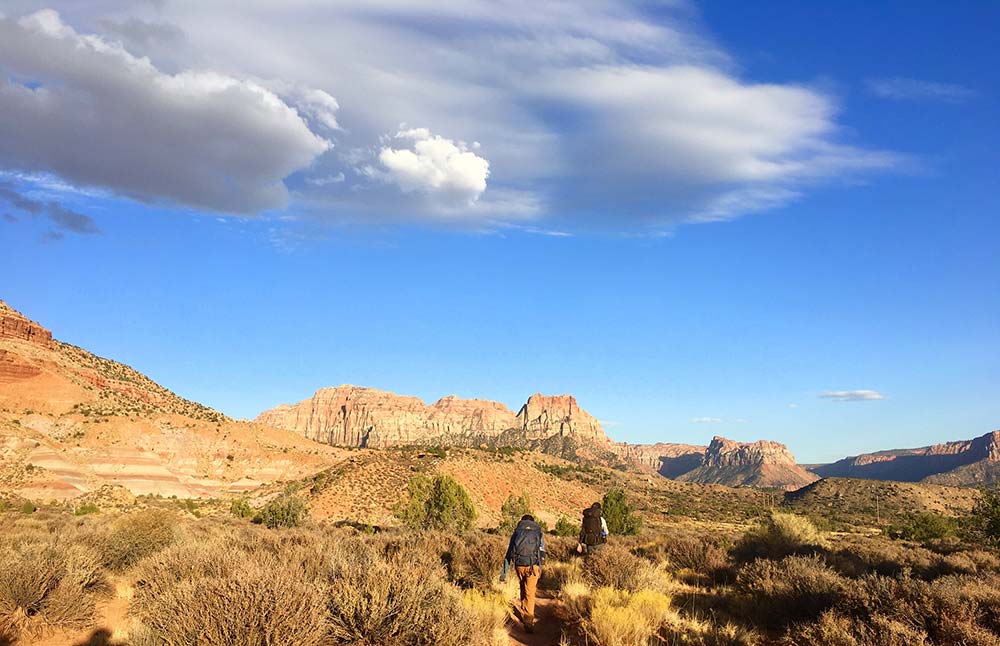
Why you should go: the only place in Zion you’ll find petrified wood.
- Distance: 15.5 miles (out and back)
- Elevation gain: 1,794 feet
The Chinle Trail has scenery like no other in Zion National Park. So if you’re tried of the slot canyons and river crossings, then look no further than this trail. The trail actually starts out off of park land to the southwest of the Zion’s South Entrance. The first part of the hike meanders through a luxurious and ritzy housing development (not really my cup of tea if you ask me) before it opens up into the wild of Zion National Park.
The trail traverses Zion’s lowest elevations with sweeping views of the sandstone cliffs like the ones around the base of Mount Kinesava. Make sure to stay on trail always as cacti and biological soil crust are just off trail. Geology nerds will be excited about passing Huber Wash and entering the Chinle Formation in this area. Once upon a time, Zion was a humid swamp covered in mosses, ferns, and green forest. Those trees were buried and then mineralized forming petrified wood that you can easily see along the edges of the trail today.
Remember Leave No Trace principle # 4 , and leave what you find.
Explore More in Southern Utah
The Perfect Road Trip Itinerary Between Zion and Bryce Canyon
The Best Things to Do in Kanab, Utah
9 Great Hikes in Grand Staircase-Escalante National Monument
11 Best Airbnbs Near Zion National Park, Utah
10 Awesome Things to Do in Escalante, Utah
6 Stunning Backpacking Routes in Canyonlands National Park, Utah
Sign up for Weekend Wanderer to join thousands of readers getting epic and gear travel ideas every week.
Seen in: Backpacking , National Parks , Southwest , Utah , Zion National Park
Posted by Sarah Lamagna
Sarah is an ecologist-turned-freelance writer specializing in the ecotourism and slow/sustainable travel industry. Her bylines include The Denver Post, 5280 magazine, VeryWellFamily, Matador Network, and was an expert on NPR’s The Takeaway for her work on the wildfires in Colorado.
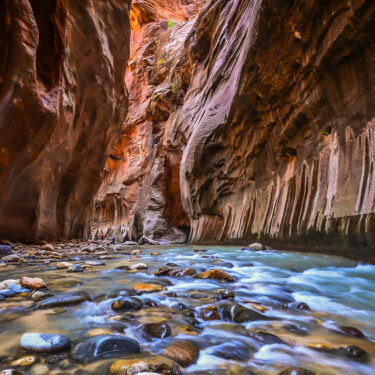
The 14 Best Hikes in Zion National Park, Utah
Find your next adventure.
Sign up for Weekend Wanderer and join thousands of readers getting epic travel ideas weekly.
Related Posts
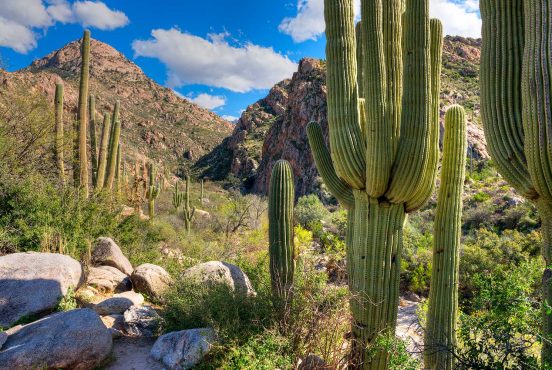
6 of the Best Hikes Near Tucson, Arizona
With the incredible variety of terrain, there’s something in the Tucson area for everyone.
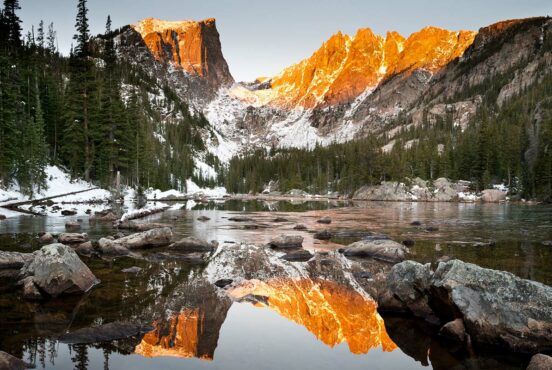
10 Epic Things to Do in Rocky Mountain National Park
With 77 mountain peaks at more than 12,000 feet above sea level, it's not just the views that'll leave you breathless in Colorado’s most-visited national park.
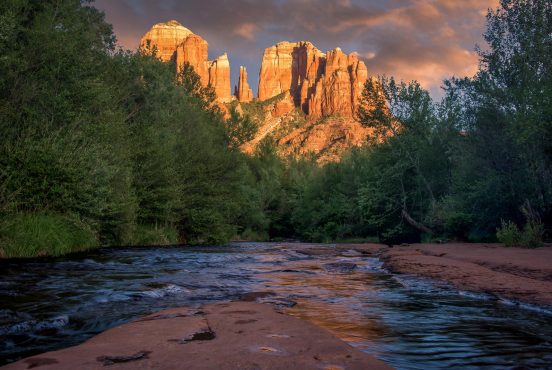
Back Way to Cathedral Rock: How to Hike it + Where to Grub & Catch Some Z’s Nearby
Reach the top of the Cathedral Rock Trail and you'll be surrounded by massive rock walls, spy expansive views of Courthouse Butte and Mingus Mountain — and walk along the edge of a cliff if you are feeling adventurous.
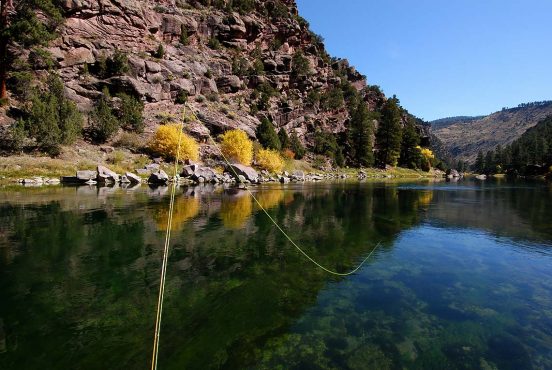
The Beginner’s Guide To Fly Fishing In Utah
Fly fishing is far more intensive than the image you probably have in your head, but that's the point — the challenge makes the reward of reeling in a catch even sweeter.
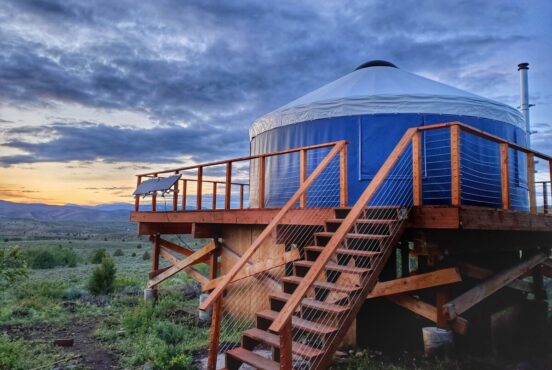
10 Spectacular Yurt Rentals in Utah
Utah is well known for its rugged and beautiful backcountry, from the stunning red rock canyons and deserts of southern Utah to the snow-capped Wasatch Mountains around Salt Lake.
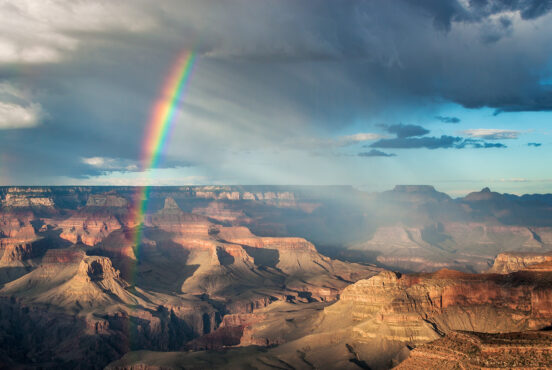
6 Epic National Parks Near Las Vegas, Nevada
Sin City might be famous for its sky-high hotels and Cirque Du Soleil shows, but just outside of this unlikely desert hot spot are natural wonders galore.
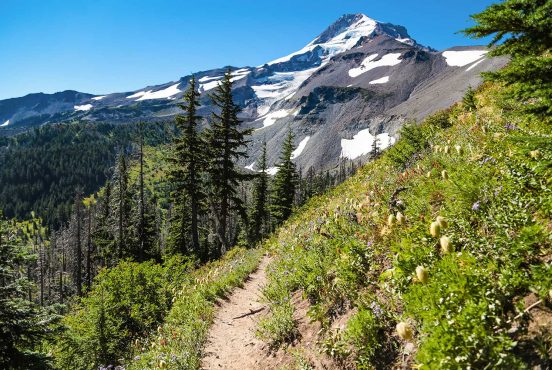
Trail Guide: Timberline Trail at Mount Hood, Oregon
If Oregon's biggest treasure is Mount Hood’s snow-capped peak, then the Timberline Trail is its shining tiara.
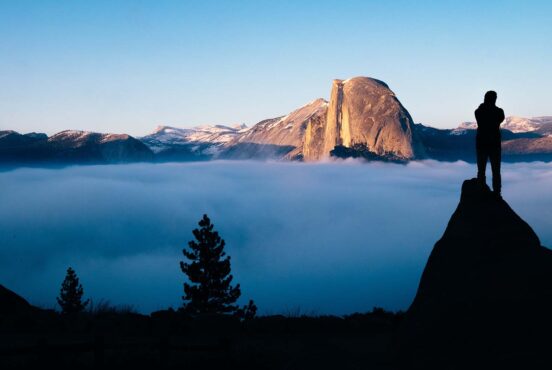
9 Adventurous Things to Do in Yosemite National Park, California
Home to towering granite cliffs, shimmering alpine lakes, meadows full of spring wildflowers, and the tallest waterfall in North America, Yosemite is a mecca for nature lovers of all sorts.
- Big Wild Adventures Founders
- Testimonials
- Green Business
- Conservation
- Wilderness Safety
- Photo Gallery of Past Backpacking Trips
- All Scheduled Trips 24/25
- Custom & Family Trips
- Yellowstone
- Why Big Wild
- For Beginners
- A Typical Day
- Connecting & Lodging
- Packing Light
- Physical Fitness
- Trip Ratings
Book an Adventure or Call Now! (406) 823-0337
Utah Backpacking Trips
Backpacking Utah’s Slickrock Canyon Country is unlike exploring any other landscape on Earth; it is an unbelievably colorful region of deep red-walled canyons with clear streams flanked by a lush growth of willow and cottonwood. There are slot canyons and ancient Indian ruins, too. It is spectacular! Above the canyons are high, wide-open mesas of sprawling “slickrock” sandstone, plus sandstone domes, sand dunes, arches and many other spectacular geologic features. Open woodlands of juniper and pinyon provide additional greenery, and from these mesas you can see forever! Backpacking in Utah with Big Wild is a truly unique experience.
Big Wild Adventures has been organizing and leading some of the best Utah backpacking trips into the canyon country wilderness for over three decades . Join us in the big wilds of Canyonlands National Park, the Escalante Canyons and the Utah Grand Staircase backcountry of the Grand Staircase-Escalante National Monument. By the way, the Grand Staircase trip is one of our more rugged and remote Utah backpacking trips . The Utah backcountry is among the most exciting and primeval landscapes on Earth!
Please note that our Utah hiking trips may fill up quickly, and we take reservations on a first-come, first-served basis. So don’t miss out! To reserve your space, call 406-823-0337. We can’t wait to backpack southern Utah and explore the colorful wilds with you!
KALEIDOSCOPE ROCKS OF CANYONLANDS NATIONAL PARK
Utah $2,100 (inclusive*) • April 22-27, 2024
Trip at a glance: The trip is rated moderately easy and its base is Grand Junction, CO. In this trip we will explore some of the most colorful landscapes on this planet. This adventure in the backcountry of Canyonlands National Park will include colorful sheer canyon walls, beautiful arches, unique high desert vegetation, refreshing streams flanked by lush growth of willow and cottonwood, and magnificent rock formations. Native wildlife is also in this portion of the Colorado Plateau includes desert bighorns, bobcats, golden eagle and more. We will see ruins and pictographs of ancient cultures. This trip is absolutely beautiful and you will experience much of what backpacking in Utah’s unmatched canyon country has to offer on a really mellow hiking route. This is one of the best backpacking trails in Utah. View full trip details >>
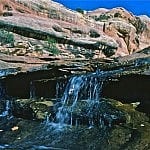
GRAND STAIRCASE BACKCOUNTRY, CANYON AND MESA MAGIC
Utah 2,100 (inclusive*) • April 15-20, 2024
Trip at a glance: This trip is rated fairly strenuous and its base is Cedar City, UT. We will adventure just a few miles north of Arizona in an extremely remote section of the Grand Staircase-Escalante National Monument. This National Monument is full of deep canyons, colorful rocks, spectacular views, high mesas, arches and awesome sandstone formations. This trip also includes cool desert streams, pinyon-juniper forests, peregrine falcons and other birds of prey. At the end of a long day, you will have the opportunity for some great star gazing. This is a real gem, a relatively unknown wild chunk of southern Utah canyon country! View full trip details >>
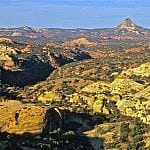
REDROCK CANYONS OF THE WILD ESCALANTE
Utah $2,100(inclusive*) • October 14-19, 2024
Trip at a glance: This trip is rated moderate and its base is Cedar City, UT. Although uphills are limited, there are lots of stream crossings, some hiking upstream, some bushwhacking, and lots of sand. This trip is absolutely stunning! We will be hiking through a magnificent canyon system that has been cut by the Escalante River. We will hike through colorful sedimentary rock formations of the Colorado Plateau including red canyon walls, arches, alcoves and more. The Escalante River and tributaries are full of cool water and lined with lush growth of oak, cottonwood, box-elder, willow and grass. Whether you get to see spring wildflowers or fall colors in October, this is a trip you will not want to miss. There is always plenty of time to explore side canyons. We spend a minimum of one night on top of the slickrock desert above the canyon where the views are stunning! In this area we also typically see ruins and rock art of ancient cultures. View full trip details >>
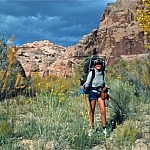
Boulder Mail Trail Grand Staircase-Escalante NM, Utah
Utah $2,100 (inclusive*) • September 30- October 5 , 2024
Trip at a glance: This trip is rated moderate ly strenuous, and its base is Cedar City, UT.
This trip is as spectacular as it is diverse! This long-abandon, historic mail route, now part of the 1.9 million acre Grand Staircase-Escalante National Monument, crosses three major canyons of the Escalante River including the awe-inspiring Death Hollow. Dropping into Death Hollow’s 800 ft Navajo sandstone chasm is an experience not soon forgotten. Our adventure also takes us down 14 miles of the beautiful, winding Escalante River. This hike showcases some of the most spectacular canyon and slickrock scenery in southern Utah . Our route cross es Juniper-pine benches , cool streams, past natural bridges, arches, and then peaceful groves of cottonwoods nestled along the Escalante River. There will be opportunity to see ruins and rock art of ancient cultures . Steep drop offs, mild exposure and a few steep ascents and descents through the first days of the hike account for the moderately strenuous rating. Total backpack mileage is about 28.
View full trip details >>
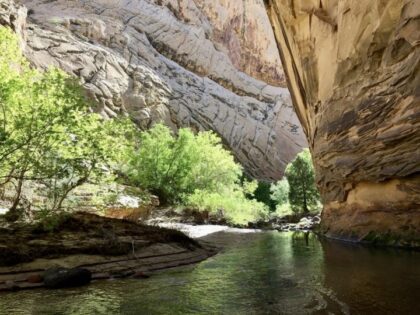
Please click on photos to enlarge.
*All trip prices include equipment (backpack, day-pack, tent, sleeping bag and pad, eating utensils), food and cooking (3 meals/day plus snacks), cooking gear, trip planning, comprehensive safety instruction, all user/permit fees, transportation from town to and from the trailheads, and our professional guide/naturalist staff. There is a $300 discount if you bring your own equipment.
Book Your Trip! Space is limited! Have questions? Call (406) 823-0337
The Utah Landscape
Utah is a land of such radical and amazing diversity that it is difficult to characterize it in a small amount of space. Nonetheless, we’ll give it a try. North-central and northeastern Utah harbor the two most famous mountain ranges in the state, the Wasatch and the Uintas. Though there are few chunks of big wilderness in the Wasatch, the High Uintas Wilderness is the largest high mountain wild area in Utah. Though less isolated and wild, the Wasatch Mountains form a striking backdrop to the Greater Salt Lake City Utah metropolitan area, also known as the “Wasatch Front”.
Big Wild Adventures eschews hiking near large metropolitan areas. We want our clients to experience real wilderness in a remote setting, with minimal light pollution and maximum wildness. Fortunately, when the Wasatch Front is in the rear-view mirror, wild Utah quickly begins to assert herself, and what an assertion it is!
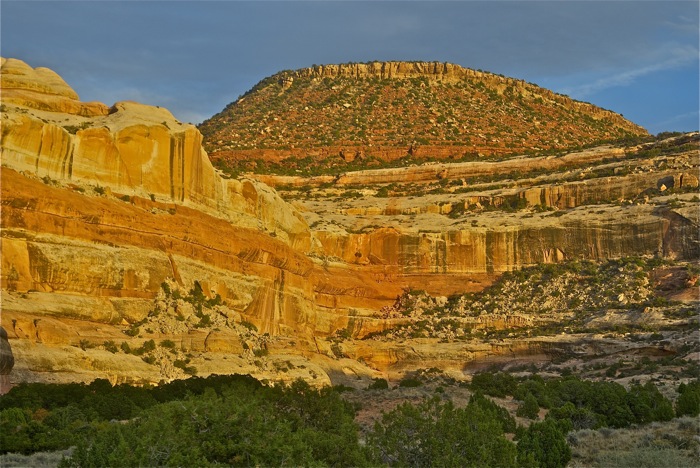
Although there are many other rugged Utah mountain ranges beyond the Wasatch and the Uintas, it is the Canyon Country that comprises Utah habitat for Big Wild Adventures. This otherworldly landscape of southern Utah forms the bulk of a geographic region unlike any other on Earth. Geologists call it the Colorado Plateau, but in popular jargon much of this Utah landscape is simply known as “Canyon Country”. Or “Slickrock Country”. Or “Red-rock Canyon Country” or even “Canyonlands”, although that name is more properly reserved for Canyonlands National Park, one of Canyon Country’s major protected areas and a place frequented by Big Wild Adventures.
Whatever you call it, though, you get the picture. To call Canyon Country in Utah colorful understates the reality. A kaleidoscope of colored rocks dominate the scenery, and yes, many of the rocks are red or reddish, a facet of the iron oxide that results from weathering rock in the high desert Utah climate.
But exploring in Utah’s Canyon Country isn’t just about the rocks and their colors. Deep, often vertical-walled canyons slice through the Utah plateaus. Amazingly verdant plant communities flank cool clear canyon-bottom streams, though some of the Utah canyons are as dry as the Sahara. Don’t worry, though, Big Wild guides know which canyons have water. And some of the canyons are true slots; so narrow that one must turn sideways in order to move!
Annual Trip Calendar
Scheduled utah trips.
At the link below, you can read about all of our Utah backpacking and hiking trips for the current year.
All Utah Trips
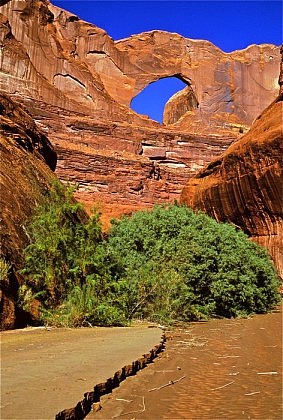
List prices include our complete gear package and there is a $300 discount if you bring your own (see our Canoeing List, Backpacking List, and/or Questionnaire for details – found here ). Also, we offer a $300 discount for the second trip in a calendar year. Scheduled trips are for persons ages 14 and over. Exceptions to the age requirement will be made by us on a case-by-case basis.
Book Your Adventure!
© 2024 Big Wild Adventures. All Rights Reserved. | Terms, Conditions and Privacy | Website SEO and Design by Generation Web.

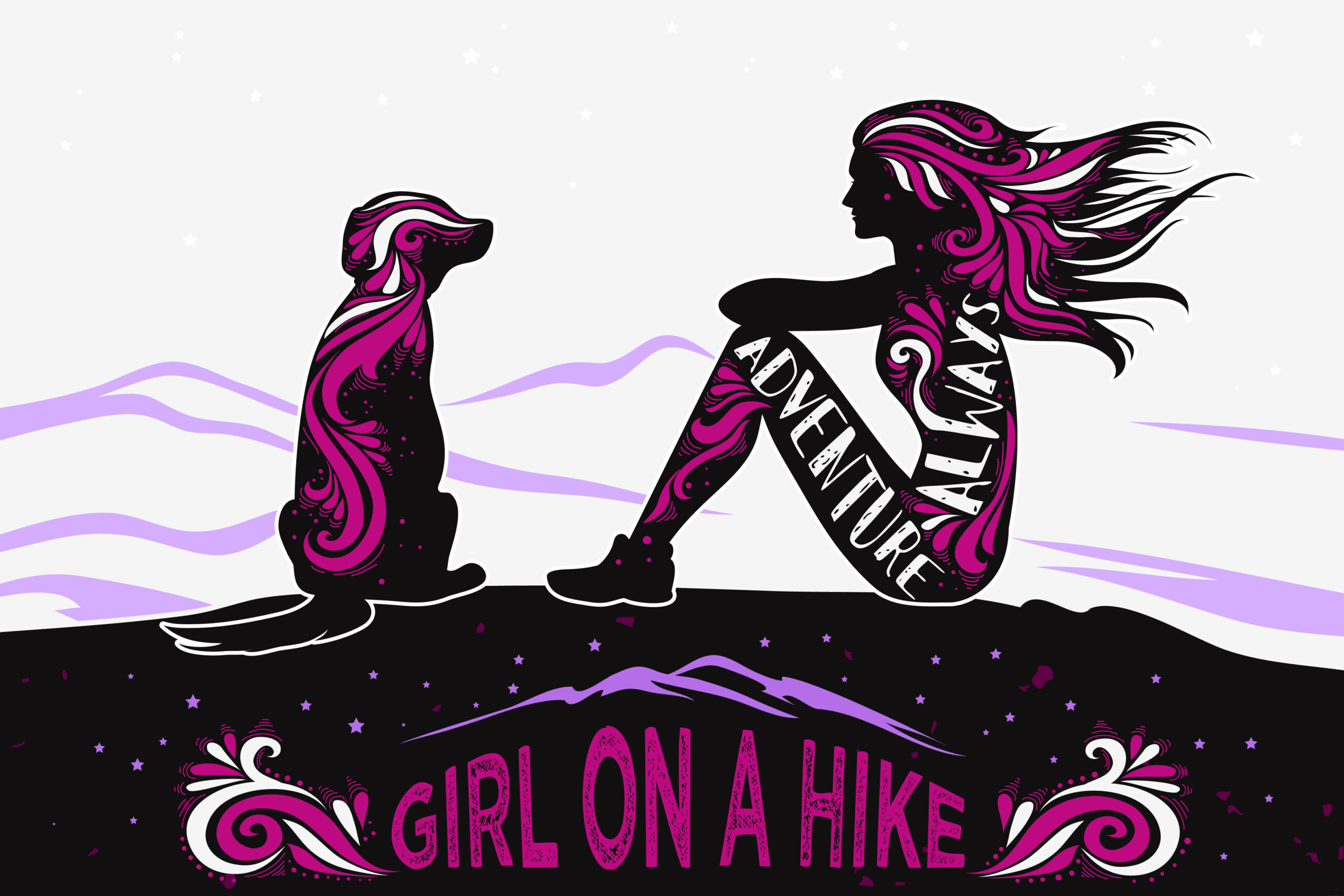
The Best Backpacking Trips in the Uintas
Share the love.
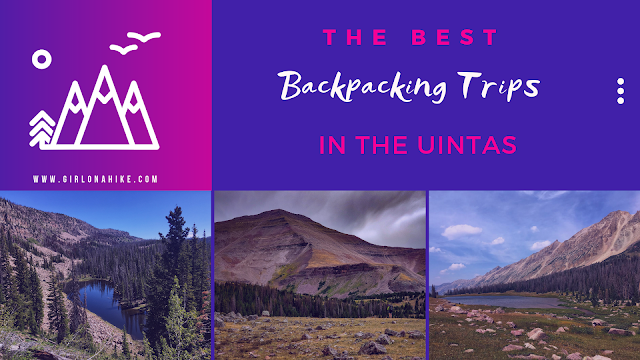
Yellow Pine Trail
The Yellow Pine Trail is one of the first trailheads you will pass after entering the Mirror Lake Highway, coming from Kamas, UT. The trail leads to three lakes – lower & upper Yellow Pine Lakes, as well as Castle Lake. You can also day hike to Duke & Castle Peak, both over 10,000 ft. This is a great early-season backpacking route when the higher Uintas is covered in snow. The trail is mostly well shaded and offers plenty of water along the way for your pup to drink from or to filter from.

Backpacking to Gilbert Lake & Peak
Gilbert Lake is located in the High Uintas Wilderness on the East end of the range, with Gilbert Peak (13,442 ft) being one of Utah’s “13ers” (a peak above 13,000 ft). Gilbert Peak is the 3rd highest peak in the state, and the second highest county high point. It can be access by several drainages, with Henry’s Fork being the most popular, however we accessed it from Gilbert Lake. The trail to Gilbert Lake follows the West Beaver Creek trail for 9.2 miles before reaching the basin which has four lakes total, great campsites, lots of wildlife, and of course, access to the peak.
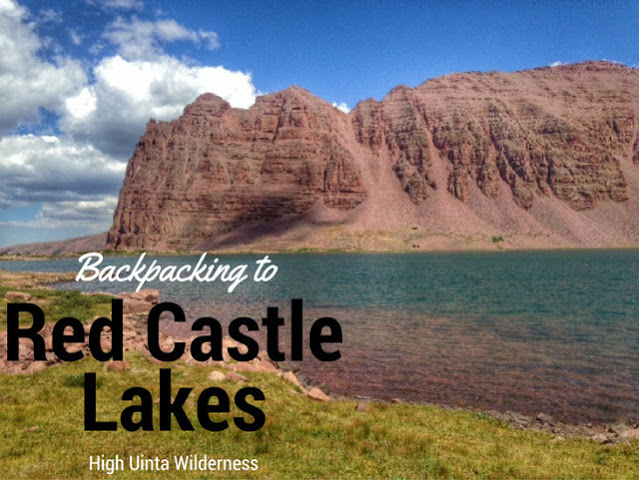
Backpacking to Red Castle Lakes
Red Castle Lakes is sure to be on everyone’s Uintas “to-do” list, especially if you are a backpacker. Not only does the Red Castle area offer four high alpine lakes to chose from, pristine meadows, and great backcountry camping, it also offers a stark contrast of red peaks and a ridgeline to clear blue water that make for great photography.
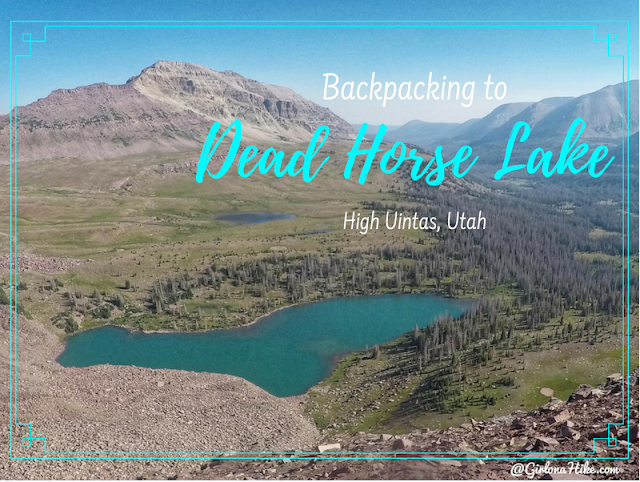
Backpacking to Dead Horse Lake
Dead Horse Lake is in the High Uintas Wilderness, and offers an 11 mile hike through large, open meadows, stunning vistas, and of course, leads you to a turquoise lake. This lake offers a great spot for fishing and day hiking. People hiking the Uinta Highline Trail also pass right by Dead Horse Lake. It’s a dog friendly trail, though you’ll want to give the sheep herds passing by in the meadows plenty of space. Bring your hammock or tent – there are several nice campsites around the lake and plenty of trees for shade. Be sure to check fire restrictions before heading out.
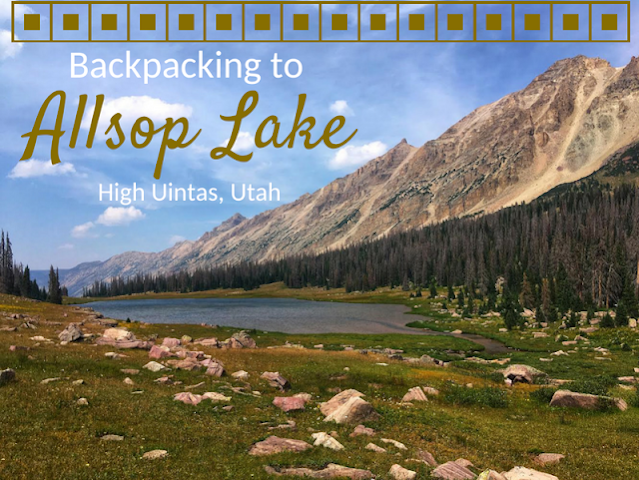
Backpacking to Allsop Lake
Allsop Lake sits on the Northern slope of the High Uintas Wilderness at an elevation of 10, 600 ft. It’s 9 miles to the lake, so it makes for a perfect 1 or 2-night backpacking trip. The trail is fairly mellow, only gaining 1,600 ft and has one switchback. Allsop Lake is full of brook and tiger trout, and there are a few day hiking options from the lake as well including Cathedral Peak, Allsop Peak, and Yard Peak. This trail is dog friendly, however be aware that free-range livestock graze along the entire route.

Backpacking to Priord Lake
Priord Lake sits high in the Uintas in Ashley National Forest at roughly 11,000 ft. The water is an incredible turquoise color, with the Prior Cirque, Priord Peak, and Yard Peak as a beautiful backdrop. The scenery here is unreal, however it takes some advanced navigation skills to get there. The trail has the three bad “M’s” – marshy, mucky, and moist. Horse and cow poops also lines the trail. The trail is also either very faint, or non-existent at times, therefore, this is not a good trail for beginner backpackers.

Backpacking to Amethyst Lake
Backpacking to Amethyst Lake in the High Uinta Wilderness is a backpackers dream – a high alpine lake, lots of hiking and fishing, great campsites, and cooler temperatures. Although the hike in is somewhat tough (especially if you are carrying a 30-40 lb pack), the reward and view is well worth the hard effort. Amethyst Lake is located in the Christmas Meadows area of the Uintas, with a wide open meadow strewn with trees, resembling, well, Christmas trees. Amethyst Lake can be hiked to and from in a day, but to really relax and explore the area, plan on spending at least one night at the lake.

Backpacking to Rock Creek Basin
Rock Creek Basin is located in the High Uinta Wilderness, in between Rocky Sea Pass and Dead Horse Pass. Getting into the basin requires a minimum 9 mile hike; I highly recommend that you spend at least two nights in Rock Creek Basin to fully explore the area. Some people can backpack it in one night, but doing so won’t allow enough time to see everything. There are three ways you can reach Rock Creek Basin: 1) via the Highline Trail from Hayden Pass 2) From West Black’s Fork or 3) Rock Creek TH from the Stillwater Reservoir.
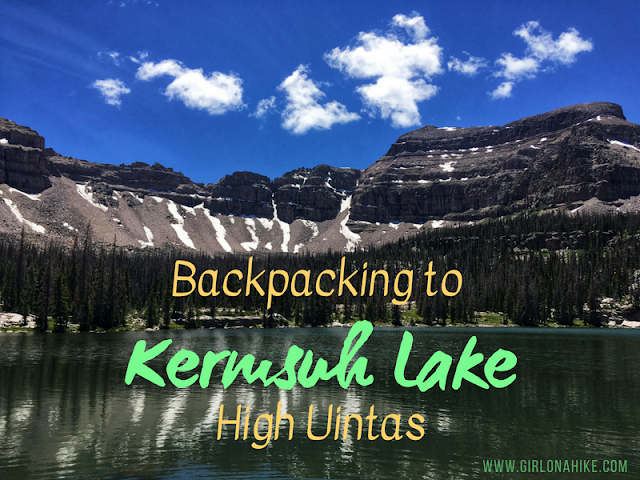
Backpacking to Kermsuh Lake
Kermsuh Lake is an alpine lake in the High Uintas Wilderness. It sits at an elevation of 10,200 ft, making it the perfect cooler destination while the SLC valley is baking in heat. Kermsuh Lake sits in one of the three basins in Christmas Meadows – Ryder and Amethyst Lake are the other two, more popular lakes. The trail is very mellow and “easy” for a backpacking trip at only 7 miles and 1,500 ft elevation gain. This trail is also very dog friendly, and can be good for fishing.

Backpacking to Ibantik Lake
Ibantik Lake (“eye-ban-tick”) is located conveniently close to the Mirror Lake Highway in the High Uintas, and backpacking this route is perfect for beginner backpackers since it’s a fairly short yet rewarding trail. It is a very popular lake to camp at, and therefore you won’t have much solitude. The best things about this lake is how clear the water is, and you’ll see plenty of mountain goats as Notch Mountain looms above you. The trail is really easy to follow, and is best done as a point-to-point route.
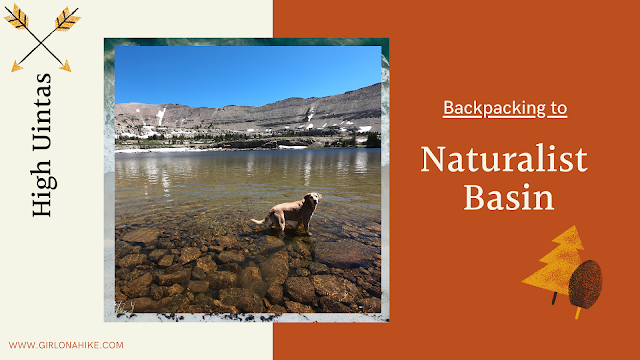
Backpacking to Naturalist Basin
Naturalist Basin is located in the High Uintas Wilderness, and home to several lakes including the popular Blue Lake and Jordan Lake. Because Jordan Lake is only 6.5 miles one way, this makes for a great backpacking destination or a bigger day hike! There are plenty of campsites to choose from and plenty of day hiking options if you decide to camp in this area. You could also explore some of the other lakes like LeConte, Walcot, and Everman lakes, or bag Spread Eagle Peak (12,540 ft)!
Recommended Gear
Nearby hike.
The Best Day Hikes in the Uintas
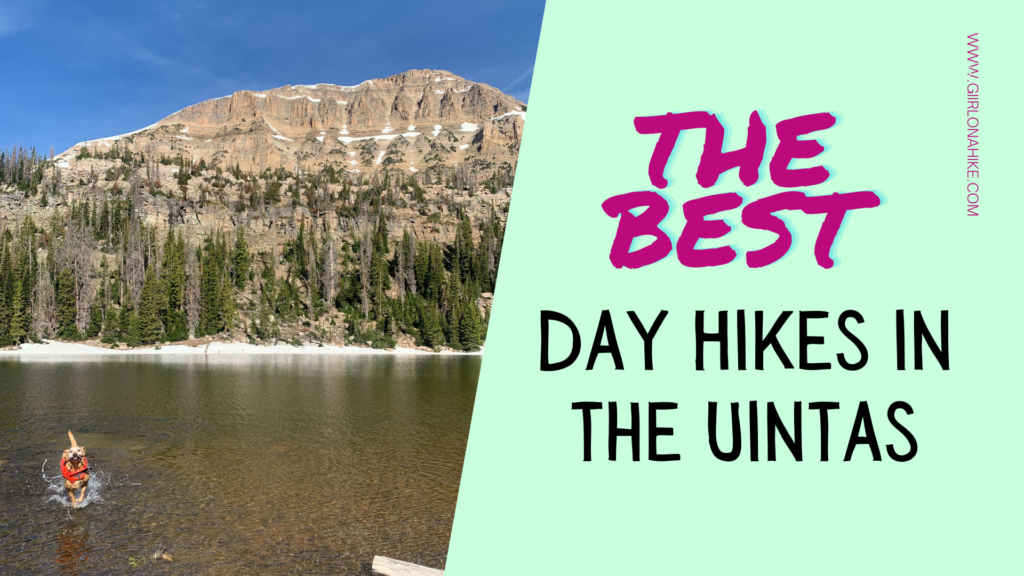
Save me on Pinterest!
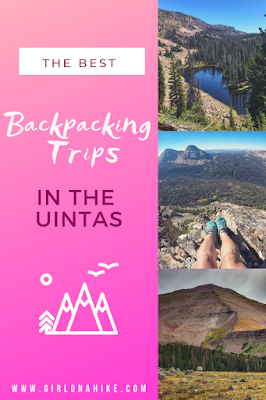
previous post

Related Posts
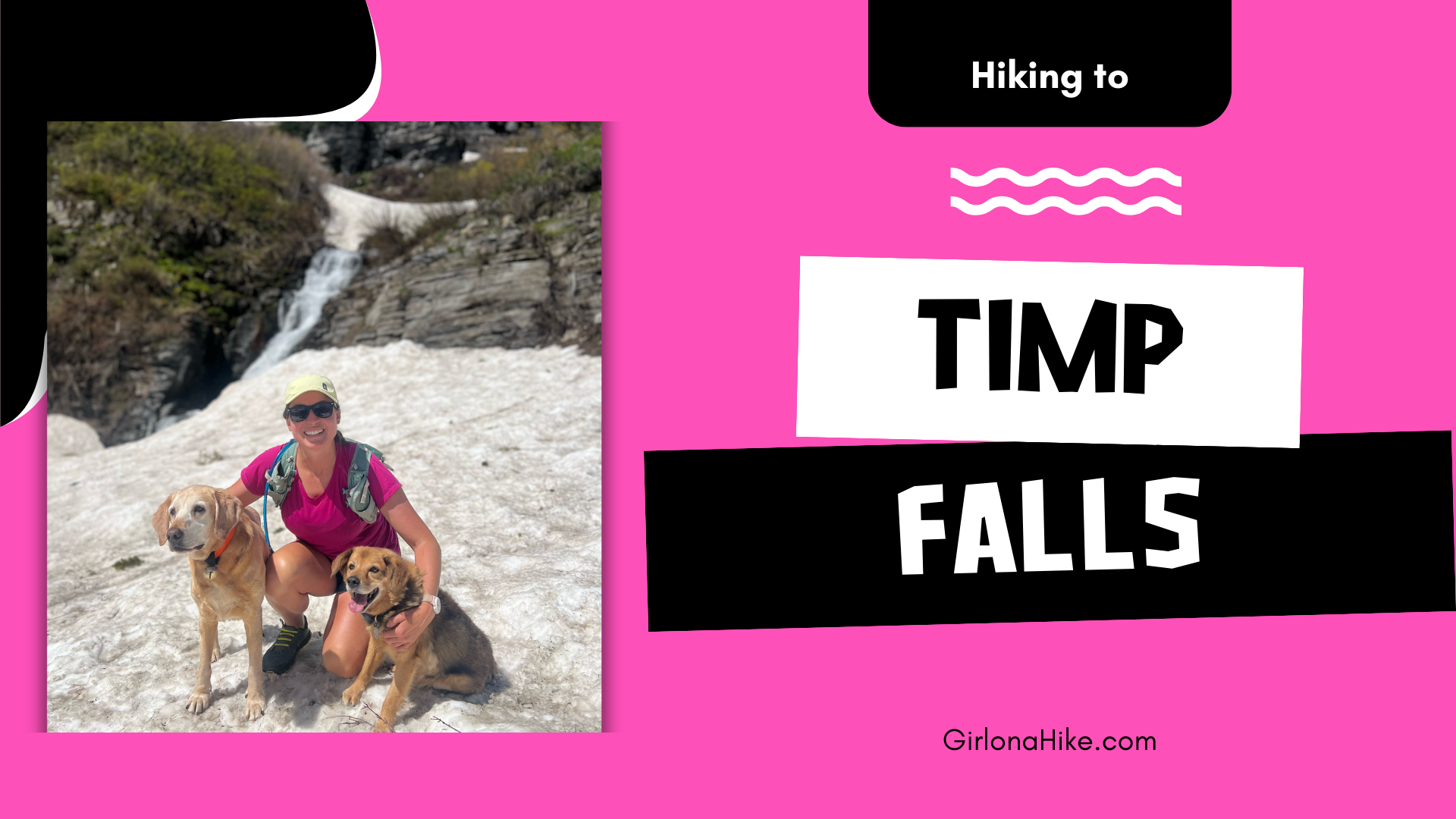
Hiking to Timp Falls, Aspen Grove Trail
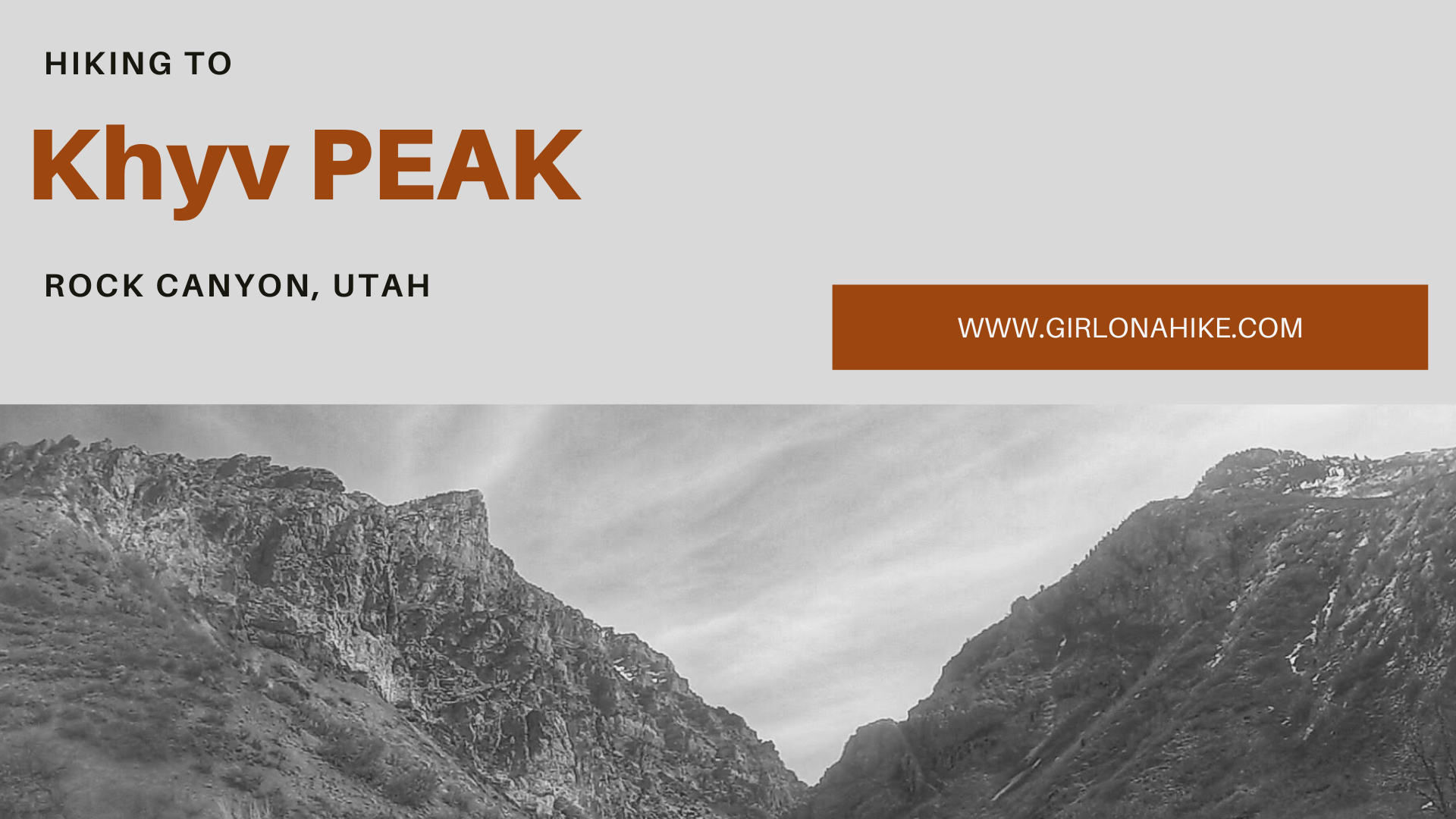
Hiking to Kyhv Peak (Formerly Squaw Peak)

Hiking to Bridal Veil Falls, Provo Canyon
Copy short link.
- Things To Do
- Backpacking
- Backpacking Red Rock Country: Southern Utah
BACKPACKING UTAH'S RED ROCK COUNTRY
Backpacking opportunities are virtually unlimited in the Canyon Country of Southern Utah. Most of this land is seldom visited, and its backcountry affords excellent opportunities for solitude and unconfined wilderness recreation. Wherever you travel here, whether down remote desert washes or up narrow, lonely canyons, you will be rewarded at the end of your trip with vivid memories and a yearning to return.
But with so many backpacking possibilities to choose from, where do you begin? To help, we’ve compiled a selection of some stellar backpack trips throughout Canyon Country’s finest destinations. From the awesomeness of Canyonlands and Zion National Parks to the seldom-visited reaches of Cedar Mesa, the Dark Canyon Wilderness, and Grand Staircase-Escalante National Monument, you are sure to find one of the following trips to your liking.
1. The Big Needles Loop (Canyonlands National Park, Needles District): 23.2 miles. A major backpacking trip covering most of the outstanding features of the Needles District of Canyonlands National Park.
2. Harvest Scene (Canyonlands National Park, Maze District): 8.7 miles. This trail is not only a rare loop (most Maze trails are out and back), but it’s also the longest designated trail in the Maze and takes hikers to Harvest Scene, one of the most famous rock art sites in the world. There are several great campsites along the route.
3. West Rim Trail (Zion National Park): 14.2 miles. A great backpack along the top of the Horse Pasture Plateau from Lava Point to the floor of Zion Canyon.
4. Owl Creek–Fish Creek Loop (Cedar Mesa): 17 miles. A multi-day loop backpack in two spectacular desert canyons. Both Owl Canyon and Fish Canyon are quite deep and narrow, with an abundance of stark, scenic beauty. During the hike you’ll pass Nevill’s Arch, two unnamed arches, and a few Ancestral Puebloan cliff dwellings and rock-art sites.
5. Dark Canyon (Dark Canyon Wilderness): 40 miles. The Dark Canyon Wilderness, south of Canyonlands National Park, offers beautiful forest and desert scenery, Indian ruins, and peace and solitude. This five- to seven-day trip is for experienced backpackers.
6. Egypt-Twentyfive Mile Wash (Grand Staircase-Escalante National Monument and Glen Canyon National Recreation Area): 20 miles. This loop hike offers a diverse desert canyon hiking experience. The hike can vary in duration, depending on the number and length of side trips taken, but requires a minimum of two long days. The recommended and more leisurely trip, with time for exploring, takes four to five days.
Well-prepared travel is responsible travel.
Do your part by planning ahead


Top 5 Overnight Backpacking Trails in Utah
- Visit our facebook
- Visit our pinterest
There’s probably about 15,678 scientific research studies that prove that nature is the best medicine (Sorry, laughter. Nature might have you beat.) Life gets crazy busy, and the first thing to go is usually something that seems like too much planning and effort — don’t let backpacking slip through your keyboard-tired fingers. Go. Just go. Camping overnight is totally doable.
Also, LEAVE NO TRACE . When you head out anywhere, please, pretty, pretty, pretty please, try not to love these places to death. Here’s a quick list of seven LNT principles:
- Plan Ahead and Prepare: Know regulations, prepare for weather hazards, avoid high times of use, visit in small groups, use a map and don’t build cairns.
- Travel and Camp on Durable Surfaces: Established trails and campsites, rock, gravel, dry grasses or snow, camp at least 200 feet from lakes and streams, walk single file in the middle of the trail, keep campsites small.
- Dispose of Waste Properly: Pack it in, pack it out, deposit solid human waste in catholes 6-8 inches deep — 200 feet from water, pack out toilet paper and other hygiene products, wash dishes with biodegradable soap 200 feet from water.
- Leave What You Find: Do not touch or take cultural or historical artifacts, leave rocks and plants as you find them, do not build structures or dig trenches.
- Minimize Campfire Impacts: Use a lightweight stove for cooking, use fire rings where fires are permitted, keep fires small, only use sticks from the ground, burn all wood and coals to ash, put out fires completely, scatter cool ashes.
- Respect Wildlife: Observe wildlife from a distance, never feed animals, store rations and trash securely, control pets at all times.
- Be Considerate of Other Visitors: Be courteous, yield to other users on the trail, avoid loud voices and noises.
5. White Pine Lake
AREA: Greater Salt Lake | Little Cottonwood Canyon LENGTH: 5 miles to the lake ELEVATION GAIN: 2,696 feet DIFFICULTY: Strenuous
Thank you, Salt Lake City, for being born right next to some of the most magnificent mountains in the whole wide world. Because it takes just 30 minutes from downtown to get to the White Pine Trailhead. Perfect for an overnight getaway from the routine in our big little city.
The trail starts out wide and easy. The incline increases once you pass the river junction where you can either take a right to Red Pine Lake, or continue left up some switchbacks up to White Pine Lake. Steep enough to get your heart pumping, and a good excuse to stop and rest and hydrate.
The lake itself will give you an awe-some perspective. You’ll take in alpine scenery and majestic mountains. Read More...
4. Ibantik Lake
AREA: Uinta Mountains LENGTH: 4.2 miles to the lake ELEVATION GAIN: 590 feet DIFFICULTY: Moderate
The Uintas are less crowded, but take a little more time to get to from the big city.
The trailhead is located just off Mirror Lake Highway (east of Kamas). When you get to Trial Lake, exit west onto a paved road. You’ll drive for about a mile until you see a fork in the road, then turn north for another mile to get to the trailhead.
Enjoy passing lakes and smaller ponds on your way into Ibantik. Seriously, enjoy it.
3. Mount Timpanogos
AREA: Utah Valley | Provo or American Fork Canyon LENGTH: From Aspen Grove to Summit: 8 miles one way, Camp: ¾ way to Emerald Lake (6.5 miles to the lake) | From Timpooneke Road: Summit: 7.5 miles one way, Camp: just as you enter the basin at about 10,000 feet ELEVATION GAIN: 4,580 feet DIFFICULTY: Strenuous
Girls and boys start hiking this amazing peak around age ten. It’s strenuous, but doable. Either trail will take most of the day to hike in. Take advantage of grand view for photo ops and to catch your breath. Read More...
2. Zion National Park's West Rim Trail
AREA: Zion National Park LENGTH: 14.5 miles one way ELEVATION GAIN: 2,510 feet DIFFICULTY: Moderate
You’ll basically be absorbed into Zion’s sheer-cliff sandstone beauties, summit Angels Landing , and continue on to more undeniably gorgeous views. Your breath will catch over and over again as you come into contact with a grand western landscape. Read More...
1. Neon Canyon and Golden Cathedral
AREA: Grand Staircase-Escalante LENGTH: 9.2 miles ELEVATION GAIN: 1,260 feet DIFFICULTY: moderate
The Grand Staircase-Escalante National Monument is one of the nation’s remotest and interesting landscapes. Canyons, washes and epic night skies draw adventurers here with a magnetic pull no one can resist once they’ve been here for the first time. You’ll want to come back and explore until the day you die.
Neon Canyon and Golden Cathedral require some technical know-how and gear. You’ll need ropes for rappelling and, depending on the time of year, you might want dry suits. CHECK THE WEATHER REPORT when going into canyon country. Flash floods are for real, and they’re devastating. Read More...
Views like this delivered to your inbox
Categories:.
BACK TO TOP
TOUR DE FRANCE
Don’t miss a moment with our daily newsletter.
THE TOUR DE FRANCE DAILY NEWSLETTER

What’s the best three- to four-day backpacking route in Utah?
My friends and I are planning a backpacking trip to Utah, but we're at a loss as to where to go. We're looking for a three- to four-day trip, so something in the range of 18 to 25 miles or so, give or take. If possible, we'd love to spend some time in slot canyons, but that's not really the focus. Landon H. Boulder, CO
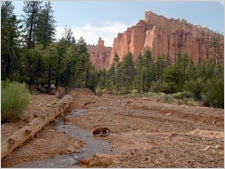
Don't miss a moment of the 2024 Tour de France! Get recaps, insights, and exclusive takes with Velo's daily newsletter. >","name":"in-content-cta","type":"link"}}'>Sign up today! .
A reputation for miles of salt flats159 to be exactmight deceive any traveler from thinking much else exists in Utah besides buoyant lakes and world-class skiing. But south of Salt Lake City are a whopping five national parks (Bryce, Zion, Arches, Canyonlands, and Capitol Reef) and a national recreation area (Glen Canyon) as well as other surreal and alluring landscapes that fall within the National Park Systems. Predominantly surrounded by sandstone, the region has been carved over millions of years by rains and rivers, forming famed monuments such as the Delicate Arch and a majority of the slot canyons common throughout Utah’s southern region. Such dramatic views make for ideal backpacking over hundreds of miles of trails throughout the desert landscape. Here are a few that make those miles all worthwhile.
Under-the-Rim Trail
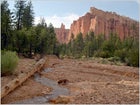
Serious backcountry hiking means often going without seeing another soul on the trail – unless it’s another backpacker, of course. Bryce Canyon National Park is a 56-square-mile natural amphitheater with an expanse of limestone canyons and spires, or “hoodoos.” Check out the crowd-choked overlooks, then leave the people behind by dropping onto the Under-the-Rim Trail, which you can follow from 8,250-foot Bryce Point to Rainbow Point for 22.9 miles along the Paunsaugunt Plateau, with panoramas of natural amphitheaters, ponderosa forests, and alpine meadows. Highlights of this backcountry adventure include the Hat Shop (boulders perched atop dirt pedestals), a tilted plateau at Swampy Butte, the Natural Bridg,e and a 2.9-mile hike to the views from Rainbow Point at the end. Total elevation gain is approximately 1,500 feet with numerous climbs and descents along the way. Six campsites mark the trailRight Fork Yellow Creek, Yellow Creek, Sheep Creek, Right Fork Swamp Canyon, Swamp Canyon, Natural Bridge, and Iron Spring. Water sources are limited, and packing in a gallon per day per person is recommended. Bryce Point is accessible via shuttle during summer months. Permits are available at the visitor center and start at $5. But one thing to keep in mind: this is an out-and-back trail, not a loop. So either arrange for a shuttle, or be ready to hoof it to the nearest park bus stop after the hike. There’s also a fair amount of spill outs onto the main, paved canyon road if you end up wanting to cut the trip short (sometimes the Utah sun can be unforgiving!).
For a backcountry hike that offers both outlandish obstacles as well as funky rock formations, the trail from Coyote Gulch to Hurricane Wash in Glen Canyon National Rec Area satisfies. With two arches, a natural bridge, and several waterfalls, this 26-mile trail has become the site’s most popular. Start the hike at Red Well trailhead and you’ll get top-notch scenery not to mention quicker access to water. Beginning as a wide, sandy wash and narrowing to a canyon with towering walls, Hurricane Wash joins the lush riparian zone of Coyote Gulch approximately five miles from the trailhead. Hikers will conquer the first obstacle at Cliff Arch after reaching the second waterfall. Below the arch, daredevils can follow a ledge along the south wall about 100 feet downstream to find an opportunity to descend from the narrow footing. The next adventure is an nearly-impassable boulder jam located approximately half a mile up Coyote Gulch from the Escalante River. To navigate the boulders, follow the trail on the right side of the stream across the lower portion of a sand slide and then slowly descend the steep slickrock slope. Hike from Fortymile Ridge to Crack-in-the-Wall and scramble through the crack to a steep sand dune and lower Coyote Gulch. Just be prepared for the steep hike back up. You’ll also encounter Lobo Arch, Coyote Natural Bridge, and Stevens Arch along the way. Contact the visitor center in Escalante for permit information and weather conditions.
Zion National Park is next door neighbor to Bryce Canyon, and at 229 square miles just 15 miles long. While backpackers won’t find many common backcountry “trails,” they will find a uncommon hike along the Zion Narrows. Carved by the Virgin River, the Narrows is a 16-mile gorge in upper Zion Canyon with 2,000-foot high sheer sandstone walls, caves, and hanging gardens. The river is your guide as well as 60% of the trail, so special preparation (such as water proof sandals) is required for this unique adventureand also one of the reasons the hike was ranked #5 on National Geographic ‘s list of America’s Best 100 Adventures. Hiking from top to bottom will take you through “Wall Street,” a two-mile section where walls close to just 22-feet wide at the top of the canyon. Natural springs and waterfalls abound, and be prepared to hike waist-deep through the water or opt to take a swim along the route. Only 11 overnight campsites are available in the Narrows, so make sure to call ahead and obtain a permit. The final leg of the Narrows ends at the Temple of Sinawa where you can catch the park shuttle back to the visitor center. Before planning your trip, make sure to contact the Zion Canyon Visitor Center to obtain a backcountry permit and check weather conditions. This unique area is also a hot spot for flash flooding due to tight canyon quarters and thunderstorms that often occur miles upstream. The hike itself is open and passable Nov-May, but the cold water requires wearing a wet or dry suit, while March to early June calls for high water because of spring snowmelt; the best time to hike would be mid-summer through fall. But with proper planning and attention to surroundings, the Narrows can be a 16-mile hike like no other. Amy A. Clark
- Adventure Adviser
- Zion National Park
Popular on Outside Online

Enjoy coverage of racing, history, food, culture, travel, and tech with access to unlimited digital content from Outside Network's iconic brands.
© 2024 Outside Interactive, Inc
Travelling is ultimately a tool for growth. If you want to venture further, click this banner and take the leap 😉
- Meet the Team
- Work with Us
- Czech Republic
- Netherlands
- Switzerland
- Scandinavia
- Philippines
- South Korea
- New Zealand
- South Africa
- Budget Travel
- Work & Travel
- The Broke Backpacker Manifesto
- Travel Resources
- How to Travel on $10/day
Home » North America » USA » Utah
Backpacking Northern Utah Travel Guide | Updated 2024
Utah. Home to incredible natural beauty and spectacular national parks. From the majestic Red Rock to the trippy spires of Zion and Bryce Canyon National Parks, Utah will leave you speechless a lot of times.
Whether you want to visit the delicate stone arches or the surreal landscapes of Grand Staircase Escalante, you’ll need more than just a couple of days to fit everything in.
Lots of travelers have only seen the South of Utah, and don’t get us wrong, it’s absolutely stunning down there, but the real hidden gems can only be found in the North.
Since it’s not a massively popular backpacker destination, we’ve created this Backpacking Northern Utah Travel Guide, with all of the tips and tricks you’ll need for a successful adventure. From safety and insurance to where to stay and eat, we’ve got everything covered for you.
Let’s get right to it!
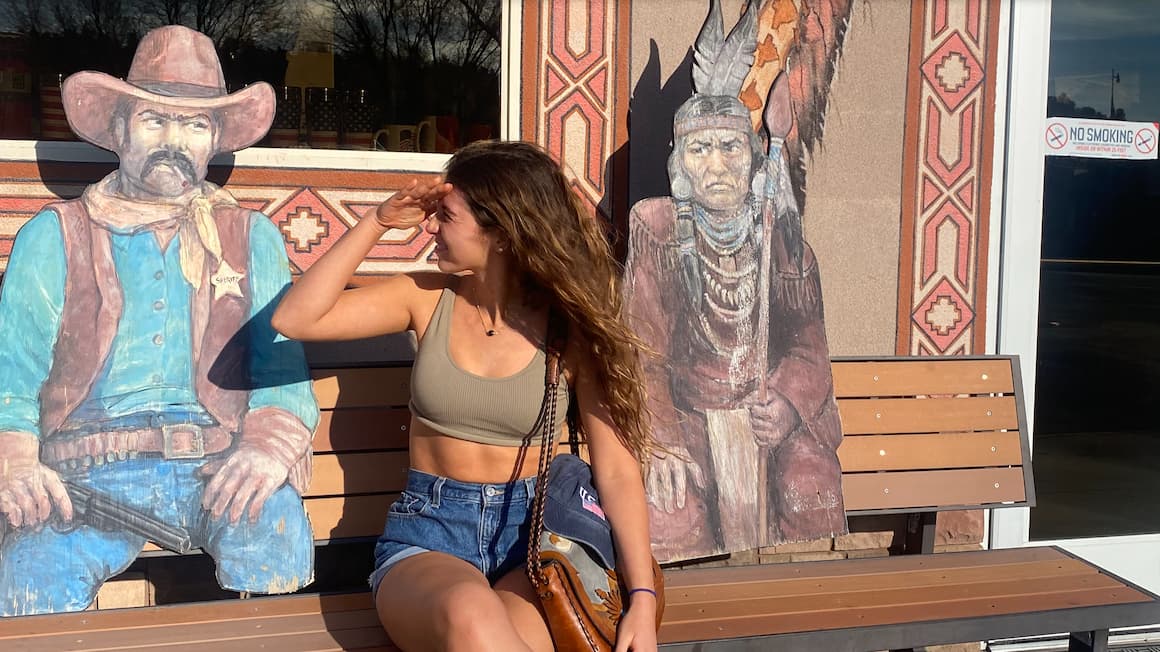
The Broke Backpacker is supported by you . Clicking through our links may earn us a small affiliate commission, and that's what allows us to keep producing free content 🙂 Learn more .
What to expect from Backpacking Northern Utah
Best places in northern utah, backpacker accommodation in northern utah, northern utah travel tips, safety in northern utah, northern utah travel guide – getting in and around, northern utah backpacking costs, must-try experiences in northern utah.
If you’re backpacking in the USA and spontaneously decide to explore the Northern part of Utah, you’re definitely in for a treat. But only if you’re properly prepared. With many outdoor activities, the area is perfect for sport-enthusiast, real adventurers, and travelers that don’t mind getting a bit sweaty on the way.
With numerous mountains, lakes and reservoirs, pioneer and Native American heritage, and Utah’s biggest cities, you’ll need quite a bit of time on your hands to explore everything. Northern Utah is not a place where you can spend a weekend and expect to see all of the attractions. Even if you just want to road trip around the national parks , you’ll need at least a week to fit everything in.
There are amazing mountainous parks and forests where you can ski, snowboard, hike, bike or camp, so you’ll have to be prepared for your trip. Leave you flip-flops at home and pack your hiking boots instead, backpacking Northern Utah will be a real adventure!
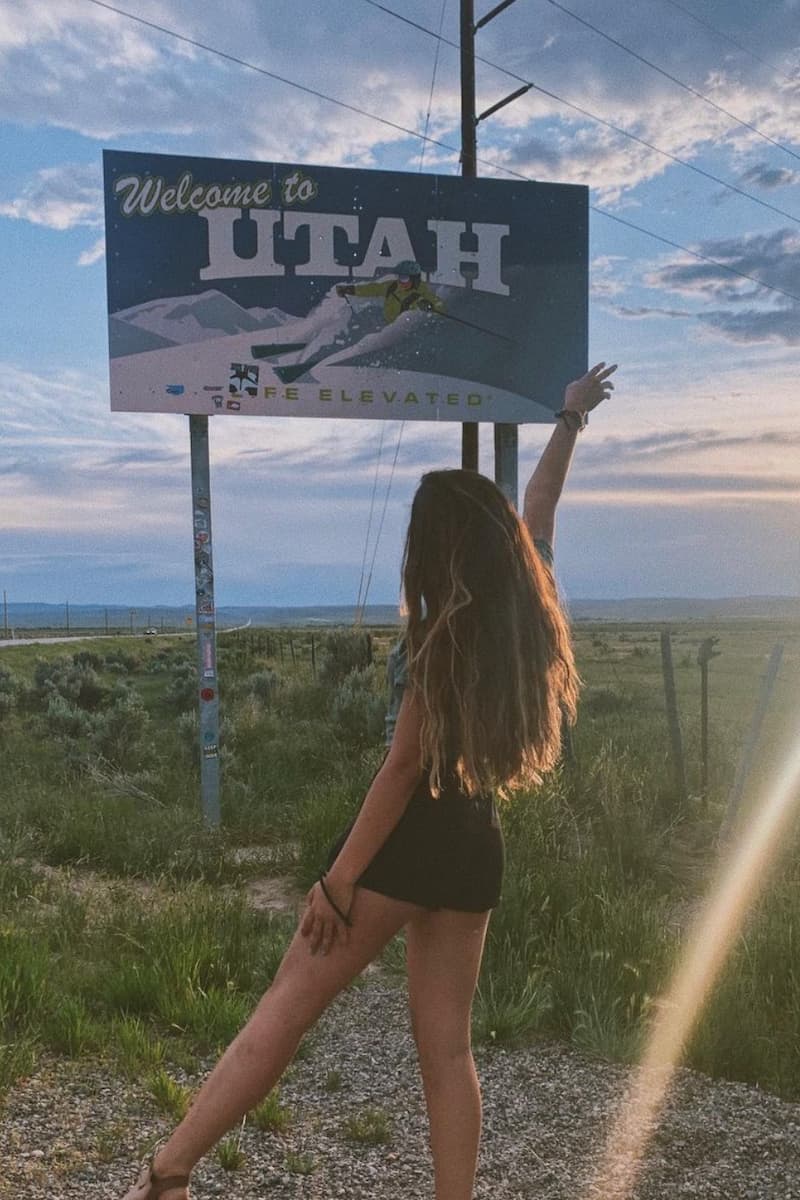
Most people would have heard of Salt Lake City, the largest city in Utah, perhaps best known as the home to the headquarters of the Church of Jesus Christ of the Latter Day Saints – the Mormons. But what you may not realize is that while backpacking Northern Utah you can also see a lot more.
There are National parks brimming with dinosaur fossils, attractive historic towns, world-class skiing mountains, and endless other options. Knowing what you want to explore and see before you start your trip is highly recommended, especially when you have to calculate in the travel time in between the attractions.
We’ve listed the best places in Northern Utah, to make it a bit easier for you.
Discovering Mormon History in Salt Lake City
Even if you aren’t even remotely religious, a visit to the Mormon stronghold of Salt Lake City is a must-do while backpacking Northern Utah. The city offers beautiful architecture, a riverside walking trail, and a beautiful Temple Square. The 35 acres of historic buildings are going to take you back in time.
If you’re interested, the LDS Church offers free tours of a few buildings in Temple Square, where they talk about the roots of the religion.
Salt Lake City is an attraction in itself. If you’re backpacking Northern Utah, the likeliness that you’ll end up here is pretty high. Since there are so many things to do in Salt Lake City , some travelers simply get stuck here for quite some time.
Strolling the Historic 25th Street
Historic 25th Street, once derided as Salt Lake City’s badass little sister, is now an attractive main street filled with unique stores, thriving restaurants, and cafes, all housed in beautifully restored brick buildings. Locals take pride in their lively streets with regular festivals and a weekly Farmer’s Market.
It is a vibrant and fun place to spend a Saturday morning in summer, with a variety of vendors selling locally-made products and pretty much anything else you can think of. There are also food stalls and live music. 25th Street should definitely be on your list while backpacking Northern Utah.
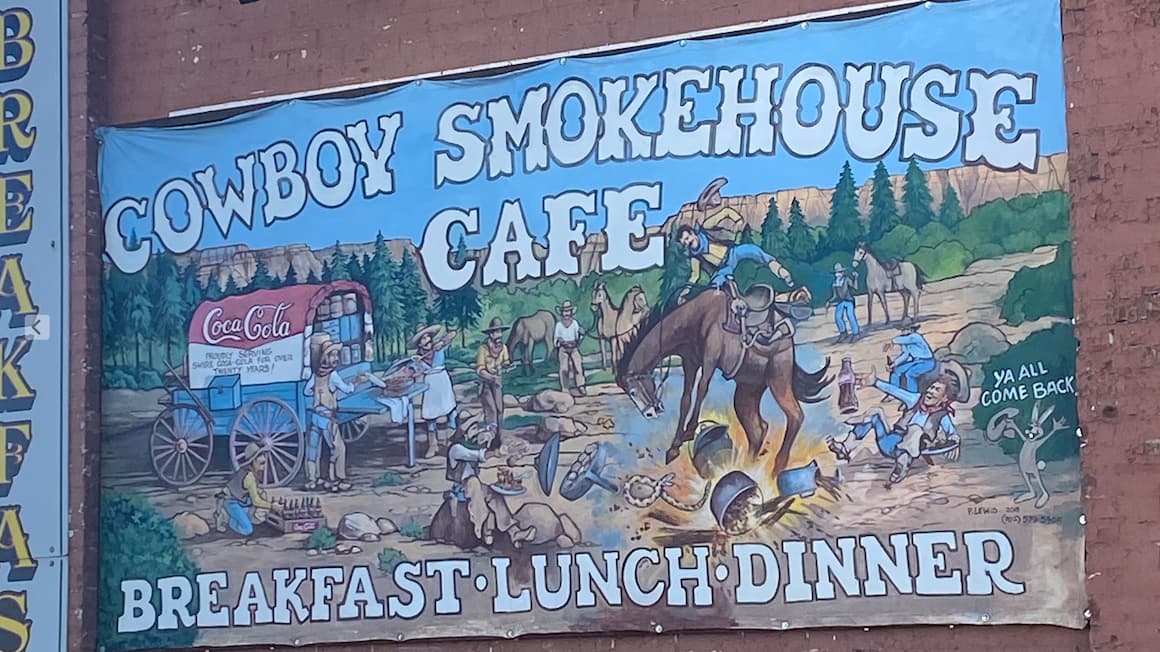
Experiencing the Beauty of Antelope Island
A starkly desolate place where bison and pronghorns roam, Antelope Island is an otherworldly delight. Only a short drive from Salt Lake City, it is the largest island in the Great Salt Lake and the perfect place to hike through yellowed grasslands and over rocky outcroppings.
You can admire the contrast of colors from the bright white of salt flats through to the vegetation of browns, greens, and reds. Swimming in the super salty (and floaty) Great Salt Lake where it is almost impossible to sink is a great experience too. You can be almost 100% sure that the only living souls you’ll meet on this island are the furry bison – perfect for clearing the mind and getting inspired by nature.
If you want to relax and unwind in nature, you might also like to check out the USA yoga retreats in Utah for a more tranquil way of exploring the state.
Exploring the Vibrant Mountain Town of Park City
I love mountain towns with their super friendly communities, and cute main streets set amongst surrounding peaks. Park City is no exception. I only got to visit for a day but Park City instantly impressed me with its beautiful downtown filled with loads of excellent dining choices, art galleries, and boutiques. I even spied an original Banksy on one of the exterior walls of a building.
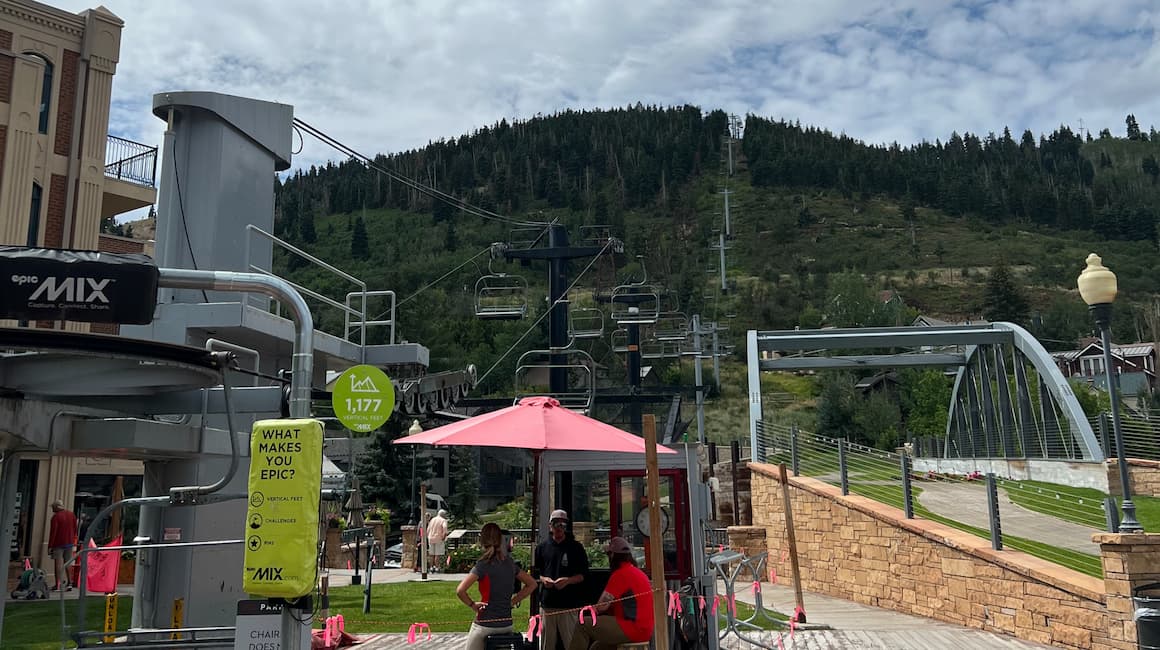
People-watching is great here with so many local outdoorsy folks of different ages, stopping to chat with one another on the street. During the snowy wintertime, this town comes into its own with world-class skiing at any of the nearby ski resorts. It also has the World’s only ski-in gastro pub – definitely worth checking out!
Hiking in the Wasatch Mountains
This iconic mountain range stretches 160 miles from the Utah/Idaho border, south through central Utah. Anywhere you go while backpacking northern Utah, these mountains will be in view. The Wasatch Range is the western edge of the Rocky Mountains, and although not as lofty as the Colorado Rockies, the Wasatch are rugged and formidable, with a red tinge that makes them glow like hot embers at sunset.
There are many places to hike in these mountains. We chose to do a hike to the summit of Bald Mountain, from the Silver Lake Resort near Park City. This trail offered dramatic scenery of the Jordanelle Reservoir and surrounding peaks, windswept and exposed with only sparse vegetation. I slept comfortably in my camping hammock & woke up to the most incredible view! It wouldn’t be a backpacking northern Utah trip without exploring the Wasatch Mountains.
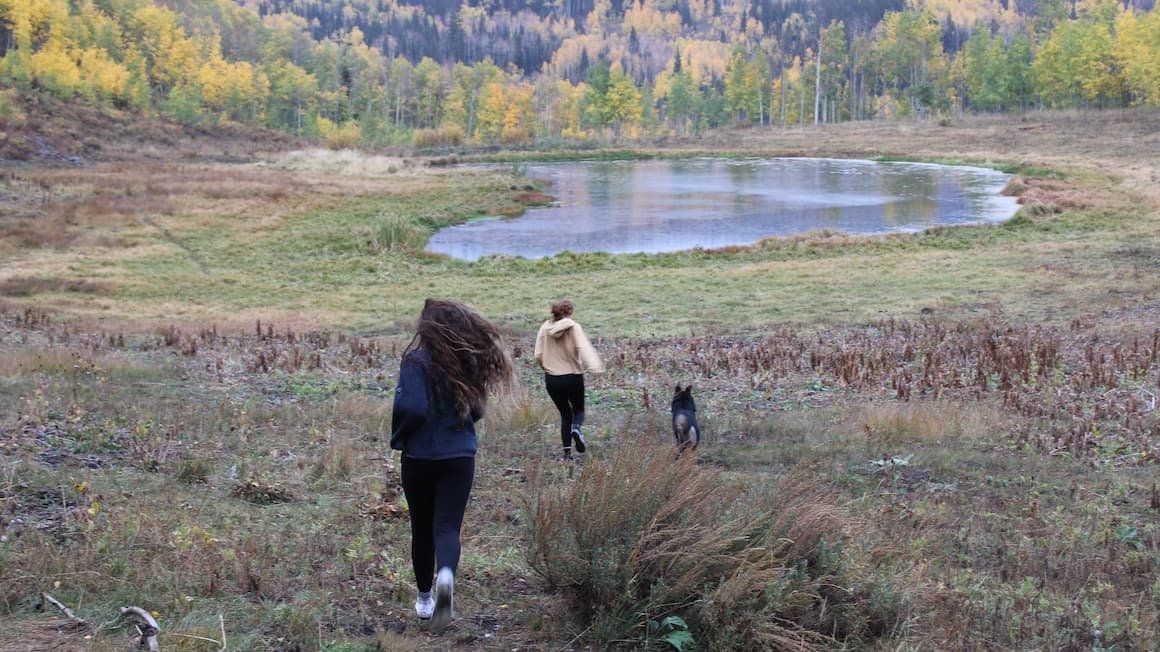
Soaking up the Small Town Charm in Logan
Cute and charming Logan, a small town about an hour north of Ogden, is a great day trip destination. With a strollable main street perfect for grabbing a bite to eat and exploring the shops on vibrant Federal Ave, Logan is quintessential, small-town America.
From Logan, you can continue driving further north, through the stunning Logan canyon where you can hike, and leaf peep in the Fall. End the drive at peaceful Bear Lake, which straddles the border of Utah and Idaho: a refreshing spot with sandy beaches and cool waters to swim in during hot summer days.
Experience Prehistory at Dinosaur National Monument
See the wall of over 1,500 dinosaur bones at the Quarry Exhibit Hall, hike above a stunning canyon surrounded by multi-colored rock mountains, and drive through spectacular desert landscapes – Dinosaur National Monument offers so much to see and do. Straddling the border between Utah and Colorado, Dinosaur National Monument is one of the best places in the world to see Jurassic period dinosaur remains.
The park is also known for its petroglyphs, left by the Fremont people approximately 1,000 years ago. This virtually unknown National Park was a memorable destination for me while backpacking northern Utah.
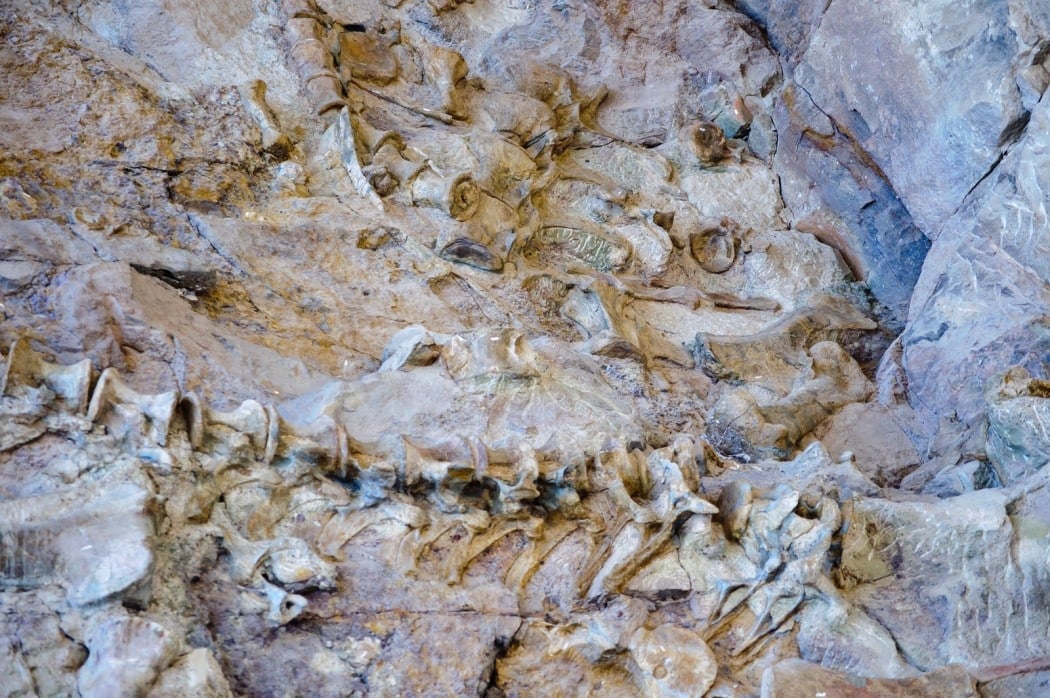
Tubing the Weber River
The ultimate way to cool off in the hot summer months is tubing the Class II rapids of the windy Weber River. It is a popular pastime for locals and visitors alike. It’s two hours of blissful floating – with the occasional adrenaline rush when you hit tumultuous rapids – along a river that takes you under gorgeous red mountains, pulling up onto rocky beaches for breaks along the way.
You can also get your own tubes and lifejackets (mandatory and regulated) and do it yourself, but you will need two vehicles for this. The starting lot is off exit 112 on Highway 84, with the end lot located at exit 108. Alternatively, you can do it through a company called Barefoot Tubing which is based out of Morgan, a small town north-east of Salt Lake City. Either way – if you are backpacking northern Utah this summer, you should definitely do it!
To find out more about white water adventures in Utah, check out this post on rafting the Green River .
Scrambling into Willard Canyon
Definitely not for the faint of heart, Willard Canyon is all overgrown trails, steep and narrow with slippery gravel. Make sure you wear sturdy shoes for this. We may have only ventured in part of the way, but what we did see was beautiful, as was the view of the Great Salt Lake, glimpsed while trying to navigate the precarious path.
Even if you don’t try entering the canyon, it is a beautiful spot to admire the lake and the surrounding mountains and there are trails down to the small Willow Creek Park. It’s a nice stopover if you are heading between Logan and Ogden/Salt Lake City.
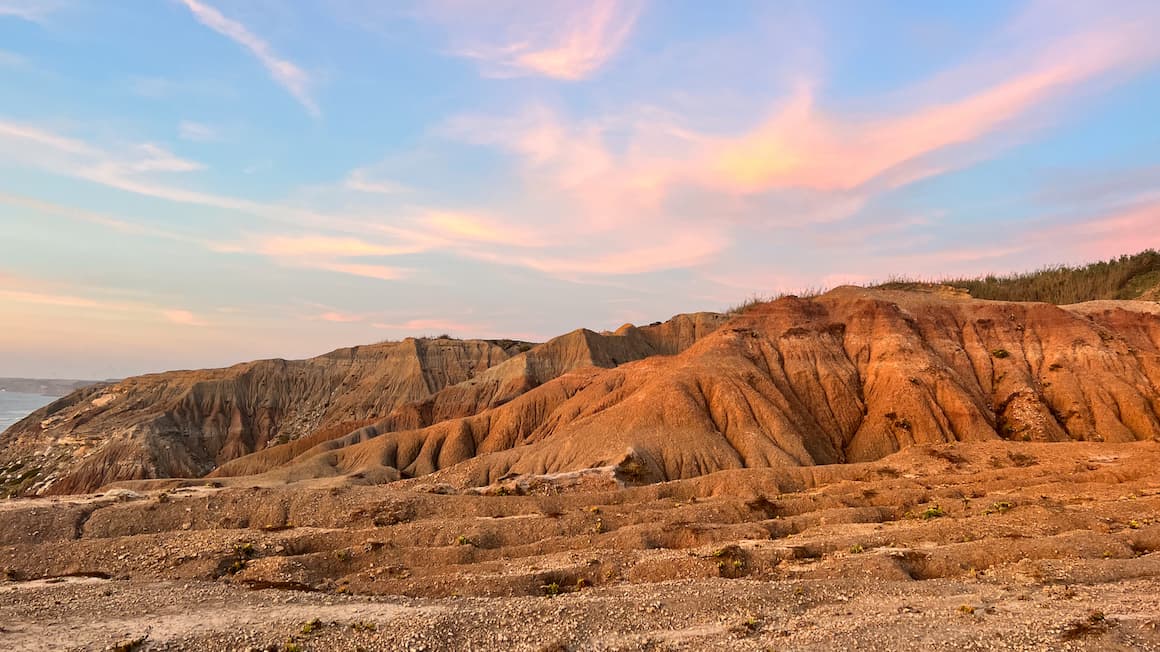
Park City Hostel
Park City Hostel, just across the mountains from Salt Lake City and right next to the continent’s biggest ski slopes is the coolest hostel in Utah!
- Late check-out
Budget accommodation options in Northern Utah are plentiful. Backpackers can choose anything from camping grounds, B&Bs in Utah , and simple hostels in Salt Lake City to cabins in Park City , and everything in between. Couchsurfing is another popular option.
You’ll find hostel and Couchsurfing options mainly in the bigger cities like Ogden, Salt Lake City , and City Park. If your budget allows it, you could also have a look at the great Airbnbs in Salt Lake City – there are some unique hidden gems that hardly anyone knows about.
A great way to explore the US is by getting an RV (recreational vehicle). You can easily find RV parks and campgrounds near Salt Lake City. Staying in an RV will give you more freedom than any of the other accommodation types.
Here are a few options for accommodation while backpacking northern Utah:
Camping in Northern Utah
- KOA Salt Lake City: The closest full-service RV Park to Salt Lake City, this KOA also offers spots for tents. It has a pool, a hot tub and even a camp kitchen. There is a free shuttle into Temple Square.
- Jordanelle State Park: Located close to Park City in the beautiful Heber Valley, Hailstone Campground in Jordanelle State Park offers tent and RV camping with full hook-ups, on the shores of a reservoir that is popular with boaters and fishermen.
- Antelope Island State Park: There are four small, basic camping grounds on Antelope Island open to tents and self-contained RVs.
- Willard Bay State Park: Only a 20-minute drive from Ogden off the highway north to Logan, Willard Bay State Park offers camping right on the Great Salt Lake with a swimming beach, marina, and hot showers. There are three camping grounds within the park offering tent camping and full-RV hookups.
- Dinosaur National Monument: There are three campgrounds located in the Utah section of the National Monument: Split Mountain, Green River and Rainbow Park. All of the camping grounds offer basic facilities with no showers or hook-ups.
Apart from Camping, there are some great hostel options you can choose from. Before you book, make sure where you want to stay.
If you’re staying in Salt Lake City , there are lots of neighborhoods to stay in and you can get quite lost. It helps to know what you want to explore so you won’t end up staying miles from the attractions you want to see.
If you’re interested in staying in amongst nature, check out our guide to the best cabins in Utah .
What to Pack for Northern Utah
On every adventure, there are six things I never go traveling without:

Travel Security Belt
This is a regular looking belt with a concealed pocket on the inside – you can hide up to twenty notes inside and wear it through airport scanners without it setting them off.

Microfiber Towel
Hostel towels are scummy and take forever to dry. Microfibre towels dry quickly, are compact, lightweight, and can be used as a blanket or yoga mat if need be.

Petzl Actik Core Headlamp
A decent head torch could save your life. If you want to explore caves, unlit temples, or simply find your way to the bathroom during a blackout, a headtorch is a must.

‘Monopoly Deal’
Forget about Poker! Monopoly Deal is the single best travel card game that we have ever played. Works with 2-5 players and guarantees happy days.
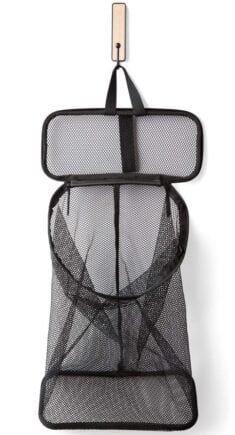
Hanging Laundry Bag
Trust us, this is an absolute game changer. Super compact, a hanging mesh laundry bag stops your dirty clothes from stinking, you don’t know how much you need one of these… so just get it, thank us later.
For plenty more inspiration on what to pack, check out my full backpacking packing list.
Books to read about Northern Utah/ Travel Resources
- Utah Road Map – An easy to read road map you can buy online for your Northern Utah adventures especially if you plan on hitchhiking and camping along the way.
- Lonely Planet Southwest USA (Travel Guide) – A Lonely Planet is always a great book to have handy while backpacking. There is so much to do in Northern Utah and this book lays it all out excellently.
- Fodor’s Utah – It highlights the best of Utah, including awe – inspiring national parks from Arches to Zion, great hiking trails and also talks about Salt Lake City s cultural riches. If you want to explore the National Parks, this book is a great choice.
- 50 Best short hikes in Utah’s national parks – Lists the best hiking routes in each park that are both “must see” and accessible. It includes distances, highlights, area maps, and easy-to-follow trailhead directions to make hike selection fast and efficient. A must read for hikers.
- Moon Utah – The authors include great trip strategies that utilise Utah’s amazing outdoor attractions and unique history. Provides tools that travellers need to create a more personal and memorable experience.
Check out Backpacker Safety 101 for tips and tricks to stay safe whilst backpacking.
Pick yourself up a backpacker securit y belt to keep your cash safe on the road.
I strongly recommend travelling with a headlamp whilst in Northern Utah (or anywhere really – every backpacker should have a good headtorch!) – check out my post for a breakdown of the best value headlamps to take backpacking.
Travel Insurance for Northern Utah
Traveling without insurance would be risky so do consider getting good backpacker insurance sorted before you head off on an adventure.
I have been using World Nomads for some time now and made a few claims over the years. They’re easy to use, professional and relatively affordable. They may also let you buy or extend a policy once you’ve started your trip and are already abroad which is super handy.
If there’s one insurance company I trust, it’s World Nomads.
ALWAYS sort out your backpacker insurance before your trip. There’s plenty to choose from in that department, but a good place to start is Safety Wing .
They offer month-to-month payments, no lock-in contracts, and require absolutely no itineraries: that’s the exact kind of insurance long-term travellers and digital nomads need.

SafetyWing is cheap, easy, and admin-free: just sign up lickety-split so you can get back to it!
Click the button below to learn more about SafetyWing’s setup or read our insider review for the full tasty scoop.
As with most of the United States, northern Utah is best explored by car so if you have your own vehicle, getting around will be easy. If not, hiring a car will be your best bet and with prices starting from around $18 per day, this is a cost-effective option, especially if you are backpacking northern Utah with a group and can split the cost.
Alternatively, getting between Salt Lake City Airport, Salt Lake City, and Ogden is easy and cheap with regular trains. There are also regular buses between Salt Lake City and Park City. Getting to smaller towns and natural attractions such as Antelope Island would be difficult without a car but you could look into ride sharing or taking a tour.
Uber is hands down the best way to get around cities, the price is locked in on the app so you can’t get ripped off and it will always work out cheaper than travelling by taxi. Click here and your first three rides are discounted (plus my next ride will be too – cheers!).

Get 15% OFF when you book through our link — and support the site you love so dearly 😉
Booking.com is quickly becoming our go-to for accommodation. From cheap hostels to stylish homestays and nice hotels, they’ve got it all!
Top Tips for Budget Backpackers Exploring Northern Utah
To keep your spending to an absolute minimum whilst backpacking Northern Utah I recommend sticking to the three basic rules of budget adventuring….
- Hitchhike: Thumb a ride! People are generous and forthcoming. It would be a shame not to give this a shot. Hitchhiking in Northern Utah is an ace way to keep your transport costs down.
- Camp: With plenty of gorgeous natural places to camp at as well as numerous campsites, Utah is an excellent place to carry a tent . If you’re craving some company or local experience, jump on Couchsurfing or Airbnb and get a kickass local taste of the place.
- Cook your own food: Carry a pocket rocket stove on your backpacking trip. Use this little guy to cook up some quick meals for you and your amigos. So get cooking and save a ton of money!
- Pack a travel water bott l e and save money every day!
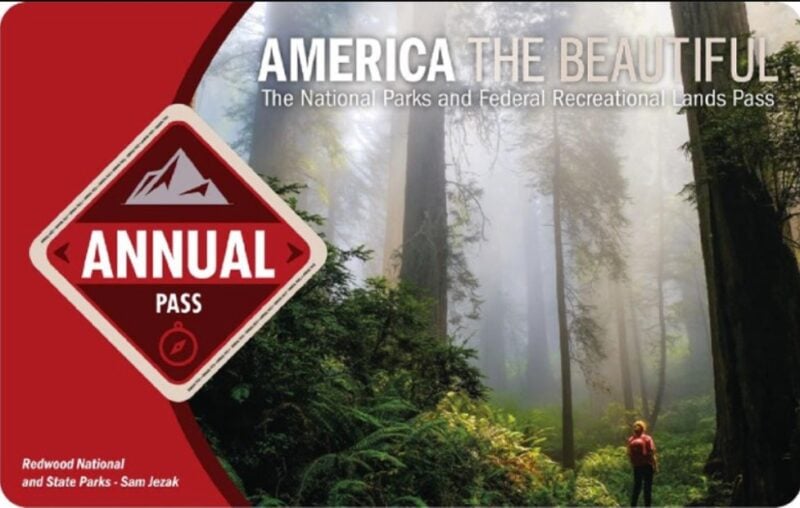
Planning on hitting up a few parks during your grand USA adventure? Visiting two of them can run you $70 in entry fees alone. Or you buy the ‘America the Beautiful Pass’ for $80 and gain FREE UNLIMITED ACCESS to 2000+ federally managed sites including ALL national parks.
You’d have to be a dunce not to invest.
Volunteering in Utah
Long-term travel is awesome. Giving back is awesome too. For backpackers looking to travel long-term on a budget in Utah whilst making a real impact on local communities, look no further than Worldpackers . World Packers is an excellent platform connecting travelers with meaningful volunteer positions throughout the world .
In exchange for a few hours of work each day, your room and board are covered.
Backpackers can spend long periods of time volunteering in an awesome place without spending any money. Meaningful life and travel experiences are rooted in stepping out of your comfort zone and into the world of a purposeful project.
Worldpackers opens the doors for work opportunities in hostels, homestays, NGOs, and eco-projects around the world. We’ve tried and approved them ourselves – check out our Worldpackers in-depth review here.
If you’re ready to create a life-changing travel experience and give back to the community, join the Worldpacker community now. As a Broke Backpacker reader, you’ll get a special discount of $10. Just use the discount code BROKEBACKPACKER and your membership is discounted from $49 a year to only $39.

Worldpackers: connecting travellers with meaningful travel experiences.
Make Money Online Whilst Backpacking in Utah
Traveling or living in Utah long-term? Keen to make some cash when you are not exploring the desert?
Teaching English online is a great way to earn a consistent income—from anywhere in the world with a good internet connection. Depending on your qualifications (or your motivation to obtain qualifications like a TEFL certificate) you can teach English remotely from your laptop, save some cash for your next adventure, and make a positive impact on the world by improving another person’s language skills! It’s a win-win! Check out this detailed article for everything you need to know to start teaching English online .
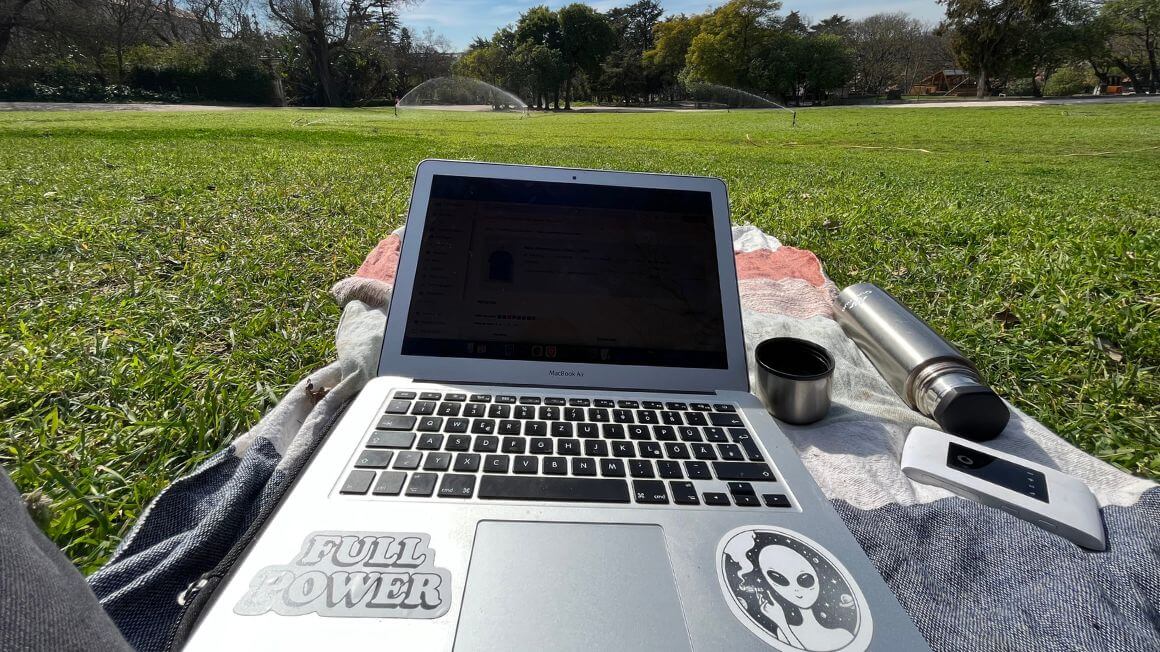
In addition to giving you the qualifications to teach English online, TEFL courses open up a huge range of opportunities and you can find teaching work all over the world. To find out more about TEFL courses and how you can teach English around the world, read my in-depth report on teaching English abroad .
Broke Backpacker readers get a 50% discount on TEFL courses with MyTEFL (simply enter the code PACK50), to find out more, please read my in-depth report on teaching English abroad.
Whether you are keen to teach English online or looking to take your teaching game a step further by finding a job teaching English in a foreign country, getting your TEFL certificate is absolutely a step in the right direction.
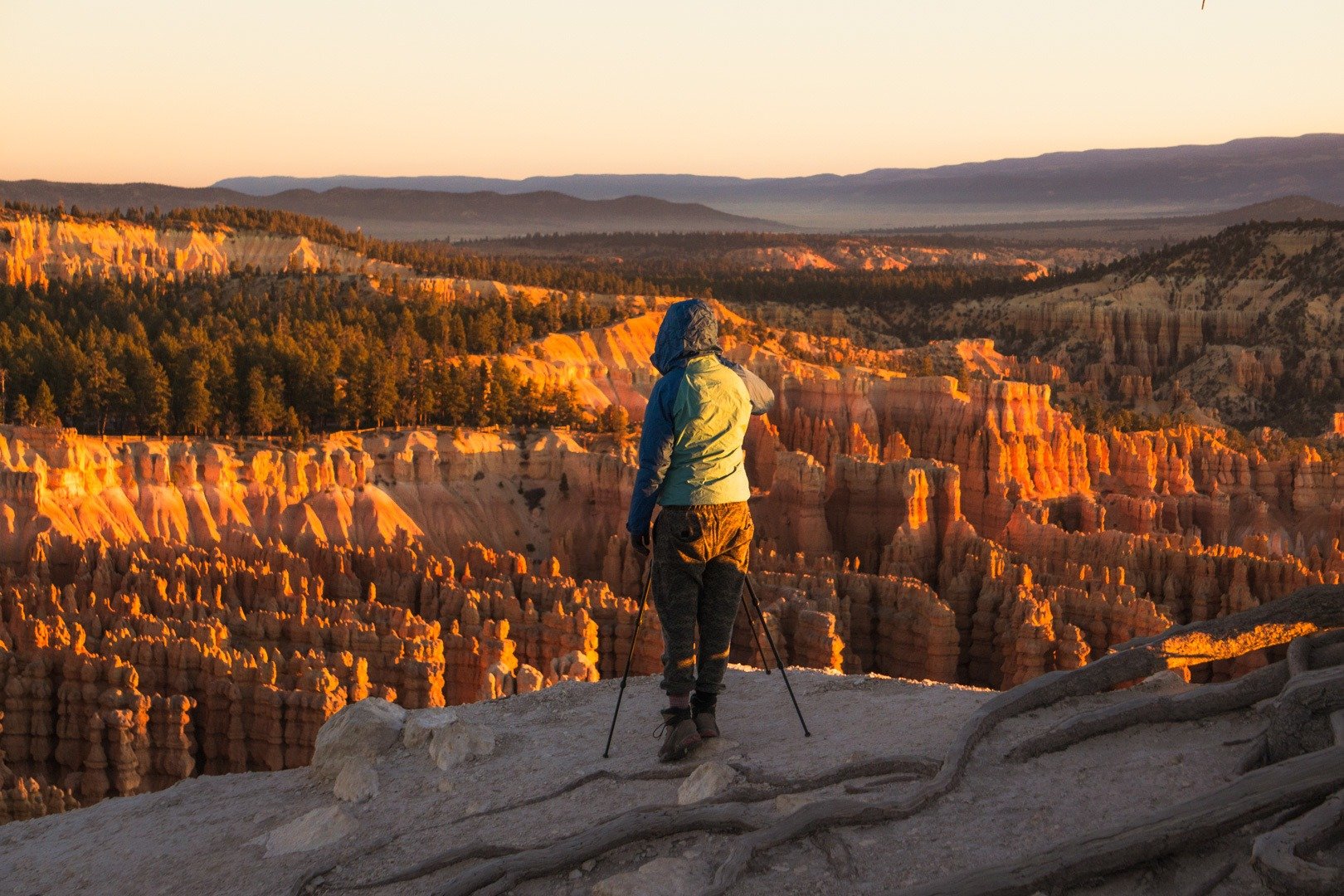
What to Eat and Drink
I never came close to experiencing all that the northern Utah dining scene has to offer but I tried to at least get a feel for it. From home-cooked fare to inventive and diverse international offerings, I was really impressed by what I ate during my time here. Here is a selection of the culinary highlights of my backpacking trip to northern Utah.
Where to Eat in Salt Lake City
Lion House Pantry Restaurant – Cafeteria style Restaurant serving homestyle fare located next to Temple Square, is housed in the former residence of the second leader of the Church of Jesus Christ of the Latter Day Saints – Brigham Young. They have daily specials – we tried the artichoke chicken with mashed potatoes which was delicious – and all meals come with a free house-made roll, best spread with Utah’s famous honey butter.
JDawgs – Simple but lovingly made hot dogs can be found at Utah institution, JDawgs. They are said to be the best in Utah and are cheap to boot. Perfect for a quick meal.
Spitz – Mediterranean street food with a focus on doner kebabs, Spitz is a cheap and tasty destination for lunch or dinner in downtown Salt Lake City.
Jackalope Lounge – Salt Lake City doesn’t have a lot of nightlife, but if you are looking for a few local beers in a friendly but simple dive bar, Jackalope Lounge will do the trick. We went in the early evening and it was pretty quiet but I have heard it gets pretty busy later on.
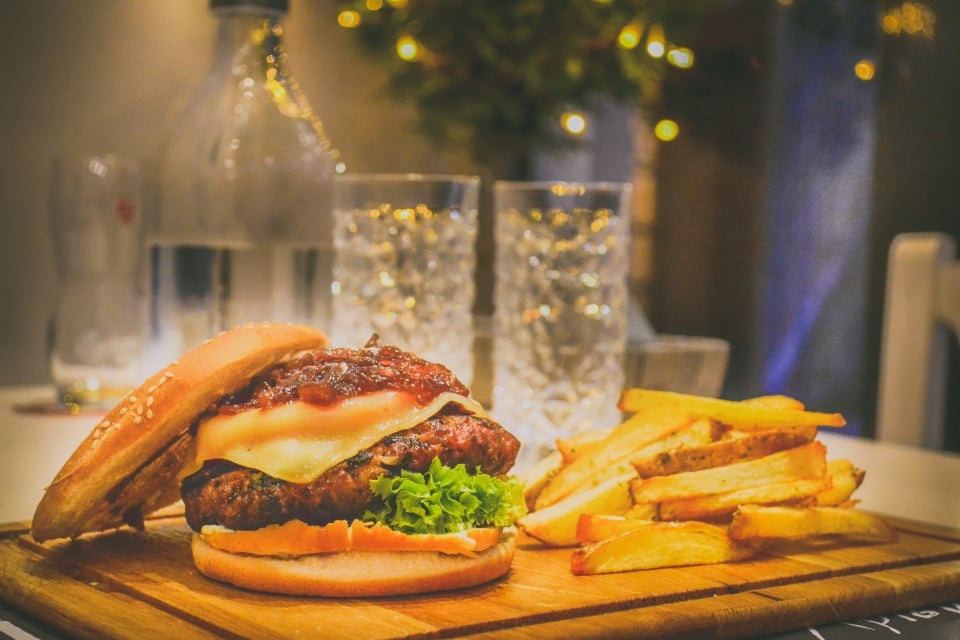
Where to Eat in Logan
Caffe Ibis – Located on funky Federal Ave, Caffe Ibis didn’t have a table free when we went past. This bustling cafe prides itself on their coffee, which they roast onsite. The food menu also looked delicious, with inventive salads and sandwiches with a big focus on fresh seasonal, local and organic food.
Bluebird Restaurant – Founded in 1914, this genteel restaurant with an old-fashioned atmosphere offers sit down dining with classic dishes at very affordable prices. I was so impressed with my Bluebird chicken which came in a sweet and spicy sauce and was served with perfect mashed potatoes and gravy. Their locally made pie is also definitely worth saving room for. A must visit while backpacking northern Utah.

Where to Eat in Ogden
World Famous Pho Noodle House and Grill – Quite a claim and I doubt it is actually world famous but the Pho Ga here is pretty damn awesome. I had been craving a good Pho and this place delivered.
Two-Bit Street Cafe – Fresh home-cooked food surrounded by old-timey decor, I loved their two-bit bleu chips – thick cut potato chips smothered in mornay sauce and chunks of blue cheese.
Roosters Brewing Company and Restaurant – Unlike in Colorado, Brew Pubs and Restaurants are not a dime a dozen in Utah due to it’s super strict liquor laws. Roosters was actually the only one I went to during my time in northern Utah, luckily the beer and food were both great. Sitting on their sunny front patio made the experience even better.
Lighthouse Lounge – We dropped into this dive bar on historic 25th street for a few afternoon beverages and they have a great selection of craft beer on tap including the awesome huckleberry cream ale from Laughing Dog Brewing in Idaho. Lots of local choices too.
Where to Eat in Park City
Main Street Deli – We only had a coffee here but this little Deli, a Park City mainstay since 1977, has a buzzing atmosphere and the breakfast menu looked awesome.
Peace, Love and Little Donuts – With a eclectic selection of small donuts on offer, I was one very happy donut lover when I found this place. LOVED the strawberry french toast and maple bacon donuts but I could have easily eaten any of the beautifully displayed treats.
501 on Main – Lunch on the sun-drenched patio of 501 on Main, watching Park City life go by is one of my favourite memories of visiting this mountain town. It was hard to choose from their inventive menu but I ended up going with the lobster bisque with a side salad of beets with apricots and gorgonzola. Absolutely no regrets.
O’Shucks Bar and Grill – I didn’t get a chance to visit myself but my boyfriend’s brother lived in Park City for a while and he heartily recommends O’Shucks for a fun night out. They offer great food and drink deals from Mondays through to Wednesdays including $3 beers and wines and $3 burgers. There is also a location in SLC.
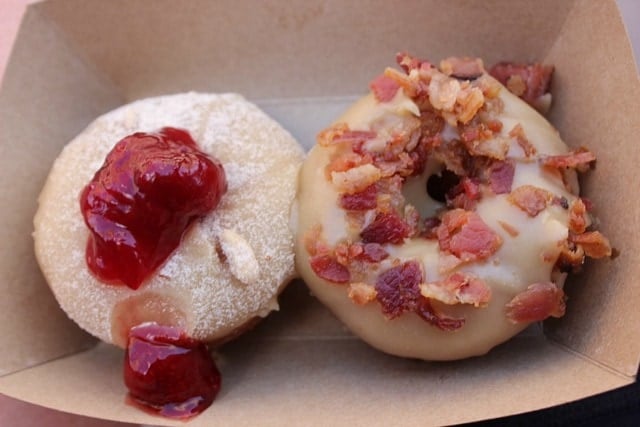
Being a Responsible Backpacker in Utah
Reduce your plastic footprint: Perhaps the best thing you can do for our planet is to make sure you do NOT add to the plastic problem all over the world. Don’t buy one-use water bottles, the plastic ends up in landfill or in the ocean. Instead, pack a tough travel water bottle .
Go and watch A Plastic Ocean on Netflix – it’ll change how you view the plastic problem in the world; you need to understand what we are up against. If you think it doesn’t matter, get off my fucking site.
Don’t pick up single-use plastic bags, you’re a backpacker – take your daypack if you need to go to the shop or run errands.
Bear in mind, that many animal products in countries you travel through will not be ethically farmed and won’t be of the highest quality. I’m a carnivore but when I’m on the road, I only eat chicken. Mass-farming of cows etc leads to the rainforest being cut down – which is a huge problem.
Need more guidance? – Check out our post on how to be a responsible backpacker.
Utah is full of beautiful places. Some of my favorite national parks in the USA are in Utah. They’re incredible! Do your part to help preserve their splendor for future generations.
I know it can be hard, but do your best to use the least amount of plastic water bottles that you can. Refill the ones that you do buy! Use a Grayl Geopress. Refill at your hostel! There are plenty of ways to reduce plastic!!!
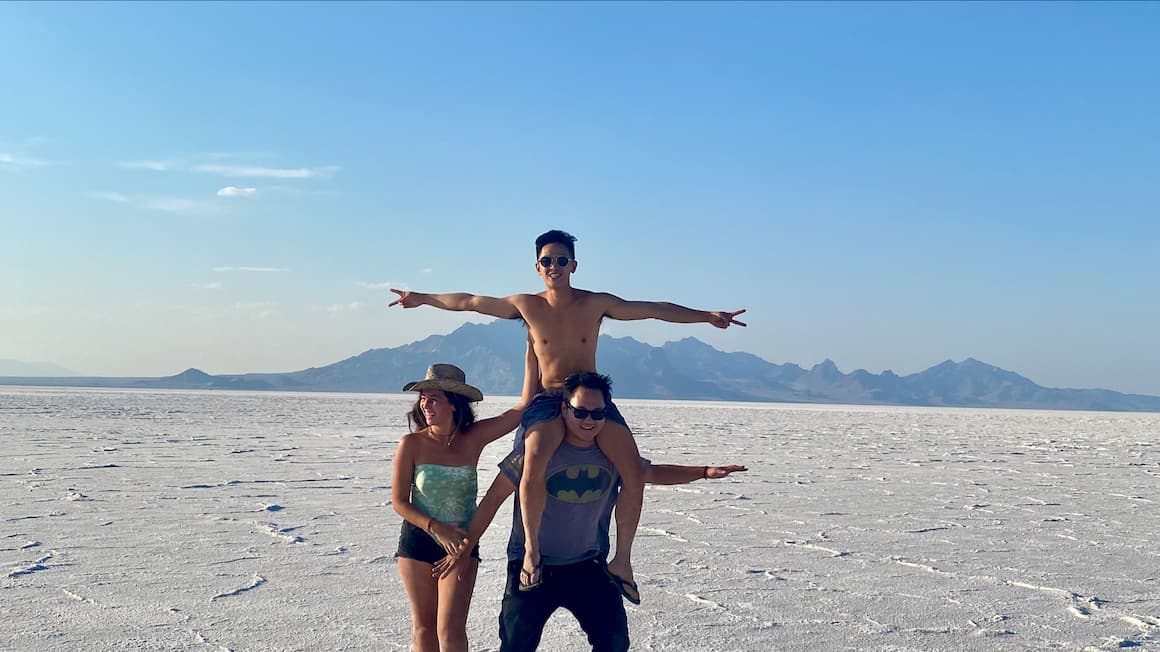
About the Author
A self-professed crazy cat lady and world traveler, Katie is originally from New Zealand but has been living abroad and traveling the world for over 12 years. She is currently based between the US and New Zealand, where she is learning the ropes to this digital nomad thing and trying to see more of this wonderful world we live in.

Guest Poster
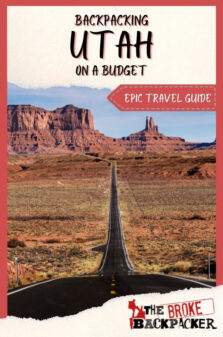
Share or save this post

Great Post! I am currently in western Colorado and just checked out Moab for the first time a few weeks ago. Arches and Canyonlands blew me away. Happy I found your blog!
Leave a Reply Cancel reply
Your email address will not be published. Required fields are marked *
Save my name, email, and website in this browser for the next time I comment.
Notify me of followup comments via e-mail.
The Top 5 Beginner Backpacking Trips Near Salt Lake City
Salt Lake City's immediate access to the backcountry is unbeatable.
By: The Outbound Collective + Save to a List
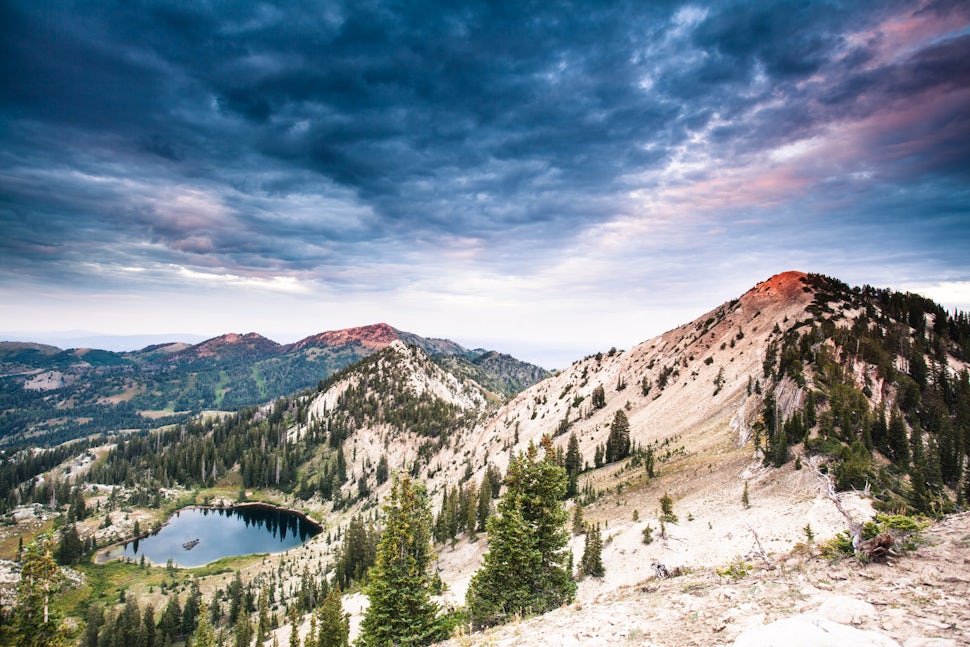
The Wasatch Mountains provide all adventurers in Salt Lake City with immediate access to hundreds of trails leading to amazing destinations. With such close proximity to the city, it's to be expected that the trailheads might be a bit packed on the weekends, but the vast majority of hikers in the Wasatch Range return to their cars before the sun goes down. That’s good news for those of you who love to backpack or want to give it your first try. These backpacking trips are perfect introductions, whether you’re looking to dip your toe in the backcountry with a short hike in or dive right in for a bit of a challenge.
1. Camp at Willow Lake

2. Backpack to Lake Catherine and Bag Sunset Peak

3. Backpack to Silver Lake

4. Backpack to Red Pine Lake

5. Backpack to Rudy’s Flat

Get more information on these trails and others around Utah at Utah.com .
Cover photo: Lindsay Daniels
Don't see your favorite adventure on The Outbound? Show us by creating an adventure.
We want to acknowledge and thank the past, present, and future generations of all Native Nations and Indigenous Peoples whose ancestral lands we travel, explore, and play on. Always practice Leave No Trace ethics on your adventures and follow local regulations. Please explore responsibly!
Do you love the outdoors?
Yep, us too. That's why we send you the best local adventures, stories, and expert advice, right to your inbox.

The Best Hikes to Find Wildflowers near Salt Lake City
Rebecca Stubbs
In July and August the wildflowers go crazy in the Wasatch mountains! I have assembled a list of my favorite places to see them.

The Great Salt Lake: Better Than It Smells
Tylyn Hansen
And much more important.

The Top 5 Spots For Fall Leaves Near Salt Lake City
Lindsay Daniels
It’s like this season was God’s gift to hikers.

10 Must-Do Hikes Near Salt Lake City
The Outbound Collective
Explore the endless trails along the Wasatch Front.

5 Amazing Camping Spots Near Salt Lake City
Escape the city and find some peace and quiet.
- Local Adventures
- Tours and trips
- Camping Nearby
- Outbound PRO Membership
- Add your property
Mobile Apps

© 2024 The Outbound Collective - Terms of Use - Privacy Policy

IMAGES
VIDEO
COMMENTS
Distance: 7 miles. Elevation Gain: 2,720 feet. Difficulty: Hard. Lake Blanche has been a popular destination for backpackers in Utah since the 19th century. It's hard to say what's more beautiful — the trio of Lake Blanche, Lake Florence, and Lake Lillian, or the imposing Sundial Peak that dominates the skyline.
3. Mount Timpanogos. AREA: Utah Valley | Provo or American Fork Canyon LENGTH: From Aspen Grove to Summit: 8 miles one way, Camp: ¾ way to Emerald Lake (6.5 miles to the lake) | From Timpooneke Road: Summit: 7.5 miles one way, Camp: just as you enter the basin at about 10,000 feet ELEVATION GAIN: 4,580 feet DIFFICULTY: Strenuous.
What to Wear Hiking in the Desert. Sun Protection for Hikers. A Desert Hikers Guide to Cryptobiotic Soil. 3. Lower Hackberry Canyon. Location: Grand Staircase-Escalante National Monument. Trail Type: Out and Back. Distance: 12.4 miles. Suggested Time: 2 days, 1 night.
3. Backpack and Camp at Ibantik Lake. Photo: Colton Marsala. At just five miles round trip and 1000 ft. elevation gain, this is a great trip for those without a ton of hiking or backpacking experience. It's a beginner hike with advanced scenery: watch for mountain goats, alpine lakes, meadows and other beautiful views.
Kings Peak. The most famous backpacking trip in the Uintas, King's Peak is the highest point in Utah at 13,512 feet. The 32 miles is best done in a three-day backpack that requires you to gain 4,200 feet along the way. Located in the less-traveled eastern section of the range, this is one of Utah's real bucket-list adventures.
Hikers on AllTrails.com recommend several popular national parks in Utah. Bryce Canyon National Park is home to 4 backpacking trails with an average 4.7 star rating from 6,818 community reviews. Canyonlands National Park has 28 backpacking trails with an average 4.6 star rating from 4,974 community reviews.
The longest backpacking trails in Utah include the Highline Trail (78 miles), Hayduke Trail (800 miles), Great Western Trail (~1,600 miles), and Uinta Highline Trail (~104 miles). These long-distance routes offer diverse landscapes and challenges for experienced hikers seeking extended adventures. VisitUtah provides more information on these ...
Bryce Canyon sits at a higher elevation (Rainbow Point is around 9000′) than many other desert destinations, so this backpacking trip is best done from May through September. In the early and late seasons, the trail can be covered in snow. However, in the heat of the summer, water sources become more unreliable. 4.
Best Beginner Backpacking Trips; Private Hiking Tours; National Park Hiking Tours; Unforgettable Experiences. View New Trips. Destinations. USA Hiking Vacations. ... The night skies on a Utah backpacking trip are mind-blowing, with the Milky Way clearer and more vibrant than many people have ever seen. There's something magical about hiking ...
While there are endless backpacking opportunities in Utah, here are some of the best overnight backpacking trails in the state that you must explore. 1. Neon Canyon and Golden Cathedral. Located in the Grand Staircase-Escalante area, the length of this backpacking trail in Utah is 9.2 miles. The elevation gain here is 1260 feet, and the ...
Canyonlands National Park is one of Utah's Mighty Five, but even though this national park is popular, it doesn't (yet) have the crowds of Zion or the lines of Arches. That's because this park, which spans 257,640 acres, gets fewer total visitors to Utah's other favorite spots. In 2019, Zion recorded 4,488,268 visitors and Arches ...
Coyote Gulch Loop. Located in the Glen Canyon Rec Area, this short 13.5-mile trip is great for a quick overnight. This trail features towering rock faces and even a small waterfall, an unusual find in the desert. Other features include Coyote Natural Bridge, Crack in the Wall, and Jacob Hamblin Arch.
Distance: 14.2 miles (shuttle) Elevation gain: 1,748 feet. Difficulty: challenging. Without a doubt, the most popular and famous backpacking trail in Zion is the West Rim Trail. It follows along Zion's incredible and majestic West Rim before it drops into Zion Canyon, so its popularity is understandable.
If you can push yourself through these adventures, you'll be rewarded with an unforgettable experience. Most of these backpacking trips cover 20+ miles of this stunning terrain, so if you're up for a challenge, read on and start making your plans. 1. Backpack the Trans-Zion Trek. Photo: Mike Quine. 2. Backpack Reflection Canyon. Photo: Kathleen ...
The Utah backcountry is among the most exciting and primeval landscapes on Earth! Please note that our Utah hiking trips may fill up quickly, and we take reservations on a first-come, first-served basis. So don't miss out! To reserve your space, call 406-823-0337.
2 The Best Backpacking Trips in the Uintas. 2.1 Yellow Pine Trail. 2.2 Backpacking to Gilbert Lake & Peak. 2.3 Backpacking to Red Castle Lakes. 2.4 Backpacking to Dead Horse Lake. 2.5 Backpacking to Allsop Lake. 2.6 Backpacking to Priord Lake. 2.7 Backpacking to Amethyst Lake. 2.8 Backpacking to Rock Creek Basin.
Canyonlands National Park. Length: 10.1 mi. Descends into canyon, crosses Murphy's Hogback to White Rim Road, then returns via Murphy Wash. Hard • 4.4 (139) #3 - Mount Peale Trail. Manti-La Sal National Forest. Length: 5.1 mi. This route takes you on an off-trail scramble to the summit of Mount Peale.
Looking for the best backpacking in Moab? We've got you covered with the top trails, trips, hiking, backpacking, camping and more around Moab. The detailed guides, photos, and reviews are all submitted by the Outbound community. ... itself. Set out pre-dawn from Moab, UT and head 77 miles south and west to the Needles District Visitors Centre ...
1. The Big Needles Loop (Canyonlands National Park, Needles District): 23.2 miles. A major backpacking trip covering most of the outstanding features of the Needles District of Canyonlands National Park. 2. Harvest Scene (Canyonlands National Park, Maze District): 8.7 miles. This trail is not only a rare loop (most Maze trails are out and back ...
Check out these overnight backpack trails in Utah that you need to explore on your next campout. ... Hiking & Backpacking. Horseback Riding. Mountain Biking. River Rafting. Rock Climbing ... Group Travel. Transportation. Weather. Email Signup. Printable Road Trip Activity Book For Kids. See All. Scenic Drives. Fall Colors Scenic Drives. Alpine ...
Total elevation gain is approximately 1,500 feet with numerous climbs and descents along the way. Six campsites mark the trail Right Fork Yellow Creek, Yellow Creek, Sheep Creek, Right Fork Swamp ...
Even if you aren't even remotely religious, a visit to the Mormon stronghold of Salt Lake City is a must-do while backpacking Northern Utah. The city offers beautiful architecture, a riverside walking trail, and a beautiful Temple Square. The 35 acres of historic buildings are going to take you back in time.
5. Backpack to Rudy's Flat. With beautiful sweeping mountain views and the convenience of established backcountry fire pits, the trip to Rudy's Flat is rugged yet convenient. Another slightly longer hike 7 miles round trip and 2,160 ft elevation gain, this trip is good for a beginner who's up for for challenge.